- Travel Planning Guide

Europe Travel Cost Rankings
- Travel Budgets
- Country Travel Cost Rankings
- Cheapest Cities
- Country Budget Comparisons
What are the cheapest and most expensive countries to visit in Europe?
The following travel cost rankings for countries in Europe are calculated based on the travel budgets of real travelers. Also referred to as a Travel Cost Index , or a Backpacker Index , the countries below are in order from most to least expensive by their average daily travel price, per person, per day
- 1 Switzerland € 266.00
- 2 France € 233.73
- 3 Liechtenstein € 231.69
- 4 Iceland € 190.78
- 5 Luxembourg € 183.97
- 6 Denmark € 179.50
- 7 Netherlands € 175.49
- 8 Italy € 166.54
- 9 Andorra € 164.38
- 10 United Kingdom € 162.65
- 11 Finland € 157.09
- 12 Austria € 150.91
- 13 Spain € 150.06
- 14 Ireland € 142.95
- 15 Belgium € 142.20
- 16 Portugal € 136.31
- 17 Sweden € 128.73
- 18 Slovakia € 126.32
- 19 Turkey € 122.06
- 20 Malta € 117.43
- 21 Latvia € 113.66
- 22 Montenegro € 104.13
- 23 Czech Republic € 103.17
- 24 Estonia € 101.94
- 25 Cyprus € 98.96
- 26 Croatia € 94.57
- 27 Slovenia € 93.30
- 28 Lithuania € 91.97
- 29 Romania € 76.95
- 30 Albania € 74.55
- 31 Bosnia and Herzegowina € 68.44
- 32 Bulgaria € 64.07
- 33 Belarus € 62.45
- 34 Russia € 60.69
- 35 Poland € 59.70
- 36 Serbia € 36.54
- 37 Georgia € 30.75
- 38 Armenia € 27.38
- 39 Ukraine € 23.02
- 40 Azerbaijan € 0.00
The Cheapest Cities for Other Regions
Country rankings for other regions, what are the cheapest countries to visit in europe.
The least expensive countries for travel in Europe are currently Azerbaijan (€0.00), Ukraine (€23.02), Armenia (€27.38), Georgia (€30.75), Serbia (€36.54), Poland (€59.70), Russia (€60.69), Belarus (€62.45), Bulgaria (€64.07), and Bosnia and Herzegowina (€68.44).
What are the most expensive countries to visit in Europe?
The most expensive countries for travel in Europe are currently Switzerland (€266.00), France (€233.73), Liechtenstein (€231.69), Iceland (€190.78), Luxembourg (€183.97), Denmark (€179.50), Netherlands (€175.49), Italy (€166.54), Andorra (€164.38), and United Kingdom (€162.65).
Affordable Travel in Europe
Subscribe to our newsletter.
By signing up for our email newsletter, you will receive occasional updates from us with sales and discounts from major travel companies , plus tips and advice from experienced budget travelers!

Pin This Page

- Privacy / Terms of Use
- Activities, Day Trips, Things To Do, and Excursions
The cost of traveling Europe: real budget numbers from 9+ years of travel

What is the real cost of traveling Europe?
How do you afford to do it full-time?
How much do I need to save if I want to travel in Europe for a year (or two years or a month or six months)?
As someone who has been traveling full time for nearly nine years, most of that time in Europe, these are probably the questions I get most often about my lifestyle.
Money, unsurprisingly, is the biggest obstacle people think they’ll face on the road. Because if vacations are so pricey, wouldn’t full-time travel be even more so?
(Psst. Here’s a full breakdown of why it’s not .)
This is why for the last 10+ years, while I’ve been traveling full-time, I’ve kept track of my budgets all over the world. Because the truth is that full-time travel can be expensive (just like staying put can be expensive), but it doesn’t have to be . And the only way I know to prove it is to share my own real budgets.
Today, I’m back to share more budget updates with you. More insights into how I travel full-time and what it costs to live and travel in Europe.
First, though, let’s talk about travel styles…

What full-time travel looks like for me
First, it’s important to say that there’s no right or wrong way to travel full time . There’s no standard. Every person I know who does it does it differently .
I have friends who circle back to their favorite places every single year. I have friends who are always chasing new adventures. I’ve met digital nomads who live out of hostels and move every few days and nomads who spend a year or more in one place.
So, before I dive into how I travel, I’ll caveat it by saying that my way is not the way . There are people who travel on a much lower budget than mine and people who travel on a higher budget than mine. There are people who travel faster and people who travel slower. This budget breakdown is based on my experiences and my experiences alone.
Okay, so what are my experiences ?

For the first few years, I traveled solo with my dog . For five years, I traveled as part of a couple (though my budgets here on the blog reflect my half of shared expenses + 100% of my personal expenses). And now I’m back to solo-girl-with-dog-takes-on-the-world. ( Here’s a comparison of costs solo vs. traveling with someone else .)
I mostly travel around Europe, though I’ve also done a bit of North and South America in the past few years (and before I hit the road full-time, I visited every continent except Antarctica).
I prefer to stay in one place for at least a month (and sometimes two or three) and I tend to rent comfortable apartments in local neighborhoods. If I’m staying in a hotel or hostel, it’s usually only for a weekend trip or a travel day.
I’m a foodie through and through, so I devote a large portion of my budget to good, fresh, usually organic food and I eat out pretty regularly, especially if I’m in a place known for its cuisine.
I work part-time (on writing books , content strategy and copywriting ). This means big chunks of my week are devoted to work, so someone retired or vacationing is likely to spend quite a bit more than I do.
And in my spare time, I love to cycle, hike, read, explore, and eat, most of which is cheap or free and keeps entertainment budgets on the low side. I rarely do museums or indoor attractions.

The cost of traveling Europe: monthly expense breakdown
Before we get into individual budgets around the world, here’s a breakdown of my general monthly expenses and how I approach them:
Housing : This was my biggest expense in the US, and it’s my biggest expense now. From 2012 to 2015, when I was traveling solo, I spent about $1,000 per month. In 2015 to 2021, my partner and I split the rent, so we could afford a nicer space and usually keep our individual spending on the lower side. I shot for under $800 per person per month and we often came in under $600 each. Now, solo again and with accommodation prices having risen over the years, I’m upping my housing budget to $1,500. I’ll still try to come in under when I can, but that’s my new ceiling.
So, what’s the secret to affordable accommodations while traveling in Europe? Traveling slow. Monthly rental costs are significantly lower than nightly or weekly rentals. On sites like Flatio and Airbnb, monthly discounts run anywhere from 20% – 70% .
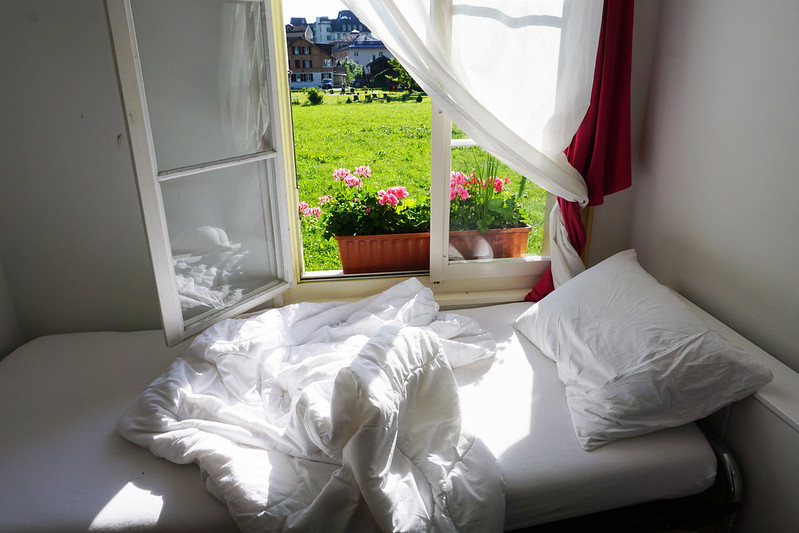
Food: Perhaps unsurprisingly, this foodie’s second highest expense is meals. I track my spending on groceries separately from my spending on eating out. I don’t put a budget ceiling on groceries because eating fresh, high-quality food is really important to me and I’d rather spend a bit more on groceries (and a bit less on other things) than take shortcuts with my health or joy.
In the states, I shopped at organic grocery stores and tried to buy healthier options, which were often a bit pricier. In Europe, I shop at fresh markets, local butchers, and tiny bakeries most of the time and stay away from imports that might have questionable chemicals or ingredients.
I always strive to only buy what I need and to buy it in the best quality, most local form I can. I mostly cook at home instead of eating out and when I do eat out I go for quality over quantity.
Recent grocery budgets have run about $393 ( Zagreb, Croatia ), $614 ( Thun, Switzerland ), $653 ( Bad Ischl, Austria ), and $429 ( Tartu, Estonia ). Eating out budgets in those same locations were around $257 (Zagreb), $0 (Thun), $41 (Bad Ischl), and $88 (Tartu). This means totals for those three places landed at $650 (Zagreb), $614 (Thun), $694 (Bad Ischl), and $517 (Tartu). As you can see, food spending varies, but not enormously. If you read my older budgets, you’ll also notice that the average has gone up over time (which makes sense, because inflation).

Transportation: Since I tend to stay longer in one place, transportation costs generally run pretty reasonable (e.g. far less than I spent when I owned a car). Every month or two, I buy a long-distance train ticket or two, and maybe once or twice a year I take a flight (though I try to fly as little as possible both because I hate flying and I try to be conscious of my environmental footprint).
In between big train journeys, I choose to walk whenever possible (which, in Europe, is nearly always) and only take buses and metros when the weather is walking-prohibitive, if the walk would be more than an hour long, if I’m carrying something heavy, or if I’m in a particularly busy city and the walk would be crowded or stressful.
These days, I spend anywhere from about $25 (Prague unlimited monthly transit pass) on a month where I’m staying put to $300ish (trains from Rennes, France, to Prague, Czech Republic) on a month when I’m moving from one base to another.

Luna the traveling pooch’s food and care: This varies a little from country to country, but rarely exceeds $200 per month. Luna eats a homemade diet primarily consisting of rabbit, fish, quinoa, and veggies (the diet was created with a veterinary nutritionist and if you decide to do the same, I highly recommend hiring one through your vet), and I’m not very strict about separating her food budget from mine, so expect that some of the grocery budget is actually going to Luna.
As with human health care, I’ve found vet care to be significantly more affordable in Europe (compared to the US). In Latvia, four injections, a blood test, two weeks of pancreatic enzyme pills, a vet consult, and an exam cost just over $100. In Dubrovnik, Croatia, in a similar vet emergency, the bill for the sedation, IV fluids, blood work, x-ray, exam, anti-nausea shot, and 100 days worth of pancreas pills was about $150. In the US, the cost would have been at least tripled in each of those cases. A single blood test in Colorado cost us upwards of $200 last time we were there.
Entertainment/fun money: When I’m traveling, most of my activities are free or cheap, so this line item is always pretty small compared to the others.
Supplies: These tend to run less abroad as well, in part because I am careful about what I buy, since I carry everything on my back, and, in part because I’m less bored and thus feel less of a need to shop. The ironic and wonderful thing about this is that the things I buy are often higher quality and more expensive, yet I generally spend less overall than I did in the states.

Health insurance and healthcare : Since I’m currently based in Portugal, I’m relying on the local health system. While traveling more extensively, I previously paid $268 per month for GeoBlue insurance that covered me anywhere in the world except the US. Before that, I tried travel insurance through World Nomads, which I found wildly frustrating (despite marketing themselves to travelers, they require you to jump through a LOT of paperwork hoops that require access to printers, scanners, and copy machines) and IMG Global, who ignored my emails and took months upon months to even acknowledge my claims after I was hospitalized on Malta. I would not recommend either company.
For anyone who’s used a healthcare system abroad, it’ll come as no surprise that pretty much everywhere in cheaper than the US. Pre-Obamacare, I paid $150 for three months of birth control pills in the US. A three-month supply (and a doctor visit to get the prescription) in Germany cost me under $100. In Switzerland, that number dropped to around $50. And in Vietnam, the same pills (same ingredients, different brand name) were $10 and available over the counter.
In all, I try to keep monthly spending under $2,500 (not including my business spending). And even with this as my budget ceiling, I often come in under. A few months ago, I did the math on the 30+ real Europe travel budgets linked below (scroll down for links) and the monthly average came in at $1,637 .

For those who’d like a more detailed look at my monthly budgets around the world, here they all are categorized by price range (click on the links for in-depth details on the budgets):
My real monthly budgets
From cheapest to most expensive monthly budget. Click on each location for a more detailed breakdown.
Non-European locations are marked with an *. My favorite places appear in bold. Cost is in parentheses. And I’ve indicated the year the budget is from (obviously account for some inflation when using budgets from 10 years ago) and whether the budget was solo travel or traveling with a partner/friend (partnered travel typically means lower housing costs).
Under $1350 per month:
Konjic, Bosnia and Herzegovina / one month ($1157) 2017 / partnered
Labin, Croatia / one month ($1175) 2021 / solo
Tartu, Estonia / one month ($1213) 2020 / partnered
Tulum, Mexico / one month ($1232)* 2018 / partnered
Kotor, Montenegro / one month ($1253) 2019 / partnered
Mostar, Bosnia and Herzegovina / one month ($1296) 2017 / partnered
Sayulita, Mexico / one month ($1301)* 2013 / solo
Riga, Latvia / one month ($1313) 2019 / partnered
Split, Croatia / one month ($1317 & $1241) 2019 & 2013 / partnered & solo
Zagreb, Croatia / one month ($1337) 2018 / solo
Playa del Carmen, Mexico / one month ($1350)* 2013 / solo

Under $1,500 per month:
Taormina, Italy / one month ($1364) 2017 / partnered
Porto, Portugal / one month ($1366) 2022 / solo, living full-time here
Kranjska Gora, Slovenia / one month ($1385) 2017 / partnered
Toledo, Spain / one month ($1388) 2015 / solo
Kobarid, Slovenia / one month ($1422) 2015 / solo
Brasov, Romania / one month ($1433) 2018 / partnered
Dubrovnik, Croatia / one month ($1443) 2017 / partnered
Tallinn, Estonia / one month ($1460) 2019 / partnered

Under $1,700 per month:
Interlaken, Switzerland / one month ($1558) 2019 / partnered
Ljubljana, Slovenia / two weeks ($808) 2015 / solo
Bad Ischl, Austria / one month ($1618) 2020 / partnered
Rennes, France / one month ($1648) 2018 / partnered
Nerja, Spain / one month ($1689) 2015 / solo
Edinburgh, Scotland / one month ($1697) 2012 / solo

Under $1,800 per month:
Ljubljana, Slovenia / second stay, one month ($1735) 2017 / partnered
Grenoble, France / one month ($1739) 2018 / partnered
Prague, Czechia / one month ($1752) 2018 / partnered

Under $2,000 per month:
Perugia, Italy / one month ($1882) 2013 / solo
Flagstaff, Arizona / one month ($1893)* 2016 / solo
Rome, Italy / one month ($1911) 2017 / partnered
Chamonix, France / two weeks ($962) 2015 / solo
Vancouver, Canada / one month ($1988)* 2016 / partnered
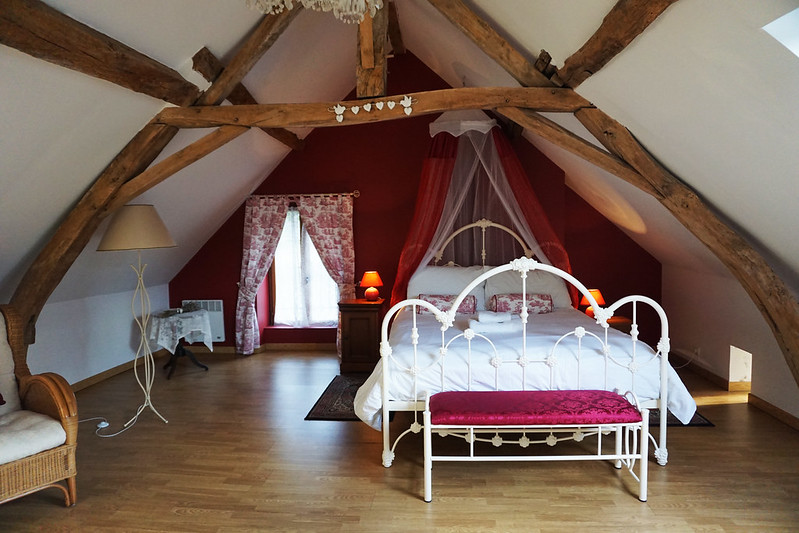
Over $2,000 per month:
Lauterbrunnen, Switzerland / three monthly budgets compared (varies) 2015 (and before) / solo
Amsterdam, Netherlands / two weeks ($1008) 2015 / partnered
Biarritz, France / one month ($2029) 2014 / solo
Innsbruck, Austria / one week ($511) 2018 / solo
Paris, France / one month ($2118) 2013 / solo
Thun, Switzerland / one month ($2124) 2021 / partnered
New York, New York, USA / one month ($2297)* 2018 / partnered
Zagreb, Croatia / one month splurge! ($2320) 2021 / solo
Opatija, Croatia / one month splurge! ($2897) 2021 / solo(ish)
Cycling across France / one month ($3091) 2015 / solo

My budgets for shorter trips
Now, what about short trips? Weekends, overnights, week-long vacations? I’ve got some real budgets on those too, though they’re fewer and farther between for me. Here are they, from cheapest to most expensive per-day:
Vrbovsko, Croatia / 3 days ($87 / $29 per day) 2021 / solo
Plitvice Lakes National Park, Croatia / 3 days ($184 / $62 per day) 2021 / solo
Denver to LA road trip / 2 days ($207 / $103 per day)* 2012 / solo
Tbilisi, Georgia / 10 days ($1050 / $105 per day)* 2019 / partnered
Colmar, France / 5 days ($539 / $108 per day) 2019 / partnered
Paris, France / 5 days ($663 / $133 per day) 2019 / partnered
Emilia Romagna, Italy / 5 days ($776 / $155 per day) 2014 / solo

Business costs
It’s worth noting that you won’t see any business costs in the above budgets. My business expenses vary greatly based on what I’m working on, how much active marketing/sales I’m doing, and what kind of side projects (blogs, self-published books, etc.) I’m taking on.
The few consistent things I pay for business-wise include:
Subscriptions for Microsoft Word, Adobe Photoshop, cloud storage, and a media subscription or two.
I now own a cell phone (turns out living full-time in Portugal requires one), but I also need a US number, so I use TextNow on my iPad for US calls/client calls. The basic number is free (because they serve up ads), but I pay a small fee in order to get a few extra benefits.
Business insurance , which runs me about $50 per month, and a yearly fee (about $100) for my registered agent to handle my LLC renewal and receive any business mail for me.
Once a year or once every few years, I also have expenses for web hosting and domain renewal for the website. This usually costs me less than $100 per year.

Taxes: Finally, a note on the most unavoidable of all expenses – taxes. In general (though not in every case), you are expected to pay taxes in the place you reside. If you live in the US, you pay in the US. If you live in Switzerland, you pay in Switzerland.
If you’re from the US, you’ll always have to file US taxes even if you’re a resident abroad, but you may be eligible for the FEIE , which is basically there to prevent you from paying double taxes. (Rather than get into it further here, I’ll suggest you book a consult with a US tax accountant. Many do free first consults and they will know so much more than I do about all the ins and outs of your particular situation.)
NOTE: If you’re paying in the states and self-employed, taxes are due quarterly, not yearly. This means when I’m paying in the States, I sit down every quarter and calculate the taxes I owe and send the government a check. At the end of the year, I hire a tax whiz (which generally runs me another $350 – $500) to help me make sure everything has been paid and filed properly.

Air travel expenses (& other big one-time costs)
There are a few things I don’t budget for monthly (or include in my monthly budget posts) because they are yearly or quarterly expenses and may vary greatly from month to month. One of these things is plane tickets .
I’m not a traveler who flies a lot, preferring to explore one continent thoroughly at a time and take trains where possible both because it’s simply a more pleasant way to travel, because it’s more environmentally responsible, and because the older I get the worse my motion-sickness gets, so flying has stopped being even a little bit fun.
So, since I’m not buying them monthly or even bi-monthly, I usually don’t track plane ticket costs monthly and instead factor them into my budget on a quarterly or yearly basis.
In 2021, I took four flights (one-way Switzerland to Croatia, one-way Croatia to Portugal, then round-trip Portugal – Croatia to collect my visa). In 2022, I only took one (one-way from Paris to Porto – I took trains in the other direction).
Replacing technology (my laptop or tablet), big one-time medical expenses, and other large one-time purchases (like my folding bike) are also something I look at quarterly or annually rather than monthly.

Saving money while traveling full-time
Finally, for me, part of feeling comfortable starting my business and then, a year or so later, leaving to travel full-time was having a decent financial buffer in the bank. I was advised while starting my business to have at least six months worth of expenses in the bank just in case. Being a bit neurotic about money, I waited until I had 10 months and enough clients that I was already almost breaking even.
Similarly, when I started traveling, even though I would be working normally and hopefully earning normally, part of feeling comfortable was the knowledge that I had a buffer. If all my clients ditched me in month one, I could live for a year without income (assuming I lived relatively frugally).

Everyone operates differently on this. When my aunt started her business, she quickly went into debt. Yet she was wildly successful over time. I’ve also heard stories of those who moved to a cheap part of Asia to start their business, which meant the limited funds they had could last them much longer while they got things off the ground. I know one man who told me it’s going to take $150,000 to start his business. Another woman told me a success story that started with just 3,000 euros in the bank. An old roommate told me she’s been traveling and working for years with just a few hundred euros to her name.
My income is variable , but I also try to set aside a decent percentage each month for the future –both to tackle unexpected expenses or emergencies, to be prepared for my yearly tax bills, and, of course, to create more security for myself in case I ever cannot or no longer want to work.

Any expenses you tend to have during travel that I haven’t mentioned? Any questions about travel expenses and budgeting? Toss them in the comments.
Share this post!
You may also like
How much does it a cost to spend a month in labin, croatia (istria), how much does it cost to spend a month in brasov, romania, how much does it cost to spend a month in vancouver, how much do digital nomads spend per month, how much does it cost to spend a month in bad ischl, austria, how much does it cost to spend a month in ljubljana, slovenia, leave a comment cancel reply.
Save my name, email, and website in this browser for the next time I comment.
17 comments
This is so cool. Thank you for this.
I’m living in a tiny house on a farm right now, but after my kid graduates high school I – or perhaps both of us – have considered living like this for a while. I’m building up my author/editor business, and it certainly would be nice to get around. I get really restless staying in one spot too long.
Glad you enjoyed it! And good luck!
Idnloke to know more about working abroad
If you are looking for info on my freelance career, here’s the skinny: https://gigigriffis.com/how-i-make-money-while-traveling-the-world-full-time-behind-the-scenes-with-a-location-independent-writer/
If you are looking for info on jobs abroad, I’m sorry to say I don’t have much info on that.
I’m not brave enough to try this with my husband and two kids, but I loved reading about how you do it! Kudos!!
Thanks for sharing your experience! This gives us an idea of how to budget for travel in Europe.
I am really enjoying following your adventures. I am waiting for a Portuguese residency permit and will be dipping my toe in the nomadic water soon. One question I am grappling with – what do you do for health insurance when you are back in the US?
For short trips, I get a temporary travel insurance plan (something like World Nomads even though their paperwork hassles are epic). But I think many European health plans also cover emergencies outside Europe, so might be worth looking into whether your Portuguese insurance will cover you once you’re resident there (I know in Switzerland the insurance we looked at covers US travel).
Amazing post!! Thanks for the detailed breakdowns. So happy to have found your site – it’s SO helpful and informative for slow travelers.
Great post! Thanks for sharing these insights with everyone. I wonder if you might answer a tax question. If one were to travel 1-3 months in each country, does that mean you need to file taxes in each of those countries plus the US?? I get if one were in the same country for over 6mo then that country would probably be considered the country of residence for tax filing purposes but what about when hoping county to county, never staying in any one country longer than 3mo??
Thanks in advance for any insights on my tax question!
Most countries don’t consider you a tax resident until you’ve been there more than 180 days in a year. Most tax accountants will do a free consult if you would like a professional perspective on your specific situation, though!
i’m a new dog owner (about 9 months) and also planning for a 6-month travel sabbatical in about 1.5 years. i’m still debating whether i should take my yoshi with me (he’s a 13 lb chiwienie). I’ve never flown with him before, and I’m wondering if you have any tips and tricks to help ease him into the process? you’re an inspiration!
Thanks! If you haven’t already, I’d read the Luna the traveling pooch section of the blog. https://gigigriffis.com/category/luna/ . There’s tons of stuff in there. The short answer is lots of treats and comfort toys inside the carrier (with the carrier open) in your house to get him used to and feeling safe in the carrier.
Thank you a million times over!
Thanks, Gigi. I needed this. It gives me courage as a single 55 yo American dude. I need some challenge in my life…something to conquer…something that will keep me on my toes. I’ve always suffered from bouts of wanderlust and I’m just plain DONE with corporate health/academic full time work. I did a back-of-the-envelope calculation on my expenses and came out around 2,200/mo traveling mostly in European Union with time in Serbia, Montenegro, B/H, SE Asia, Georgia and Turkey to mitigate the Schengen rules. Any reason you spent so little time in the Balkans? Is it a solo-female traveler thing? Sadly Russia appears off the list. I have spent a fair amount of time there before.
I have savings and a professional license (planning to do consulting over zoom). I plan to work part time (10-12 hours/wk) while honing film photography, reading for pleasure, learning about local history, and making friends. My budget is a bit lighter for accommodations (I don’t mind living in an Airbnb room) and heavier on LOCAL travel. I want to hike and spend time shooting landscapes in the areas I choose. This is a giant question mark in my mind. How to get to these places without a vehicle? I’m a bit reticent about using a scooter and don’t want to spend a fortune on taxi. I’m thinking there might be local bus service that gets me close in many places? Any insights here would be appreciated.
Your style is very much how I view my own journey. Stay in one place 1-2 months to maximize accommodation expenditures, minimize European touristy museums (been there done that—going to 1-2 local gems is my thought), mostly eat at home, and take rail day trips once a month with a night-over. Kudos for avoiding the BIG European cities. That is exactly my plan. I don’ think you could force me to spend time in Paris for more than 3 days, mirroring my aversion to New York, Chicago and LA. Lol.
Once again, thank you for the inspiration! Hit me up on email if you like. If you have any tips on making local friends in the places you traveled, I’m all ears. Stay safe and pleasant travels!
Hey! Glad it’s helpful and good luck!
To your questions:
1) I actually spent quite a lot of time in Croatia (in fact, got a visa for a year after living in Estonia 1.5 years during the whole covid fiasco). The Balkans outside Croatia are a touch trickier because of infrastructure (which goes to your second question, I suppose). There’s less train/bus access, so they are trickier to get to and trickier to get around without a car (and I detest driving). Croatia definitely has better infrastructure than some other spots, though I did enjoy my jaunt into Bosnia and Montenegro.
The other reason is the dog. They tend to be the less dog-friendly options in Europe. I felt fine as a woman traveling solo, but the dog complicates places like Bosnia (which I did spend some time in, despite this) and Albania.
2) The Schengen countries (for the most part, with a few exceptions) have great public transit, so I relied on that. For hiking/wilderness areas, I find that there is transit but it sometimes runs less frequently, so I just had to plan well and sometimes find myself a base very close to the wilderness areas to stay for at least a few days (I did this, for instance, for Bohemian Switzerland in Czechia). Other places (Switzerland, France) often have trails very integrated into every location and/or transit to even the remotest spots.
The places that are a bit more tricky tend to be places on the edges of Europe (the center is very well connected). So I had to get more creative in places like Portugal, Spain, and Estonia, which have somewhat less extensive public transit and more car culture. (Even so, I have never rented a car in any of those places and have relied on everything from infrequent buses to my bicycle to taxis or rideshares.)
Great! Thank you for the insights! I poked around your blog and found solid information on making friends. Funny, having a meal at home with a handful of people is definitely my style. :) I enjoyed many of the images on your blog. Particularly one from Italy with the path going along that turquoise river. Sublime! Excellent information on the hiking trails in different countries and your tip on staying close to trail systems for a handful of days. Lastly, your travels helped me to discover the inclusion of Portugal to the digital nomad parade! That’s particularly exciting to me as my younger brother and fam are planning a permanent move to Portugal (getting tired of Seattle/US health care/foods). Looks like potentially a more lengthy process? What an amazing time to see the world and work from anywhere! New DM visas are also popping up in SE Asia. Cheers!
This website uses cookies to improve your experience. Opt-out here if you wish! Accept Read more
Share on Mastodon
Nomadic Matt's Travel Site
Travel Better, Cheaper, Longer
Europe Travel Guide
Last Updated: April 18, 2024

From beautiful Paris to smoke-filled coffeeshops in Amsterdam, Oktoberfest to La Tomatina, Europe is a massive, diverse continent with an unlimited assortment of things to see and do. You won’t have any problem filling your time, whether you’re backpacking Europe for a few months on a budget or just spending a few weeks there on a well-earned vacation.
The continent boasts wonderful beaches, historical architecture, amazing wine, and tons of world-class festivals. Every country is incredibly different from the next too, providing limitless variety in what you do during your trip.
I first backpacked Europe in 2006 and was hooked immediately. I’ve been visiting every year since, have run tours around the continent, and even wrote a book on traveling in Europe . It’s a destination I love and never get tired of exploring.
This guide will give you an overview of Europe and the tips and tricks you need to start planning your trip. I’ve also written extensive travel guides to each country on the continent (linked below in this post) so you can get more in-depth information for your specific itinerary too!
Table of Contents
- Things to See and Do
- Typical Costs
- Suggested Budget
- Money-Saving Tips
- Where to Stay
- How to Get Around
- How to Stay Safe
- Best Places to Book Your Trip
- Related Blogs on Europe
Click Here for Country Guides
Top 5 things to see and do in europe.

1. Tour the Greek Islands
These islands are the mecca of summer beach fun and each is unique in its own great way. There’s Ios (beach party central with archeological ruins and awesome boat tours); Kos (ancient ruins and nature); Crete (Bronze Age ruins of Knossos, hiking, beaches, and wine), Santorini (iconic blue water, white buildings, and local wineries); Mykonos , (the upscale party island with beautiful beaches, villages, and sunsets), Naxos (best island in the Cyclades). Plus, Milos, Corfu, Lemnos, Zakynthos, and so many more! With hundreds of islands in the country, you can always find what you are looking for!
2. Ride the rails
Europe is famous for its international rail system. Rail passes like the Eurail Pass have been around forever and still make it very easy to get from country to country on a relatively small budget (and with lots of flexibility). Europe has some of the fastest trains in the world that travel up to an incredible 217 mph (350 kph). The whole continent is connected by trains and there’s a growing push for even more connections and long-distance, high-speed trains in order to reduce flying and help combat climate change. There’s nothing more quintessential than riding the trains in Europe and I encourage you to take as many trains as possible. It’s one of the best ways to see the continent.
3. Get lost in Paris
The “City of Lights” is everything people say it is. I fell in love with it the first time I stepped foot in Paris . The city is just magical. You have a ton of museums, cafes, jazz clubs, famous art, and beautiful architecture. I love just strolling around the streets of the Quartier Latin (Latin Quarter) or Montmartre neighborhood as it makes for a breathtaking day. Another one of my favorite things to do here is just sit in the Jardin des Champs-Élysées park and picnic like the Parisians. For something a bit different, check out the famous Catacombs and Paris Sewer Museum. With so much to offer in the way of culture, history, and gastronomy, it would take years to see everything here but you can still get a good feel of the city in a few days.
4. Go city hopping
There are so many amazing cities in Europe that we’d need a top 100 to list them all. Here are some of my personal favorites and must-see cities: London is rich in history, culture, and the famous Big Ben clock; Edinburgh is a vibrant medieval city with cozy pubs and a famous castle with a huge New Year’s Eve Party; Amsterdam has cozy coffee shops and canopied tree-covered canals; Berlin has a wild party scene, street art, and the Berlin Wall; Barcelona has tapas, beach, and unique Gaudi architecture; coastal Lisbon has colorful tiles, old tramcars, cobblestone streets and plenty of fresh seafood; Prague has a beautiful intact Old Town, incredible architecture and eclectic bars; Tallinn Estonia has beautiful medieval buildings with colorful roofs. Florence is a mecca for Italian Renaissance architecture, art history, and gelato; Stockholm mixes medieval architecture and modern art and design. Crisscross the continent, take in the culture, and enjoy all the historic cities!
5. Hit the Alps
Whether you go skiing in the winter or hiking in the summer, the Alps hold some of the most breathtaking views in all the world. You don’t even need to be an expert hiker because there are mountain trails for all levels and crystal-clear Alpine lakes. Check out the spectacular Eibsee trail loop in Bavaria at the foot of Die Zugspitze, Germany’s tallest mountain, for the clearest, multi-colored, sparkling lake you’ve ever seen. Or the Männlichen Kleine Scheidegg Panorama trail in Switzerland’s stunning green and snow-capped Alps. Or visit Italy’s Dolomites in South Tyrol for the scenic Seceda trail. The Alps have trails for every fitness level and in every season.
Other Things to See and Do in Europe
1. tour amsterdam.
I love Amsterdam so much that I lived here for a short period of time in 2006. Here cobblestone and brick streets weave around lovely canals as people ride their bikes to and fro. My favorite things to enjoy here are Amsterdam’s vibrant art and music scene and there are also a ton of interesting museums here like the Anne Frank House, FOAM, the history museum, and the hemp museum. Be sure you get out of the center into Jordaan and Oost with their wonderful outdoor cafes and fewer tourists. Also, a visit to Amsterdam wouldn’t be complete without a canal cruise to visit the many islands and there are many to choose from that include snacks and drinks, sunset cruises, live guided tours, and more.
2. Hang out in Barcelona
Barcelona is a city that goes 24 hours a day, 7 days a week. It truly could give NYC a run for the “city that never sleeps” title. Be prepared for late-night dinners and parties until dawn. Besides a great food and nightlife scene, there is a wonderful beach, tons of Gaudi architecture (including the fairytale-like Parc Güell, as well as the iconic Sagrada Familia , which has been under construction for over 100 years!), incredible food tours, one of the best history museums in the country, and lots of outdoor spaces. What I love about Barcelona is that when you’re ready to chill, you can wander around Parc de la Ciutadella and marvel at the majestic fountains, plant life, and buildings created from an ornate military fortress.
3. Visit Berlin
Hip and trendy Berlin is an energetic destination. It is one of Europe’s most affordable capital cities, with a vibrant music and art scene and a growing foodie movement. Be sure to spend some time learning about the city’s darker history via the many excellent museums, memorials, and landmarks. The East Side Gallery, a section of the Berlin Wall that’s now painted with murals, and the Memorial to the Murdered Jews of Europe are two especially powerful reminders of Germany’s past. For all periods of German history, don’t miss the Deutsches Historisches Museum (German Historical Museum) – it’s one of the best history museums in the world. Once you’ve had your fill of history, relax in Berlin’s many green spaces, from Tempelhof Field, the site of a former airfield and popular local hangout spot, to Tiergarten, a tree-covered former hunting ground for 17th-century aristocrats.
4. Drink beer at Oktoberfest
Oktoberfest is a must for anyone going to Germany at the end of September. While not a budget option since beers now cost 15 € a maß, I love the energy and friendly camaraderie this event inspires. For two weeks, millions of people from all over the world gather for lots of beer, excitement, music, and wild fun. Watching thousands of people sing together, raising quart-sized beer mugs for endless toasts, and enjoying the general party atmosphere makes you feel good about the world. (Or maybe that’s just the beer?) Just be sure to book your accommodation well in advance and be prepared to pay top prices for them. If you don’t have an outfit, don’t worry, there are plenty of shops even at the main train station where you can buy a Bavarian dirndl dress and men’s lederhosen.
5. Experience London
Get a taste of English culture in diverse London . The museums here are some of the best in the world (most are free) and include the Tate, the British Museum, the City Museum, the National Gallery, the Historical Museum. There’s no shortage of iconic sights here as well, with Big Ben, the House of Parliament, the London Eye, the Tower of London, Tower Bridge, and of course, Buckingham Palace. I love London’s diversity because of the countless international eateries with great food and wonderful pub culture, perfect for after a long day seeing the sights. Head to Brick Lane on the weekends for some amazing food and craft markets. I prefer Paris to London, but there is something sophisticated and fun about London. Just watch those pints — London is not a cheap destination!
6. Get outdoors in Scandinavia
My favorite region in Europe is Scandinavia. The quality of life here is high, the people are beautiful and friendly, and the cities are clean and historic. Cycling the cities, taking canal tours, hiking the vast forested areas, archipelago hopping, enjoying fika (a Swedish coffee break), and warming up in saunas are just a few of the popular activities that await you here. True, this area of Europe is not cheap, but there are plenty of ways to reduce your expenses. Don’t let the high prices scare you away. Highlights for me include Copenhagen , Stockholm , Gotland, Norway’s fjords, and Lapland in Finland .
7. Get enchanted in Prague
Prague has an amazing history and is one of the most beautiful and picturesque cities I’ve ever seen. Highlights include the 9th-century Prague Castle, the magnificent Charles Bridge (built in the 14th century and one of the oldest standing bridges in the world), the 10th-century old square with its iconic astronomical clock, and the winding Jewish Quarter. Even if you only have a few days there don’t miss the free walking tour which is one of my favorites in Europe and the best way to learn about the Old Town and the tragic history of the city that went from thriving Bohemian capital of art, music, and literature to part of the Iron Curtain after WWII. Some of my favorite gems here include the fantastic black light theater shows in 4D and the one-of-a-kind medieval dinner show in an old tavern complete with musicians and jugglers not to mention hearty food and drinks. During the weekends it heaves with people enjoying the bars, cheap beer, and delicious food so try to visit during the week (and in the spring or fall) to beat the crowds.
8. Relax on the French Riviera
Here, you can pretend to live the high life for a little bit. Have fun in the sun, relax on the beach, swim in azure blue water, hobnob with the rich and famous, and sail on (or gaze at) gigantic yachts. As for cities, Nice is nice with its palm-tree-lined promenade, old town, and many art museums. If you want to go see how the rich and famous live, spend an afternoon checking out Cannes to soak up some glamorous vibes on La Croisette where they hold the famous Cannes Film Festival. The kingdom of Monaco with its tiny streets, beautiful buildings, and world-famous casino is just a skip away too.
9. Enjoy the great outdoors in Interlaken
Located in the beautiful mountains of Switzerland, Interlaken is a gorgeous place to unwind with fantastic hiking, delicious hot chocolate, and plenty of outdoor sports. The area is full of natural attractions to explore, including the St. Beatus Caves (complete with a legendary dragon), the cascading 500-meter-high (1,640 feet) Giessbach Waterfalls, the Jungfraujoch mountain railway (which leads to the highest train station on the continent), and a plethora of lakes (hence the town’s name). It’s a good alternative to all the cities and museums. Interlaken is also a popular party destination for backpackers and other young travelers. By far, my favorite scenic and visually stunning trail was the Oberberghorn panoramic hike, where you can wander the green mountain ridge ogling the amazing views and the turquoise-blue Brienzersee.
10. Experience history in Rome
In this thriving historical city, you can’t walk two feet without stumbling over a ruin, making Rome a history buff’s dream. Its tiny streets are perfect for wandering as you explore the Colosseum, see the Forum and Palatine Hill, visit the Pantheon, spend time in Vatican City, admire the Spanish Steps, and toss coins into the famous Trevi Fountain. The skip-the-line tickets can definitely be worth it so you don’t waste time waiting outside attractions. Rome also has amazing food (it’s Italy, after all) and nightlife. Visit the Trastevere area for a taste of “local” Rome and chill bars. It’s my favorite area in the city because you feel like you’re in a small village in the middle of a big city.
11. Hike around the Cinque Terre
Cinque Terre is my favorite part of Italy. These five beautiful cliffside towns are perched near warm waters and beautiful olive and grape groves. There are wondrous and strenuous hikes in these hills; for a real challenge, take trail #8. Or just walk the coastline for something less difficult. Many activities here revolve around the coastline: kayaking, swimming, having a beach picnic or visiting the Technical Naval Museum. If you happen to be here in December or January, don’t miss the Nativity Manarola, the world’s biggest lighted nativity scene.
12. Tour Krakow
Krakow looks like it stepped out of a medieval postcard. It’s a hip, trendy, and youthful city that’s the center of education in Poland, meaning there are a lot of university students here. Most travelers come to party here (the vodka is cheap) but try to enjoy the city’s history and food besides just the bars. Walk the Royal Road through the Old Town to the 13th-century Wawel Castle, tour Schindler’s Factory (where Schindler saved over 1,200 Jews during World War II), and visit the sobering Auschwitz-Birkenau concentration camp. You can also take a fascinating day trip to the UNESCO World Heritage Wieliczka Salt Mine, a 13th-century mine with cavernous chambers, statues, chapels, chandeliers, and cathedrals all carved out of salt.
13. Visit the ruin bars in Budapest
The coolest nightlife in all of Europe is found in Budapest . Built in abandoned buildings, ruin bars feature funky art installations, repurposed furniture, and quirky decor. They are amazing, fun, and great places to meet locals, as people of all ages flock here. Open since 2001, Szimpla Kert is the original ruin bar and one of my favorites, along with Instant-Fogas Complex, which takes up an entire building and is actually many different bars in one. Don’t skip the ruin bars — they’re one of the most unique things about the city!
14. Explore Cornwall
The best part of England is outside London, yet unfortunately, not a lot of travelers leave London. Head west to the area of Cornwall for cheaper prices, welcoming locals, natural beauty, great hiking, rolling hills, plenty of medieval castles, and picturesque small towns. If you like biking, the Camel Trail from Bodmin to Padstow is worth the trip and you even pass by a local vineyard. It’s an easy way to spend a day (and it’s pretty flat so it’s not too hard to do.) Plus, I had the best fish and chips in Cornwall! Overall, it’s what you think of as “traditional England.”
15. Walk the Camino
El Camino de Santiago (The Way of Saint James) is an ancient pilgrimage route that stretches from France all the way across northern Spain. It is a 500 mile (800 km) trail that winds through incredible terrain, ending in Santiago de Compostela at the cathedral where St. James is supposedly buried. As a pilgrim, you get a “pilgrim’s passport” which allows you to stay in affordable pilgrim-only hostels, making this a surprisingly budget-friendly adventure. While it usually takes over a month to complete, you can just walk a section if you don’t have the time. To receive a “Compostela” (certificate of completion), you just need to walk the last 62 miles (100 km), which generally takes 4-5 days.
16. Throw tomatoes during La Tomatina
By far my favorite festival, the largest food fight in the world happens during the last Wednesday of August in Bunol, Spain. What started in 1945 as a local brawl has turned into a massive event drawing tens of thousands of people from all over the world. For about an hour, everyone throws tomatoes at each other, leaving streets ankle-deep in tomato juice. Afterward, everyone walks down to the river, cleans off, and then heads to the town square for sangria and music.
17. Find Dracula in Romania
Not a lot of people visit Romania but this underrated country in Eastern Europe has undiscovered yet picturesque medieval towns like Brasov (home to “Dracula’s castle”), Sighisoara, and Sibiu; gorgeous beaches on the Black Sea; and incredible hiking in the Fagaras Mountains — all at dirt-cheap prices. Other major sights include frescoed Byzantine monasteries, the steepled wooden churches of Transylvania, the hip university town Cluj-Napoca, the post-communist capital of Bucharest, and the Danube Delta, a huge nature reserve.
18. Drink whisky in Islay
Whisky has a long history on Islay , an island off Scotland’s west coast. It’s been made there since the 16th-century — first in backyards and then, starting in the 19th-century, in large distilleries. Over the years, whisky from the island came to be considered a specialty and was used to flavor a lot of other blends on the mainland. There are currently nine working distilleries on the island, all located along the island’s shores, with Laphroaig, Ardbeg, and Lagavulin being the most famous. Most distilleries here make single-malt Scotch, meaning that only one type of grain (barley) is used. My visit here was amazing and, even if you don’t like whisky, there are tons of good hikes and walks throughout this magnificent island.
19. Explore Iceland
Iceland is a magical country with majestic waterfalls, hidden hot springs around every corner, and sweeping vistas unlike anywhere else in the world. After my first visit, the country quickly became one of my favorite countries. With whale watching in the summer, the northern lights in the winter, and geothermal baths for soaking in year-round, there really is no bad time to visit! While Iceland’s main draw is the epic natural landscapes, it’s worth spending a couple of days in Reykjavik with its café culture, artsy feel, and brightly colored wooden row houses.
20. Sail the Croatian coast
With calm winds, short distances, a coastline littered with over 1,000 islands, and countless historical sites, Croatia is one of the world’s best sailing destinations. If you can, go during the shoulder season when you can find some great deals. Plan to stay at least a couple of days on one of the islands, with the most popular being Brac, Hvar, Krk, Cres, and Lošinj. However, don’t be afraid to get off the beaten path and explore some of the lesser-known islands such as Silba, Vis, and Lastovo. If you want to splash out and spend a week partying on a yacht, check out The Yacht Week, which hosts week-long parties, complete with DJs, from May-September. You can book a full boat to share with friends or just a cabin if you’re traveling solo. Prices start at 5,250 HRK per person and go up to 9,300 HRK.
21. Explore the Balkans
While the Balkans have become more popular with backpackers in recent years, it’s still largely overlooked by most budget travelers, despite being an extremely budget-friendly region. The Balkan peninsula is home to great (and again, overlooked) wine, beautiful medieval towns like Kotor and Mostar, stunning mountainous landscapes, beautiful pebble beaches, coffee culture, fresh, hearty yet inexpensive food, and museums covering the area’s history, including the most recent turbulent events of the early 1990s. I especially loved my time in Albania . Don’t miss the beautiful beaches in Ksamil, nicknamed the “Maldives of Europe’ as well as the mountain village of Gjirokastër, which was occupied by Romans, Byzantines, and Ottomans. The Balkans have so much to offer for every budget and every country has its unique cultural flavor.
22. Take a wine tour in the Loire Valley
Located in central France, the picturesque Loire Valley is a UNESCO World Heritage site and stretches 280 kilometers (174 miles) along the Loire River. One of the major wine-producing regions of France, the area is home to some of the best wines in the world, with over 1,000 vineyards open to the public. Even those who don’t drink wine will enjoy the beautiful small towns, great food, and the region’s over 300 impressive chateaux. I loved the medieval Chenonceau Castle and Chateau Villandry and the small villages like Saint-Florent-le-Vieil. Spring and Autumn are my favorite times to visit because you can go biking and do outdoor activities when it’s not too hot and there are fewer people. It’s an area not to be missed.
23. See Fado in Portugal
Fado is an important musical tradition in Portugal , originating in Lisbon and stretching back some 200 years. The word “fado” likely stems from the Latin word for fate, and it’s very haunting, poetic, and emotional music. Most of the songs follow themes of loss and mourning, and the music was popular with the working class (especially sailors). Performances normally take place in restaurants during dinner. In Lisbon, head to Clube de Fado, Tasca do Chico, Parreirinha de Alfama, or Senhor Vinho.
24. Tour green Slovenia
Slovenia is one of Europe’s least-visited destinations, which is mind-blowing to me because it’s an amazing place to visit. Slovenia offers all the beauty of Western Europe but at a fraction of the cost and with a fraction of the crowds. Perfect for outdoor adventure lovers, Slovenia offers rugged mountains, untouched landscapes, fantastic ski resorts, plentiful wine, sprawling cave systems, incredible food, and postcard-perfect lakes, such as the famous Lake Bled with its castle on an island. I loved Piran, Slovenia’s often overlooked coastal Venetian-style harbor town that was actually founded 3000 years ago. Stroll around its beautiful windy cobble-stoned streets, beautiful plazas, and take advantage of the many affordable restaurants right on the water. Make sure to also spend a few days in the country’s capital, Ljubljana, known as one of the continent’s greenest and most livable cities. Take a river cruise to see the city and enjoy the friendliness of the locals.
For more information on specific countries in Europe, check out the guides below:
- Albania Travel Guide
- Austria Travel Guide
- Belgium Travel Guide
- Belarus Travel Guide
- Bosnia & Herzegovina Travel Guide
- Bulgaria Travel Guide
- Czechia Travel Guide
- Croatia Travel Guide
- Denmark Travel Guide
- England Travel Guide
- Estonia Travel Guide
- Finland Travel Guide
- France Travel Guide
- Germany Travel Guide
- Greece Travel Guide
- Hungary Travel Guide
- Iceland Travel Guide
- Ireland Travel Guide
- Italy Travel Guide
- Latvia Travel Guide
- Lithuania Travel Guide
- Malta Travel Guide
- Moldova Travel Guide
- Montenegro Travel Guide
- Netherlands Travel Guide
- Norway Travel Guide
- Portugal Travel Guide
- Poland Travel Guide
- Romania Travel Guide
- Scotland Travel Guide
- Slovakia Travel Guide
- Slovenia Travel Guide
- Spain Travel Guide
- Sweden Travel Guide
- Switzerland Travel Guide
- Ukraine Travel Guide
Europe Travel Costs

Accommodation – Accommodation prices vary greatly by region. In Western Europe, hostel dorm rooms cost between 25-45 EUR per night, depending on the room’s size and the popularity of the hostel. I stayed in a 6-bed dorm in Berlin for 20 EUR, while the same one would have cost me around 45 EUR in Paris. A room in Paris costs on the higher end and a room in cheaper Athens costs on the lower end.
In Eastern Europe, hostel dorm rooms cost between 10-15 EUR per night depending on the size of the dorm room and the popularity of the hostel. The further east you go, the cheaper it gets. Expect to pay around 30-60 EUR per night for a private room that sleeps two.
In Scandinavia, hostel dorm beds cost around 25-45 EUR, while private rooms are 65-80 EUR. Budget hotels start around 85 EUR.
Most accommodations offer free linens, free Wi-Fi, and a lot offer free breakfast, but it’s important to check specific websites for exact amenities.
Campsites cost between 10-15 EUR per night for a basic plot for two without electricity.
Food – Food traditions in Europe run deep, stretching back centuries to become integral parts of each country’s culture. From baguettes in France to tapas in Spain, from hearty Eastern European stews and goulash to the fresh vegetables and olive oils of the Mediterranean, European cuisine varies as much as the countries themselves. Food prices differ greatly across the continent, so check individual country guides for specifics.
But no matter where you are, even in the more expensive countries, finding places to eat within your budget is easier than you might think. Throughout Western Europe, you can find small shops, street food stalls, or food trucks where you can get sandwiches, gyros, kebabs, slices of pizza, or sausages for between 3-7 EUR. These shops are most often found in train stations, bus stations, and main pedestrian areas, and offer cheap food alternatives that can have you eating on 12-17 EUR per day. Fast food (think McDonald’s) costs around 7-10 EUR for a combo meal.
Turkish, Middle Eastern, and Vietnamese eateries abound in Germany, while Indian food is incredible and everywhere in the United Kingdom. Meals at these restaurants usually cost between 8-12 EUR.
Restaurant meals in casual, traditional eateries generally cost around 13-25 EUR for a main dish and drink. Food is much cheaper in the east than in the west, and in the west, northern regions like Scandinavia and the UK are more expensive than southern countries like Spain, Portugal, and Italy.
In Eastern Europe, even if you are eating out for all your meals, you can still get by on a food budget of as little as 15 EUR per day.
For drinks, a pint of beer is 2-5 EUR, a glass of wine is 2-7 EUR, a cappuccino is 2-5 EUR, and cocktails range from 6-14 EUR.
If you eat out, do so at lunch and get the prix-fixe menu (two-course or three-course set menu). Restaurants offer this set menu during lunch, and with prices between 10-20 EUR, it’s a way better deal than the regular dinner menu. You can also get affordable lunches at outdoor markets. So many European cities have huge fresh food markets throughout town.
You can cook your own food for around 45-65 EUR per week. This gets you basic staples like rice, pasta, seasonal produce, bread, and some meat. You can save money by shopping at discount supermarkets like Profi, Lidl, Aldi, and Penny Market.
If you want to save big money on meals, head to one of the markets, pick up some cheese, wine, bread, meats, or anything else, and go to the park for a picnic. (Or grab a sandwich for later!) You’ll find the locals doing the same thing, and it’s one of the cheaper ways to get a true taste of local food.
Backpacking Europe Suggested Budgets
Prices for travel in Europe vary greatly depending on how far north, east, south, or west you travel. If you stick to the budget accommodations, food, and tours listed here and use all my tips on saving money, you need about 65-110 EUR per day in Western Europe, 40-50 EUR in Eastern Europe, and about 85-130 EUR in Scandinavia.
Those numbers reflect a traveler who stays in hostels, cooks some meals and eats out cheaply, enjoys a few drinks, and sticks to free and cheap activities like hiking, walking tours, and enjoying nature. This is your typical backpacker budget. You aren’t going to have a fancy time, but you aren’t going to want for anything either.
However, by getting tourist cards and rail passes, avoiding flights, occasionally Couchsurfing or camping, cooking all your meals, and not drinking, you can travel a lot cheaper. On this budget, you could do Western Europe on 35-45 EUR per day, Eastern Europe on 20-25 EUR, and Scandinavia on 50-65 EUR. That would require you to take a train or a bus or hitchhike everywhere, skip most museums, and limit how often you go out.
Generally, the suggested daily budget for Europe is 80-120 EUR. You can use the chart below to get an idea of how much you need to budget daily. Keep in mind these are daily averages – some days you’ll spend more, some days you’ll spend less (you might spend less every day). We just want to give you a general idea of how to make your budget. Prices are in EUR.
Europe Travel Guide: Money-Saving Tips
Individual country guides have more specific information on how to save money in them but here are some general tips on cutting your costs while you explore Europe:
- Picnic – This continent has a lot of little shops where you can buy pre-made sandwiches or ingredients to make your own. Many supermarkets have delis as well where you can get food to go. Buy some food, eat outside, and watch the city and its people go by. It’s a much more enjoyable and cheaper way to eat.
- Eat local and cheap – Not into picnicking? Eat at local sandwich shops, pizza parlors, Maoz, Wok to Walks, and outdoor street vendors. Avoiding restaurants and eating at a lot of the local “grab n’ go” places gives you a taste of the local cuisine at a much cheaper price. If you’re really on a budget, use your creative cooking skills to prepare meals at the hostel as well.
- Stay with a local – Hostels can add up really quickly. If you don’t have any friends with whom you can stay, consider using Couchsurfing , which connects you with locals who let you stay with them for free. Plus, they tend to also have meetups to meet other locals and travelers. It’s a great way to save on accommodation and meet a local who can share their insider tips and advice.
- Camp in a garden – A very good camping service specific to Europe is Campspace , which allows you to pitch a tent in someone’s backyard for free or for a small fee (around 10-20 EUR). All of the garden owners have profiles that tell you what services and facilities they offer. Also, many countries allow wild camping (like Sweden), which can save you a fortune if you have a tent.
- Take the bus – Budget bus companies like Flixbus can take you across the continent for cheap. I personally feel it’s best for day travel as sitting up for an overnight bus isn’t really ideal for sleeping. It isn’t glamorous, but with tickets starting at 5 EUR, you really can’t complain!
- Get a Rail Pass – Eurail Passes have saved me hundreds of dollars. If you are traveling far distances and through many countries, they are a great deal.
- Take the free city tours – One of the great things about Europe is that you can find free walking tours in all the major cities. They can be a great way to see the city attractions, take in some history, and learn your bearings without spending any money. Just make sure to tip your guide at the end!
- Plan accordingly – Plan your trip around Europe so you avoid doubling back. Transportation is a big expense so proper planning can save you a lot of money (and time). Go in a straight line or a loop. Booking your accommodation ahead helps you save as well since cheap, good places unsurprisingly get reserved first. One thing I’ve learned is that waiting until the last minute means you get stuck with expensive places or cheap places no one wants.
- Fly cheap – If you know where you are going and a train won’t do, try to book flights early. You can often get round trip fares for as little as 5 EUR from many of the European discount airlines like Ryanair or Wizz. Many capital cities have smaller airports farther from the city with ‘inconvenient’ times but cheaper fares. Keep in mind you might need to factor in an early morning Uber or taxi if the busses aren’t running and you have an early flight!
- Drink less – Those 5 EUR beers add up. Hit happy hours or pick and choose when you party. Hostel bars are a good place to get cheap drinks or buy your alcohol at the supermarket. Plus, in Europe, it’s legal to drink outside in parks, plazas, by the lakes or rivers. You’ll find you can save a lot of money by not going to bars and clubs. Partying your way across the continent will destroy your bank balance in no time.
- Get a city tourist card – Many local tourism offices sell a tourism card for all their attractions, tours, and restaurants. This card gives you free entry and substantial discounts on all the attractions and tours in a city, free local public transportation (a huge plus), and discounts at a few restaurants and shopping malls. They save a ton of money. If you plan on doing a lot of sightseeing, get one of these cards.
- Rideshare – If you’re flexible in your schedule, use the ridesharing service BlaBlaCar to catch rides with locals between cities (or countries) by paying a small fee. It’s like Airbnb but for rides. I used this service in Switzerland and, not only did I save a lot of money, but I got to meet interesting people and learn about local culture and life. Drivers are verified and it’s perfectly safe, though sometimes rides cancel at the last minute (which is why you need to be flexible). Check their ratings first and try to use rides where the person has done many trips.
- Bring a water bottle – The tap water is safe to drink in most of Europe, so bring a reusable water bottle to save money and reduce your plastic use. LifeStraw is my go-to brand as their bottles have built-in filters to ensure your water is always clean and safe.
- Get a HostelPass – HostelPass is a discount membership for hostels in Europe. Members get 10-20% off select hostels around Europe, as well as perks like free breakfast or free drinks. There are discounts on tours and activities too. It’s a great way to save money if you’re bouncing around Europe as they have hostels in 18 countries around the continent.
Where to Stay in Europe
Europe has a ton of budget accommodation options. The individual country and city guides have tons of recommendations but here’s a short list of some of my favorite budget hostels and hotels around Europe:
- The Flying Pig (Amsterdam, The Netherlands)
- Hotel 54 (Barcelona, Spain)
- Generator Hostel (Copenhagen, Denmark)
- Harcourt Hotel (Dublin, Ireland)
- Castle Rock (Edinburgh, Scotland)
- Ios Palm Pansion (Ios, Greece)
- Greg and Tom’s Party Hostel (Krakow, Poland)
- Largo da Sé Guest House (Lisbon, Portugal)
- Sophie’s Hostel (Prague, Czech Republic)
- The Yellow (Rome, Italy)
- City Backpackers (Stockholm, Sweden)
How to Get Around Europe

Public transportation – Transportation around most European cities is by tram, subway, or bus. Prices are typically around 2 EUR for a one-way ticket in Western Europe and closer to 1 EUR in Eastern Europe. Most large cities also have day passes available that offer unlimited public transportation. These passes are usually 5-12 EUR per day.
In large cities with international airports, there is usually a bus or train available that ferries travelers from the downtown core to the airport. Expect to pay around 5-15 EUR to get to/from the airport.
Bus – Buses are not quite as comfortable as Europe’s trains, although certain lines do have great amenities (like roomy seats and Wi-Fi). While buses are not the most efficient way to travel around the continent, they’re certainly dependable, reliable, and cheap. You can find last-minute rides for as little as 5 EUR. A route from Berlin to Munich is about 25 EUR, while Paris to Bordeaux can be as low as 10 EUR. Longer routes, like Amsterdam to Copenhagen, start at around 47 EUR.
Each country has its own national bus service, but some lines also take you long distances internationally. Megabus and Flixbus (which now owns Eurolines) are the most popular companies.
Train – Train travel is a great way to see Europe. Intercity train prices vary wildly from country to country, depending on whether you take the slow train or a high-speed train and how far in advance you book. For example, a high-speed train from Berlin to Munich costs around 38-60 EUR, Bordeaux to Paris is about 50-85 EUR, and Madrid to Barcelona ranges from 45-85 EUR. Non-high-speed trains and other intercity lines are a lot cheaper, generally costing about 40-50% of the price of high-speed trains. Eastern Europe inter-country trains usually cost between 45-100 EUR when the ticket is booked last minute. Short train rides of 2-3 hours within countries cost about 27 EUR.
To find routes and prices for trains around Europe, use Trainline .
You may also want to consider getting a Eurail Pass , which allows travelers to explore Europe by providing a set number of stops in a specific time period. These passes are continent-wide, country-specific, or regional. It can potentially save you hundreds of dollars.
Ridesharing/Car sharing – If your schedule is flexible, use a ridesharing service and catch rides with locals between cities (or countries). Drivers are verified and it’s perfectly safe. BlaBlaCar is the most popular.
If you’d rather rent a car yourself and find passengers to share a ride with, use Discover Cars to find the best car rental prices.
Flying – Budget airlines are so prolific that competition helps keep fares low. You can often find tickets where the fare is just 5 EUR round-trip! Companies like EasyJet, Ryanair, Wizz, and Vueling offer mind-blowingly cheap flights throughout Europe. Book at least a month early to scoop up great deals.
Make sure that the airport they fly into isn’t too far out of your way (transportation from the secondary airport sometimes negates the savings from using the budget airline itself).
Keep in mind that you’ll have to pay to check your baggage on these cheap flights. It costs about 25-39 EUR for one checked bag. If you wait to pay for your luggage at the gate, you end up paying almost double. Travel carry-on only to avoid this added cost.
Hitchhiking – Hitchhiking in Europe is very safe, but it’s not for everyone. Hitching is quite common around the continent and I’ve met a number of travelers who have done it (I, myself, traveled this way in Bulgaria and Iceland). Some countries are very supportive (Romania, Iceland, Germany) while others may be a bit more time-consuming (Italy, Spain). HitchWiki is the best website for hitchhiking info.
Here are my suggested articles for how to get around Europe:
- 7 Cheap Ways to Travel Across Europe
- Are Eurail Passes a Giant Scam or Do They Save You Money?
- The Ultimate Guide to Finding Cheap Flights
When to Go to Europe
There’s no wrong time to visit Europe. Peak season is summer, when Europe gets crowded and August is the time most European families are at the beach so everything becomes more crowded and expensive. But the overall atmosphere and weather are great during this time, so it’s still worth visiting during peak season (just book your accommodation in advance — especially in August). Keep in mind it’s much hotter in summer so if you like AC, be sure to check that your hostel or hotel has it before you book. You can expect the most crowds in Western Europe. For this reason, I feel summer is a great time to visit the Balkans and the Baltics because many people head to the beaches in Spain, France, Italy, Croatia, and Greece.
Shoulder season is spring and fall (April-May and September-October). It’s still warm during this time but there aren’t as many crowds and prices are cheaper. This is my favorite time to visit hotspot places like Spain, Croatia and Greece, where it’s still hot enough to swim in the sea but you have way more room on the beach. It’s also a good time to go hiking in the Alps in Germany, northern Italy, Slovenia and Switzerland because it’s cooler during the day so you’re much less sweaty on the mountain without shade. The weather is good, the crowds are smaller, and the prices lower.
Winter is from November to February but in much of Central Europe, it’s wet and cold until March or April. It gets cold, even as far south as it gets (like Greece). On the other hand, the Christmas season has Christmas markets and festivals galore! Even if it’s cold, this is a cultural tradition you can’t miss and why I love Europe in December. There is hot mulled wine, sweets, and plenty of hot snacks, which vary by country. One of my favorites is Prague because the Old Town Square is lit up with a gigantic tree with aromas of crispy cinnamon pastries and mulled wine. Berlin takes their Christmas markets very seriously, so there are around 80 different markets with special themes.
Winter is fantastic in Europe for skiing and snowboarding but it doesn’t have to break the bank if you plan carefully. While Switzerland and France are probably the most famous, they are also expensive, but there are plenty of budget winter options.
How to Stay Safe in Europe
Europe is very safe for backpacking and solo traveling, even if you’re traveling solo, and even as a solo female traveler. Violent crimes against tourists are very rare. In fact, some of the safest countries in the world are in Europe. (I wrote a whole article about how Europe is safe to visit right now .)
That said, there are scams and petty crimes you should watch out for, especially around popular tourist landmarks. The most important thing to be aware of is pickpockets in crowds and on public transportation. Zip your bags and don’t put your mobile phone in a jacket pocket where someone could quickly take it. This should be obvious but don’t flash your money to let everyone know you have a huge wad of cash.
When choosing a hostel, look for ones with lockers. It’s always a good idea to carry around a padlock or combination lock. Most hostels are safe and travelers respect each other and I’ve rarely seen things happen to people’s valuables. Nevertheless, I always think that prevention is better.
As anywhere, the standard precautions apply (never leave your drink unattended at the bar, never walk home alone intoxicated, etc.). When at the bar, always keep an eye on your drink. Avoid walking home alone at night if you’re intoxicated.
For female travelers in particular, it’s always a good idea to have a bit of extra money on you just in case you need to take an Uber or taxi back by yourself so you don’t take unnecessary risks to save money. If you’re using apps to date people while traveling, please use common sense and meet in public places. Since I’m not a female traveler, please check out the numerous female bloggers who have first hand knowledge of this.
If you’re worried about scams, you can read about common travel scams to avoid here.
If you rent a vehicle, don’t leave any valuables in it overnight. Break-ins are rare, but it’s always better to be safe than sorry. Be aware that the UK drives on the left and that most rental cars in Europe will have manual transmissions unless you request otherwise.
When hiking, always bring water, sunscreen, and bandaids or foot plasters. There is nothing worse than being halfway up the mountain with a blister and nothing you can do about it!
Likewise, when at the coast, don’t forget not only to wear sunscreen! I can’t tell you how many times I’ve seen people get burnt to a crisp the first day. Be sure to check the weather before you depart and dress accordingly.
If you do experience an emergency, dial 112 for assistance.
Always trust your gut instinct. Make copies of your personal documents, including your passport and ID. Forward your itinerary to loved ones so they know where you are.
The most important piece of advice I can offer is to purchase good travel insurance. Travel insurance will protect you against illness, injury, theft, and cancellations. It’s comprehensive protection in case anything goes wrong. I never go on a trip without it as I’ve had to use it many times in the past. You can use the widget below to find the policy right for you:
Europe Travel Guide: The Best Booking Resources
These are my favorite companies to use when I travel. They consistently have the best deals, offer world-class customer service and great value, and overall, are better than their competitors. They are the companies I use the most and are always the starting point in my search for travel deals.
- Skyscanner – Skyscanner is my favorite flight search engine. They search small websites and budget airlines that larger search sites tend to miss. They are hands down the number one place to start.
- Hostelworld – This is the best hostel accommodation site out there with the largest inventory, best search interface, and widest availability.
- Booking.com – The best all around booking site that constantly provides the cheapest and lowest rates. They have the widest selection of budget accommodation. In all my tests, they’ve always had the cheapest rates out of all the booking websites.
- HostelPass – This new card gives you up to 20% off hostels throughout Europe. It’s a great way to save money. They’re constantly adding new hostels too. I’ve always wanted something like this and glad it finallt exists.
- Get Your Guide – Get Your Guide is a huge online marketplace for tours and excursions. They have tons of tour options available in cities all around the world, including everything from cooking classes, walking tours, street art lessons, and more!
- The Man in Seat 61 – This website is the ultimate guide to train travel anywhere in the world. They have the most comprehensive information on routes, times, prices, and train conditions. If you are planning a long train journey or some epic train trip, consult this site.
- Rome2Rio – This website allows you to see how to get from point A to point B the best and cheapest way possible. It will give you all the bus, train, plane, or boat routes that can get you there as well as how much they cost.
- FlixBus – Flixbus has routes between 20 European countries with prices starting as low 5 EUR! Their buses include WiFi, electrical outlets, a free checked bag.
- SafetyWing – Safety Wing offers convenient and affordable plans tailored to digital nomads and long-term travelers. They have cheap monthly plans, great customer service, and an easy-to-use claims process that makes it perfect for those on the road.
- LifeStraw – My go-to company for reusable water bottles with built-in filters so you can ensure your drinking water is always clean and safe.
- Unbound Merino – They make lightweight, durable, easy-to-clean travel clothing.
- Top Travel Credit Cards – Points are the best way to cut down travel expenses. Here’s my favorite point earning credit cards so you can get free travel!
GO DEEPER: Nomadic Matt’s In-Depth Budget Guide to Europe!

While I have a lot of free tips on Europe, I also wrote an entire book that goes into great detail on everything you need to plan a trip here on a budget! You’ll get suggested itineraries, budgets, even more ways to save money, my favorite restaurants, prices, practical information (i.e. phone numbers, websites, prices, safety advice, etc etc), and cultural tips.
I’ll give the insider view of Europe that I got from years of traveling and living here! The downloadable guide can be used on your Kindle, iPad, phone, or computer so you can have it with you when you go. Click here to learn more about my book on Europe!
Europe Travel Guide: Related Articles
Want more tips for your trip? Check out all the articles I’ve written on Europe travel and continue planning your trip:

The 6 Best Hotels in Copenhagen

The 6 Best Hotels in Florence

The 7 Best Hotels in Madrid

The 6 Best Hotels in Vienna

The Best Walking Tours in Barcelona

How to Be a Digital Nomad in Europe
Get my best stuff sent straight to you, pin it on pinterest.
- Where To Stay
- Transportation
- Booking Resources
- Related Blogs

Wondering How Much a Trip to Europe Costs? Find Out What to Expect in 2024
When I first starting taking my family to Europe, I got a lot of side eye from other parents. You could almost see the thought bubble that says, “you must be rich.” There were also a lot of off-hand comments about how they couldn’t afford to go to Europe (from families that frequently dropped a few thousand dollars on trips to Disney.) TL;DR, we aren’t rich, but we do prioritize spending money on travel. The fact is, there are some misconceptions around how much a trip to Europe costs.
There were actually times when we decided to go to Europe because the flight was cheaper than getting to Florida! Of course, when, where, and how you travel can greatly impact your European trip budget. But after visiting 14 European countries, many multiple times, I’ve learned a lot about how much a trip to Europe costs.
Now I won’t lie, it can get REALLY expensive, especially if you are traveling with a family and need two or more rooms (this is why we have used Airbnb ), prefer private tours (worth it with kids!), or if you can only travel during the expensive summer months.
But, I have some tips to help you lower those costs and choose more affordable destinations. I’ll also walk you through average costs for a European vacation , including airfare, accommodations, activities, food, and transportation .

First, if you are interested in a specific country, I have very detailed cost breakdowns for:
- Iceland trip cost
- Ireland trip cost
- Scotland trip cost
- London trip cost
- Amsterdam trip cost
- Paris trip cost
- Portugal trip cost
- Italy trip cost
- Greece trip cost
Ways to Save on Your European Trip Cost
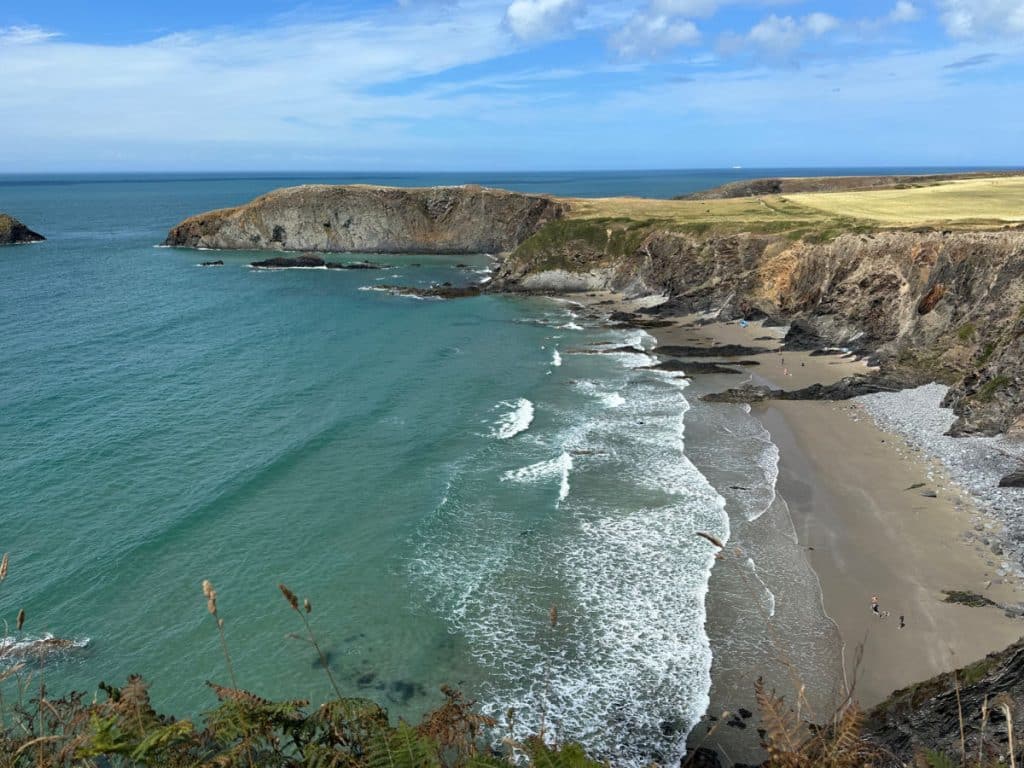
f you are looking for ways to save some money on your trip to Europe cost, here are some ideas;
Visit Less Expensive Countries
If you want to go to Iceland or Scandinavia, you are going to need a healthy budget. Even places that used to be considered budget-friendly, such as Portugal, have gotten pricier in the last few years as tourism has increased (although it is still cheaper than other Western European countries.).
However, if you go the bit off-the-beaten path, you can find great deals, it may just be a bit trickier to find direct flights. Look at destinations like Scotland , Wales , and Eastern European countries like Hungary or Slovenia.
Avoid Big Cities
Everyone wants to visit Paris , London , and Rome , but the less time you spend in these large European capitals, the better it is for your budget. Sevilla is going to be cheaper than Barcelona, and so on.
You can also stay in less-popular countryside destinations, like Piedmont or Umbria instead of Tuscany in Italy or Languedoc instead of Provence in France. We have stayed in gorgeous chateaus in the Languedoc region of France for half the cost of our hotel in Paris.
Stay in Rentals
If you are visiting Europe with kids , one way to save money is to find an apartment or villa rental through Airbnb, vrbo, or other vacation rental alternatives . Since it is hard to find family rooms in Europe that sleep four or more, often the cost of a two or three-bedroom apartment is cheaper than renting two hotel rooms or an expensive hotel suite.
Even couples will benefit from staying in agriturismos, which are farms that offer accommodations on-site in Italy, or something similar.
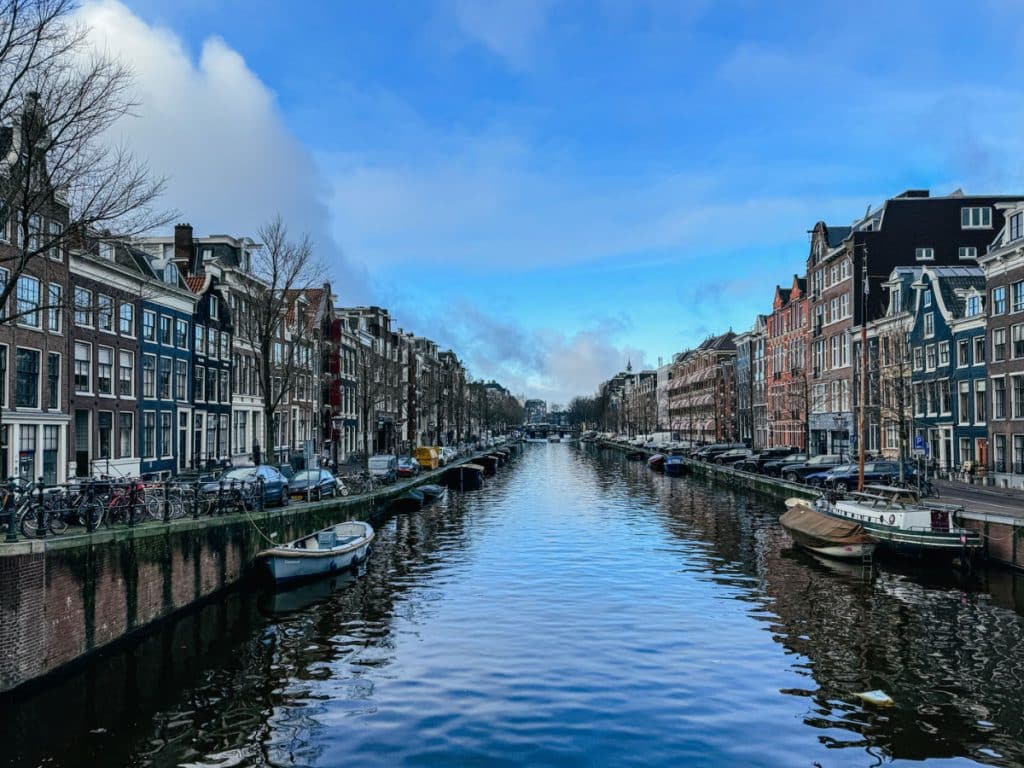
Travel Outside of Peak Season
I know it is hard to travel during shoulder season or low season if you have kids, but remember that Europe has different holidays and school schedules. You can find great deals around our U.S. Thanksgiving. And, if your kids get out of school early, you can still find better deals and availability in June than July or August, when European schools have summer break.
If you have more flexibility, traveling in late October through May (outside of holiday weeks) will save you some money. Just do some research about half-term or school break weeks.
Use Points and Miles or Low-Cost Carriers
There are a lot of ways to hack your way to free flights to Europe using sign up bonuses and flexible points transfers if you can easily meet the minimum spend amounts with your current spending. However, even if that isn’t an option, you can often find great deals on flights to Europe.
We have flown to London and Vienna for under $500 each. I highly recommend signing up for a flight deal subscription service such as Going . With the premium level you can set up your preferred airports and dream destinations and receive alerts on airfare sales and even points deals.
There are also a number of low cost carriers that offer flights from the United States including Norse Atlantic Airways, Condor, and French Bee. You can also use Play Airlines, which connects through Iceland.
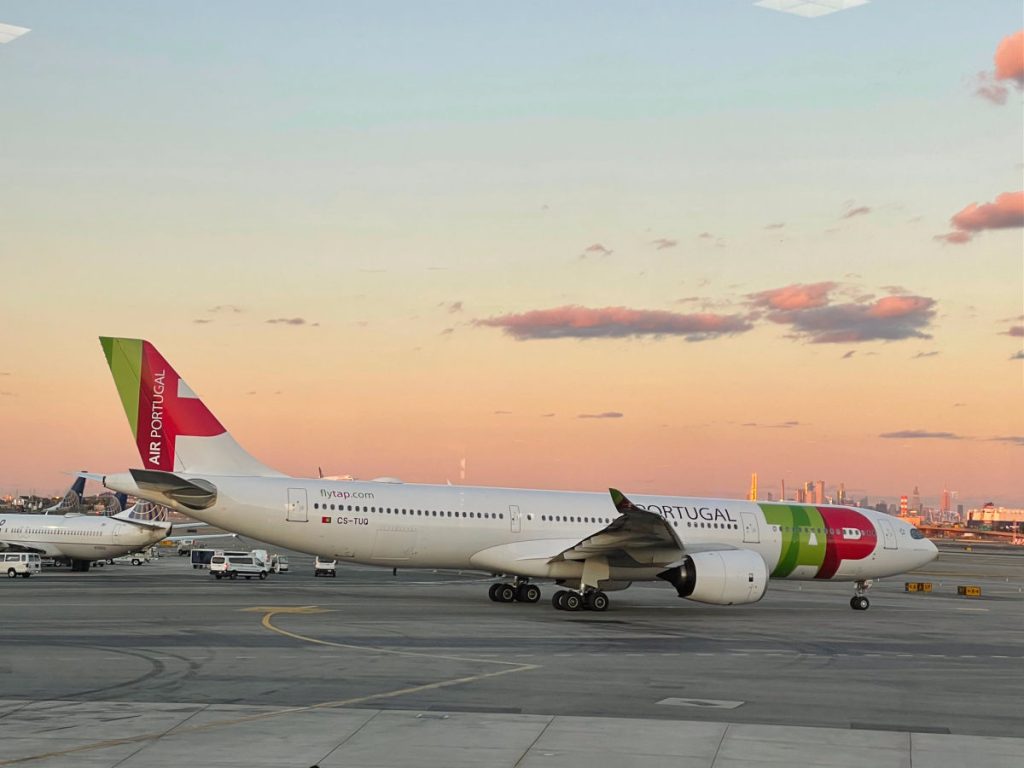
Fly to a Hub and Then Use a Low Cost Carrier
If you find a great flight deal to a major European city, you can then use a low-cost carrier such as Ryan Air, EasyJet, Vueling, or others to connect to your final destination. These flights are typically under $100 per person, but make sure you are aware of the luggage restrictions on weight and size, which are different from U.S. carriers.
Trains are also another option, but don’t assume they will be cheap, especially if you book first class with assigned seats and luggage storage. Be sure to research your options before you book.
How Much Does a Trip to Europe Cost
Note: This post contains affiliate links. If you click a link and make a purchase, I may receive a small commission at no cost to you.

Now let’s look at some average costs for a trip to Europe. I’ve based these on two people traveling to Europe from the United States for a one week (7 night) trip.
Airfare to Europe Cost
Airfare from the United States to Europe can range from $500 per person (if you find a great deal) to over $2,000 (if you book late and travel during high season on a standard carrier.) As I mentioned above, you can save money by looking for flight deals, traveling off-season, or using low-cost carriers or connecting flights.
However, you can assume an average cost of $1,000 per person.
Total Airfare Cost = $2,000 ($1,000 x 2 people)
European Accommodations Cost
Accommodation costs can vary greatly depending on if you are staying in a big city or elsewhere, or if you are in a luxury hotel or a rustic rental. You will usually want to split your trip between a city and somewhere in the countryside. If you only have a week, I’d suggest three nights in the city and four nights elsewhere. Think Rome or Florence + Tuscany, Milan + Piedmont, Paris + Burgundy, Edinburgh + Highlands, London + Wales, etc.
In the city, expect to spend $250-500 per night and $150-350 per night in another location. Remember, you can refer to each of my detailed cost breakdowns for specific hotel and itinerary recommendations for those various destinations.
Total Accommodations Cost = $2,050 ($350 x 3 nights + $250 x 4 nights)
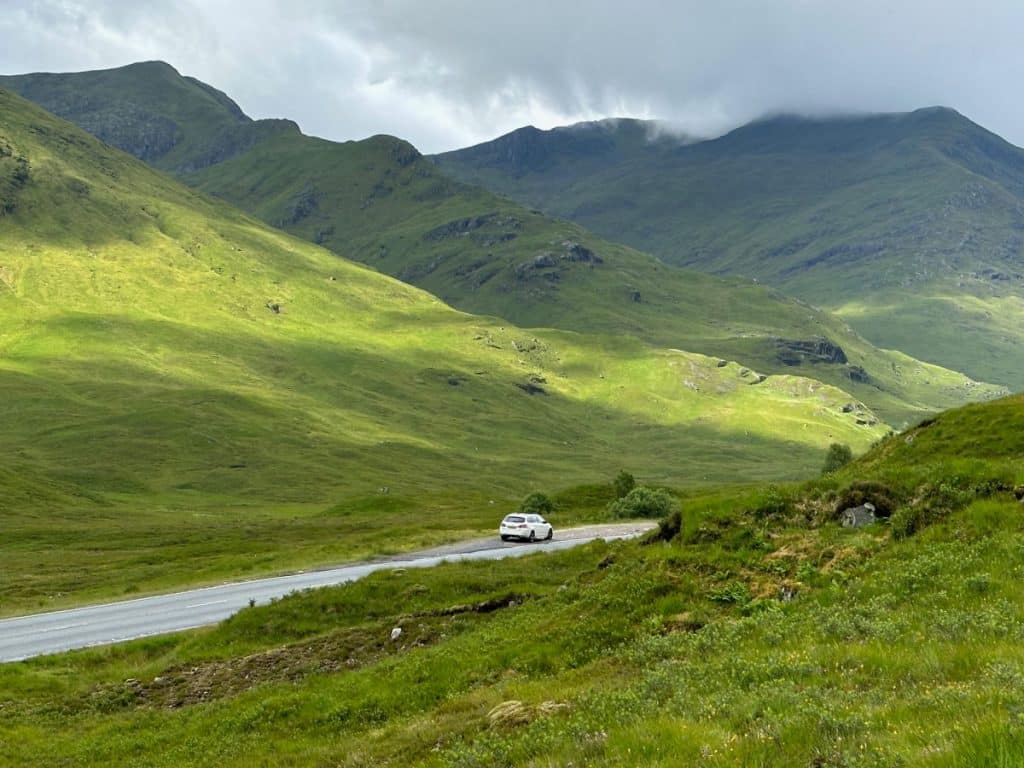
European Transportation Cost
Even if you plan to stay in one city for your entire trip to Europe, you will still need to spend some money on transportation. For example, when we went to Amsterdam for three days, we walked all over the city but we still took a transfer to and from the airport. So whether it is Uber, taxis, public transportation, or private transfers, you will need to budget for transportation expenses.
More likely, you will need to also either rent a car or take a train between destinations. If you are renting a car, be sure to book it early as the prices go up the closer you get to your arrival. Automatic transmission cars are also more expensive than manual transmission. Try to pack in carry on suitcases if possible so that you can rent a small to mid-size car. Driving in some countries (especially Ireland, the UK, and parts of Italy) can be challenging on small roads so you will appreciate it for more than the price point! Also keep in mind that gas is more expensive in Europe than the United States.
Total transportation cost = $800 (estimated)
European Activities Cost
Your activity costs vary greatly depending on where you go in Europe. For example, if you are visiting Scotland or Wales and you just want to spend a lot of time in the outdoors and maybe visit a few castles, your expenses will be minimal. But if you are going to Paris or Rome and you want to explore historic sites and museums and get the most of the experience, you will want to take a tour.
When in Greece, you can spend your days by the pool or the beach, but you will probably want to at least take a sunset sail and maybe a food or wine tour. I know it can get expensive, but don’t skimp on your activities. This is what you will remember most about your trip. More than your hotel. More than your airplane ride. It is also what matters the most when visiting a foreign country. After all, you want to experience the local culture. You want to learn more about the destination’s history. And you will want to see what makes a place unique.
Total Activities Cost = $1000

European Food Costs
It used to be that food in Europe was more expensive than in the United States but in the last couple of years, I have not found that to be the case. You can still spend a bundle on food if you elect for hotel breakfasts or fancy chef’s tasting menus. But in general, you can find affordable meals especially in destinations like Scotland, Wales, Portugal, and Italy.
You can also save money by preparing some of your own meals if you rent an apartment or stay in an aparthotel with a kitchenette. Remember, you don’t need to tip as much in Europe (or sometimes at all) and the alcohol is usually a lot cheaper because it isn’t marked up as much. These factors can make a big difference in your bottom line.
As a rule of thumb, plan to spend:
- $10 per person for breakfast (stop at a bakery for pastry and coffee or juice)
- $15-20 per person for lunch (think pizza, sandwiches, or street food)
- $25-50 per person for dinner (maybe plan for one splurge dinner too of up to $100 pp)
Total Food Cost = $1150
You may also want to budget some money for souvenirs and travel insurance.
Total Trip to Europe Cost
A seven-night trip to Europe for two people will cost an average of $7,900, or $564 per person, per day.
Save this to Pinterest
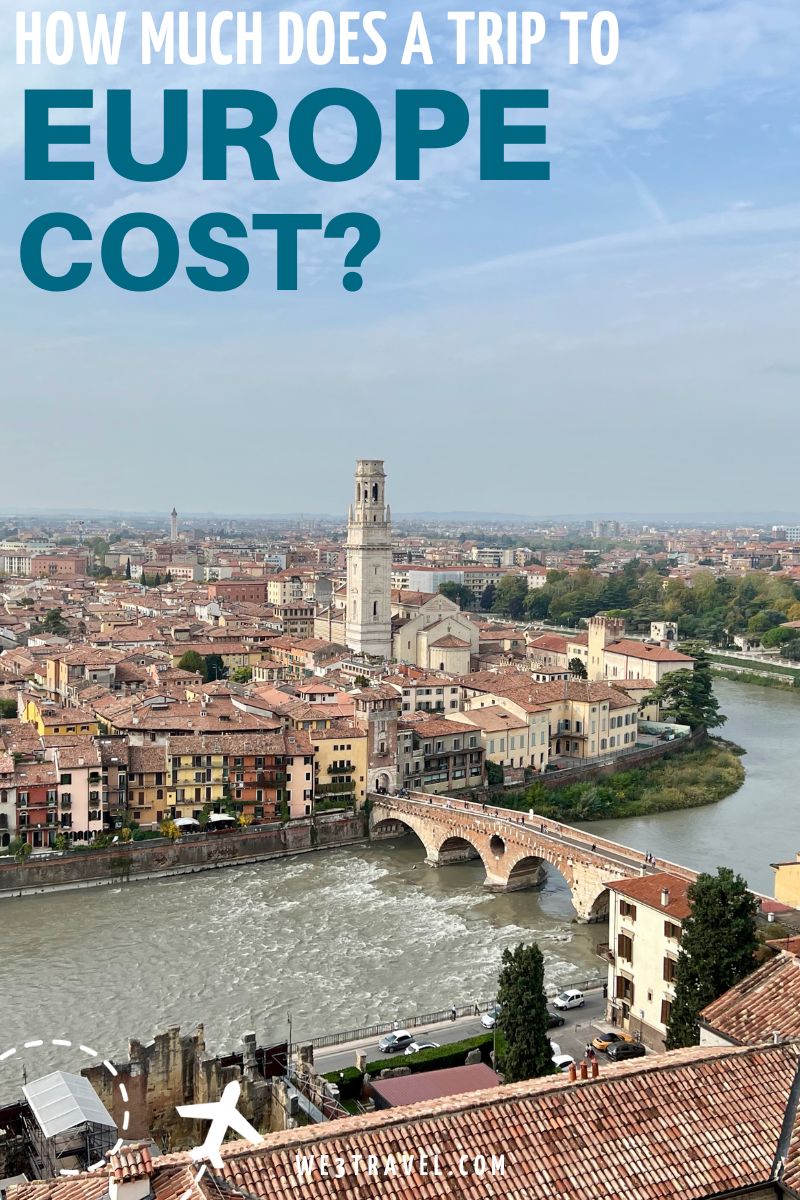
Tamara Gruber is the Founder and Publisher of We3Travel. A former marketing executive and travel advisor, Tamara is an award-winning travel writer and recognized expert in family travel. Tamara is a member of SATW and the Adventure Travel Trade Association, and serves on the Board of the Family Travel Association. She is also the publisher of YourTimetoFly.com and the co-host of the Vacation Mavens travel podcast.
Find this useful? Share it!
Publish Date: March 12, 2024

SIGN UP FOR OUR NEWSLETTER & RECEIVE A FAMILY VACATION PLANNING KIT!
We3Travel.com will use the information you provide on this form to send you newsletters. You can unsubscribe at any time by clicking the link in the footer of any email you receive from us, or by contacting [email protected] . By clicking below, you agree that we may process your information in accordance with these terms.

Start typing and press enter to search

Europe in 3 Weeks: 6 Itineraries
DISCLAIMER: This post might have links to travel services and products that we enjoy. We might make a commission from it at no extra cost to you.
I am confident many people have Europe on their bucket list of places to visit. This continent is filled with preserved historical sites, famous landmarks, UNESCO-certified heritage sites, various natural scenery, and diverse cultures from people of different nationalities.
There are tons of activities that you can do here as well. However, if you plan to stay a little longer than the usual vacation duration, it might cost you a lot, especially if you aren’t familiar with places to go without spending too much.
This guide is for people planning to travel around Europe in 3 weeks . Whether you are on a budget or looking to splurge a little, there’s something for everyone. In this guide, I am covering central and southern Europe – both have famous destinations. I also have itineraries for the eastern region for affordable, nordic areas for unique culture, and off-the-beaten path of Europe.
I want to ensure you spend the 3-week holiday that suits you. If you are new to travelling on a budget, check out these tips for budget travel . You can also read in below our estimate of how much a 3-week in Europe trip might cost.
THINGS TO KNOW BEFORE GOING TO EUROPE
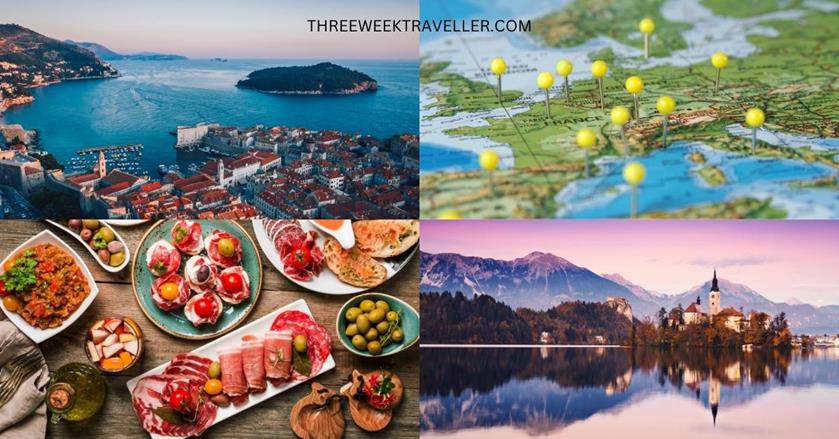
If you plan a trip for 3 weeks in Europe, stay with me as I lay down tips on travelling there on a budget. Decide where you want to go, when, how much you will spend, and what you plan to do once you go there.
I created a detailed outline to help you plan your 3-week Europe trip or you can also consider a 3-week cruise around Europe.
Where to go in Europe for 3 weeks
If you want a hassle-free trip, y ou could visit countries that share land borders or are near each other. You can also limit your visit to 3 countries to spend at least a week in each.
For example, France, Italy, and Spain are super popular and are easy to get from one to another. The same goes for Norway, Denmark, and Sweden. The Baltics (Lithuania, Latvia, and Estonia) is another example of Hungary, Croatia, and Greece/
That way, you could experience what each country offers without rushing. You wouldn’t be overwhelmed by the new cultural experiences and frequent environmental changes. You should check our compilation of 3-week travel itineraries for different (each) European countries .
When to go to Europe
This actually depends on what activities you want to do. For instance, summer would be perfect if you like swimming , various water activities, open-air concerts, and museums. If you’re going to try skiing, ice skating, sledging and see frozen waterfalls and snow in general, you should go during winter.
You can go hiking in spring and discover diverse flora and fauna along the way, as most flowers bloom during springtime. Europe also has various music and cooking festivals, while during fall, you can attend their world-famous festivals, enjoy the changing of the tree colours, and do lots of hiking and museum visits.
However, if you ask me, I like visiting Europe during late spring or late autumn, from March to April or September to October. These are shoulder seasons; the weather is neither too hot nor too cold, there are fewer tourists, and accommodation prices are a bit lower.
Check our list of best destinations to go for a beach trip and t op places to spend winter for 3 weeks .
You don’t have to write your itinerary from start to finish, day by day, but writing some sort of guideline will help you visualise your trip. You can check which destinations you can afford to book a private room and which places you have to book dorm rooms.
Y ou can join free walking tours in Europe, which are widespread . The great thing about this is that you only need to give a tip to the tour guide according to your satisfaction. You can also take local transportation such as trains, buses, or subways (they call them metro in Europe).
You can also check if you can rent bicycles. This means of transportation is enjoyable, and you would be able to appreciate the places you visit more when riding a bike.
Another way to save money when taking public transportation is by booking a shared ride (either from your hotel to the airport or the following city/country).
Pack lightweight
There are so many cheap flights across Europe, but the catch is that the baggage cost on flights often doubles the ticket costs.
That’s why you need only to bring the essentials and pack light. In this way, you also could move faster because you don’t need to rearranging your belongings or drag a heavy suitcase or backpack.
We have an amazing packing list for general travel , which comes with a free printable checklist. You can also check our packing list for summer or the packing list for winter .
Basic travel tools and sites
When planning your trip, check different sites for the most affordable and budget-friendly travel services, such as flights, accommodations, and even travel insurance. If your trip is not final, look for sites that offer flexible cancellations if anything changes.
For those sure of their trip, booking your hotels and flights in advance is best to have more options, especially affordable ones.
These are the websites and tools I personally use when booking my trip. The ones I book right away are flights (for international/intercontinental), hotels (to find the best deals), and car rentals.
3 WEEKS IN EUROPE AVERAGE COST
On average, one person should plan around $2,000 for 20 days in Europe . You should be able to stay in a private room and eat out most of the time. But that still depends on where you plan to go.
If you’re on a backpacker’s budget, you should be able to do it for $1,500 . Plan to stay in dorm rooms and cook when you can.
If you want to splurge, $4,500 for 3 weeks in Europe is very comfortable. You can book five-star hotels, eat at fancier restaurants, and book private tours.
Pro tip: Don’t include your airfare when computing your budget because airfares change drastically . You can also try to book during non-peak seasons to save more or wait for promos.
When computing how much a 3-week Europe trip costs, you should consider food, accommodation, and tours. Last-minute bookings are the most expensive. Hence if possible, book as early as three months before your planned trip.
How much is it really to travel to Europe for 3 weeks? It depends on the person, of course. However, personally, I spent about $1,200 on one summer. I also visited during winter, where I paid $1,000 in 3 weeks, mostly because I decided to head to East Europe . I also backpacked around for three months and spent about $2000.
In my opinion, Europe is not that expensive compared to North America or even Oceania. But it would help if you had a good plan and were okay with not always eating in fancy places. The great thing about Europe is the hostel community, it’s affordable and a great way to socialise.
I mainly stayed in hostels around Europe, took public transportation, walked a lot, ate street food and went to local grocery stores. I also made sure to see as many places as possible and enjoy some “luxury” here and there.
You can also book this 7-day tour of central Europe , which covers Germany, Czechia, Slovakia, Hungary, Austria, and Switzerland. Transportation, accommodation, tour manager, and breakfast are all included.
PINNED MAP OF DIFFERENT ITINERARIES
Click the enlarge button on the top right corner. Credit: map data: Google
EUROPE IN 3 WEEKS ITINERARIES
I created a list of various destinations according to season and budget preference. I included itemised lists of how much a 3-week Europe trip costs so you could know what you could do with specific budget ranges. Please note that this budget is for one person only, and you can adjust the cost according to the number of people.
>> We also have an article on affordable destinations to spend your 3-week vacation
Most Affordable Winter Destination – Portugal, Spain, Italy
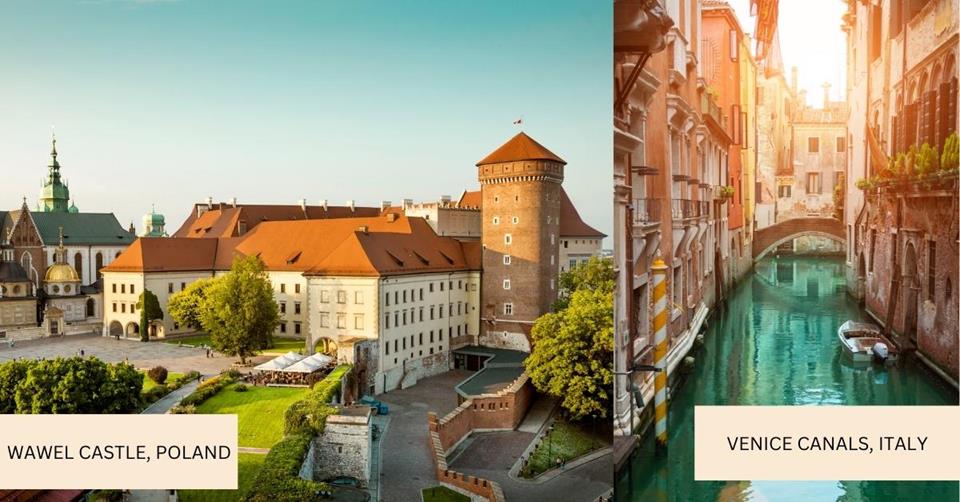
If you want to visit Europe during winter, consider visiting Portugal, Spain and Italy. These three are close to each other. They also have affordable accommodations and generally have fewer tourists during this season.
In Italy, you can enjoy the Colosseum without crowds , explore the mountains, and spend time in museums. You will also have the luxury of spending the entire 3 weeks in Italy , covering north to south. From mountains, vineyards, and historical places, to Mediterranean beaches. If you are foody, you definitely have to try these best Italian desserts .
On the other hand, Portugal doesn’t suffer from freezing temperatures even in the middle of the winter season, so you can still enjoy the sunlight and do various outdoor activities such as hiking. There are popular Instagrammable spots in Portugal that are worth a visit, and of course, wine and food.
You want to see Porto and Lisbon, especially if you want to hike the popular Santiago de Compostela route. Once you get to Porto, stay near a bus or metro stop, both budget-friendly ways to move around. If you don’t know where to stay in Porto, near the historic centre of Ribeira District, both offer affordable options.
Don’t forget Lagos; it offers such wonderful water activities. This is an incredible destination if you plan to visit during summer. Lagos is located in the Algarve region, a popular area for its coastal features. If the water is too cold during winter in the Algarve, there are other things you can do, such as hiking, visiting chapels, enjoy a road trip.
If you are heading to the capital, decide on the activities, from museums, beaches, hiking, and even night-out parties. Knowing what to pack for Lisbon will ensure you don’t waste your time and money. Check our itinerary for 3 weeks in Portugal .
Lastly, Spain holds some of the best festivals on the continent during this season . During winter, the best places to visit in Spain are Seville, Barcelona, Madrid, Granada, the Canary Islands, and Costa del Sol.
There are so many places to see in Madrid, and probably a good 5 days here is the perfect spot. At the same time, Barcelona for 2 days will allow you to cover too many attractions.
But please, do not miss the Canary Islands – like no other in Europe. We have 3 weeks in Spain. Below are the budget ranges you should allocate for food, guided tours and accommodation. You can also check out our 3 weeks in France, Italy, and Spain itinerary .
- food budget per day: $20
- guided tours cost per day: $15-$30
- accommodation cost per day: $25-$45 as a backpacker or $70+ for mid-range
- 3-week budget: $1,200-$1,800 (excluding flights to and back)
Mid-range – UK, France, Germany
If you want to spend more, visit the UK, France and Germany. These countries are rich in history and are close to each other, so much so that you can take trains to cross borders. They also have great wine and beers, so this option is perfect for wine and beer enthusiasts.
Check out our 3 weeks in Central Europe itinerary, which features Germany, Poland, Czechia, Switzerland, Austria, Slovakia, and Hungary. But if you prefer the West, we also have an itinerary for 3 weeks in Western Europe or a sole 3 weeks in Germany post.
If this is the region you want to visit, it’s best to come during the off-season, which is either from March to May or September to November. The prices are lower, and there are fewer crowds.
If you visit the UK, you can finally see Big Ben in London and London Bridge . You can spend your holiday in England, which hosts festive Christmas markets and drink hot chocolate while wandering about or seeing the world-famous Isle of Skye in Scotland.
There are many ways to explore the UK. We have a guide for 3 weeks in England only, or you can also explore the entire country and do 3 weeks in the UK .
However, if you have been to the UK before, you probably want to visit Ireland this tim e. You can combine Scotland, Northern Ireland, and Ireland. Please look at our 3 weeks in the UK and Ireland itinerary .
In France, you can take a picture of the Eiffel Tower or visit the Louvre if you’re a museum enthusiast. You can also try out their seasonal cuisines and go on a shopping spree as they have a government-mandated citywide sale during this season, also known as “soldes”. And yes, we have an itinerary for 3 weeks in France .
In Germany, you can go to thermal bathhouses to experience their outdoor pools and saunas . You can also ride their historic cable car, Merkurbergbahn, to see the snow-covered pine trees. Here are the daily price ranges for food, accommodation and tours.
- food budget per day: $25-$35
- guided tours cost per day: $30-$50
- accommodation cost per day: $35-$50 for backpackers or $80+ for mid-range
- 3-week budget: $1,900-$2,800 (excluding flights to and back)
Affordable Summer Destination – Italy, Croatia, Greece
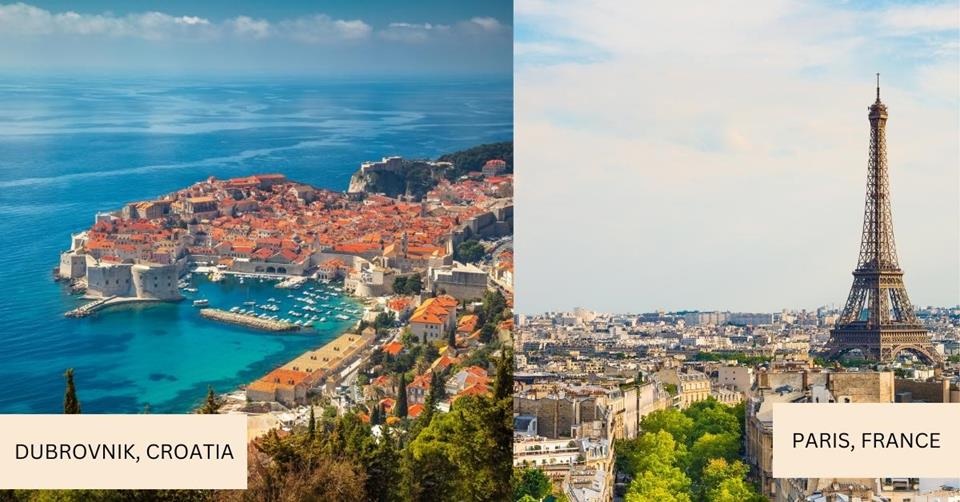
For affordable summer destinations, Italy, Croatia, and Greece are must-visits. They are not necessarily next to each other or affordable. Italy is expensive, but Greece and Croatia are a bit more affordable so that balances it out.
Another thing is that flights between these three countries are affordable. Plus, it’s in Southern Europe ; there’s no better place for a beach vacation in this region.
These 3 destinations serve great food, wine, and beer and are rich in natural scenic spots like beaches and mountains. Personally, I would say this is the best way to explore Europe in 3 weeks on a budget.
Italy is known for their fantastic food. You can go on a gondola ride in Venice and have wine tastings in Sorrento, which sounds like a perfect summer getaway. Venice is not really a budget-friendly destination.
But, if you want to make this trip affordable, check out the coastal cities on the southeast side of Italy. Not only are they cheaper for vacation in this expensive country, but they are also less crowded.
Greece is a famous summer spot as well. You can visit Mycenae, an ageless arch made with monumental stones that was once a dwelling place of some of the most famous people in Grecian history, including Agamemnon, Electra, and Orestes. You can also have a road trip with your friends around Pelion or just chill and have a slow day in Hydra.
This country is an excellent choice if you want to experience the Mediterranean Sea but want to do Europe in 3 weeks on a budget. 3 weeks in Greece is a little more affordable than Spain, France, and Italy.
Croatia is now known for its location in Game of Thrones, but it has more to offer. You can go coral diving during the summer season. You can also avail yourself of a boat trip, hike, swim, cycle or sail; honestly, the sky’s the limit with the number of things you could do here.
It’s another more affordable destination but located ion on the Mediterranean Sea. You can check our 3 weeks in Croatia itinerary too.
- accommodation cost per day: $25-$35 or $50 and up for mid-range
- 3-week budget: $1,000-$1,800(excluding flights to and back)
Drinks and Beach – France, Poland, Greece
If you are the type of person who wants to lounge along the beach while drinking wine or beer, then this triad is perfect for you . Aside from that, these countries are rich in historical artefacts and landmarks, and flight tickets are cheap.
One of the most famous beaches in France is Plage de la Cote des Basques in Biarritz, which you’ve probably read about in Hemingway’s The Sun Also Rises . Another famous beach is the Deauville beach in Normandy, where Coco Chanel opened her first clothing store and held historical value .
Sopot is one of the most famous beaches in Poland , especially for the locals, because aside from chilling and sipping wine along the bay, you can also take boat rides, and there are spas and saunas nearby.
Swinoujscie Beach is famous for its water sports because of the constant wind and waves. It also has a windmill nearby which is considered its most famous landmark. Greece has the most beautiful beaches in Europe, so you won’t have difficulty looking for a great beach there. Some of the most beautiful beaches are Mykonos, Crete and Santorini.
- accommodation cost per day: $25-$50
- 3-week budget: $1,700-$2,800 (excluding flights to and back)
CHECK-OUT: Best itineraries for 3 weeks in East Europe
A bit of splurge – Iceland, Norway, Denmark
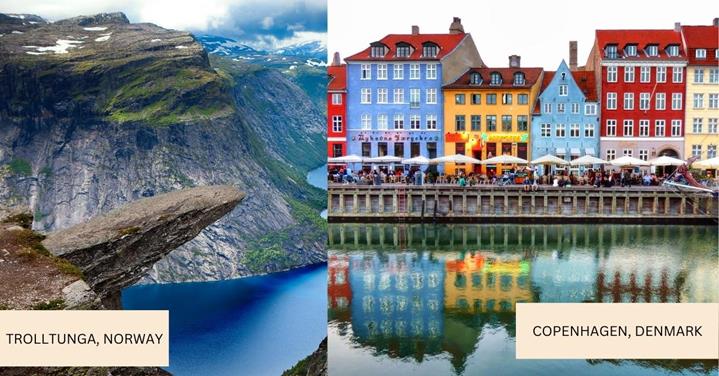
I know Scandinavia or the Nordic region doesn’t scream Europe in 3 weeks on a budget. But if you have a larger budget and want to splurge a little, Iceland, Norway, and Denmark are the perfect places to visit. The best way to make this plan affordable is to rent a car rather than relying on domestic flights, trains, or even buses.
Not super cheap, but it can be affordable if you plan and look for great deals. Remember these tips for visiting Iceland and travelling to Scandinavia for first-time travellers to this region.
You should look at flights and book accommodations 4-6 months in advance . Travelling in the northern hemisphere during the off-season, fall or winter, would be best.
Book hotels in advance to save money and also use local transportation. For instance, if you plan to go during the summer, flights are cheaper if you book them during the winter.
You can enjoy many free or affordable activities like hiking, sightseeing, or road-tripping. You can also enjoy their street foods at a lower price than at their restaurants.
If you are curious, some of the most famous places in Iceland include the Blue Lagoon in Grindavik, a geothermal spa and Strokkur Geysir, where spectacular geysers are found. You can also witness the northern lights if you’re lucky, as the time of their appearance is quite unpredictable.
Meanwhile, in Norway, you can visit the Lofoten Islands or the scenic city of Bergen, which form an archipelago and go to the Lofoten War Memorial Museum. Bygdoy Peninsula is also home to some of Oslo’s top tourist attractions.
In Denmark, you can visit the Tivoli Gardens found in Copenhagen and Nyhavn, the model of most postcards and can also be found in Copenhagen. Here, you will also see the statue of the Little Mermaid, yep, that story was written by the Danish writer, Hans Christian Andersen.
Do you know that you can spend 3 weeks in Scandinavia and cover Norway, Denmark, and Sweden on the same trip? We also have 3 weeks in Iceland itinerary if that’s something you have in mind and a Norway itinerary .
- food budget per day: $30-$50
- guided tours cost per day: $50-$70
- accommodation cost per day: $45-$60 for backpackers or $100+ for mid-range
- 3-week budget: $2,400-$3,500 (excluding flights to and back)
The Baltics – Lithuania, Latvia, Estonia
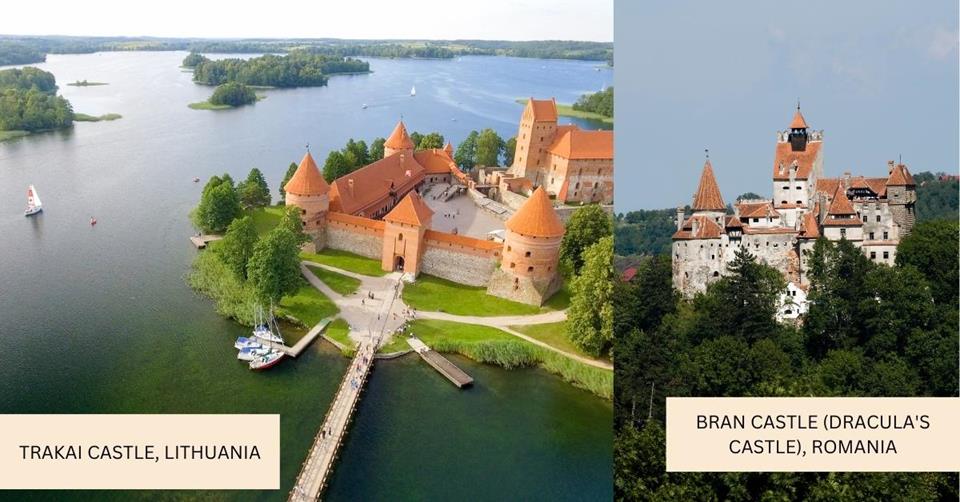
If I’m on a budget, these three countries are my favourite European destinations for Europe in 3 weeks . These places offer a calm and relaxing vibe, from beaches to hiking, to castles, without spending too much.
You can cross the borders via train or bus, saving you money instead of flying. I’m not going to lie. The Baltic beaches are not stunning, but they offer a tranquil scene and few tourists.
I recommend you enter either through Vilnius or Tallinn and make your way north or south. Don’t forget to try cider from this region. It’s one of the best in Europe. Few do this, but road-tripping through the Baltics is the best way to explore this area. It’s more affordable and gives you so much more freedom.
In Lithuania, make sure to visit Vilnius, Kaunas, and Klaipeda. These two cities offer different activities from one another. Vilnius for the cultural and historical experiences and the best nightlife in Lithuania. In comparison, Kaunas is known for its creative and street arts.
Even though it’s a small city, many things to do in Kaunas are related to art. Last but not least, Klaipeda for the beach and other water activities. Make sure to visit Trakai Castle and Uzupis.
From there, make your way to Riga, the coastal capital of Latvia. Enjoy museums, castles, fortresses, and the beach during summer. You can also visit Rezekne, where Raznas National Park is located. Here, you can enjoy hiking, fishing, and even canoeing.
And lastly, Tallinn. A vibrant and modern city, Estonia’s capital and known for being the leading digital powerhouse of the Baltics. Estonia is the pioneer of digital residencies and the first country to welcome digital nomads. Many museums show Estonia’s history and culture. Being on the coast, you can enjoy the beach during warm weather and other water activities.
- food budget per day: $15-$30
- accommodation cost per day: $35-$50 for backpackers and $60+ for mid-range hotels
- 3-week budget: $1,400-$2,300 (excluding flights to and back)
SUMMARY OF EUROPE IN 3 WEEKS
Europe might be expensive in general, but with enough planning and research, you should be able to create a travel plan for Europe without spending too much.
Our own guide to Europe in 3 weeks on a budget, consists of our personal list of places that I visited and perhaps you can visit them as well depending on your budget, season and activity preference.
These budget ranges are for participating in group tours and eating in bazaars, holiday fairs or mobile food carts instead of going to fancy restaurants.
Next summer, I plan to be in Europe for 3 weeks visiting Italy (can never get enough!, Slovenia, and Czechia.
We hope reading this has been enjoyable and informative for you as much as compiling this list has been delightful. We also hope you would consider going to Europe because there are many famous scenic spots and hidden gems just waiting to be visited.
SAVE THIS TRAVEL ITINERARY ON YOUR PINTEREST:
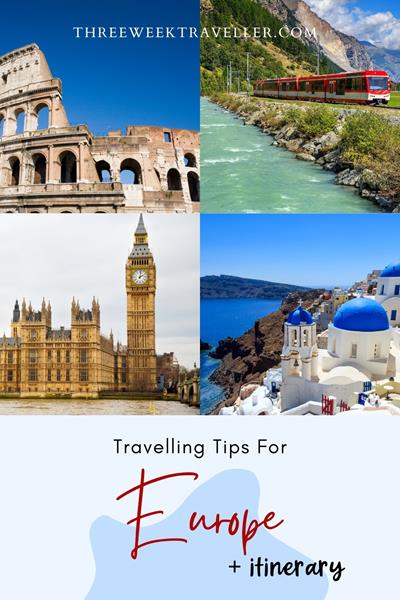
Travel Europe on a Budget
The Savvy Backpacker
City Guides .\33 a132798-3f3b-4585-954d-7e70cf863447{fill:#231f20}
How to travel europe on a budget | 100+ money-saving travel tips.
My MEGA list of the best ways to save money while traveling Europe on a budget.

I’ve spent the last 10 years writing hundreds of articles helping people just like you travel Europe on a budget, so I thought it might be a good idea to list out some of my favorite money-saving travel tips.
Estimate Your Overall Travel Costs

Before we jump into ways to travel Europe on a budget it’s helpful to give you an estimate on how much it actually costs to visit Europe — after all, having a baseline will help put costs into perspective.
In my experience, I’ve found that most frugal backpacker-style travelers spend around $70-$120/day in Western Europe and $40-$85/day in Eastern Europe. At this level, you can travel fairly modestly without making too many sacrifices — but you’re not going to be living it up.
If you’re on a budget but not a “backpacker” then you can expect to pay around $90-$225/day — your accommodation choice will make the biggest impact on your daily budget.
Note: These are just ballpark figures so your results will vary. Also, these don’t include transportation (i.e. train tickets, airfare, etc.). Learn more about estimating travel costs by reading my How Much It Costs To Travel Europe guide.
How To Find Cheap Flights To Europe
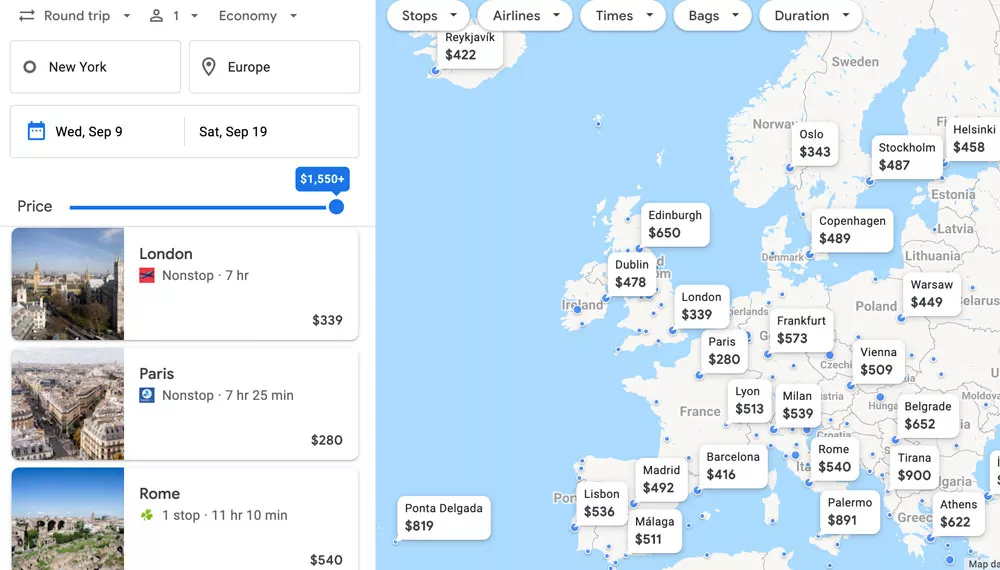
Your first major travel cost will be your flights to Europe as they can cost anywhere from around $400 to $1,400+. There are dozens of factors that go into how much you’ll spend on your airfare but I’ve listed some general strategies to help you get the best price.
Online Flight Booking Resources
There are tons of online resources to help you find cheap flights but after years and years of searching I’ve narrowed it down to a few favorites:
- Google Flights: I’m a huge fan of Google Flights because it allows you to search through multiple routes quickly and they do a great job of organizing the search results. My favorite feature is how you can simply put “Europe” as the destination and it will find you the cheapest destinations. Visit Google Flights
- Momondo and Skyscanner: While Google does a good job of finding most flights, I’ve found that Momondo and Skyscanner can sometimes find cheap flights that don’t show up in Google’s results. Visit Momondo or Visit Skyscanner
- Scott’s Cheap Flights: Finding random deals can take a ton of time so that’s why I’m a huge fan of Scott’s Cheap Flights. SCF is an email newsletter that emails multiple cheap deals every day. Most of the deals featured on in their newsletter are only available for a day or two so this is best for flexible travel dates. Visit Scott’s Cheap Flights
Book Flights Early (But Not Too Early)
In general, your flights will be the cheapest when booked a few months before departure. However, if you book too early you’ll end up paying more because the airlines figure that anyone who books 6-8 months early is dead set on those specific travel times.
On the other hand, booking last minute will also be very expensive since the airlines also assume that you’re locked into that specific travel time.
My strategy is to start looking 5-6 months early and continue monitoring prices over the next month or two. Once I find a price I’m comfortable is when I pull the trigger.
Save On Flights By Traveling Off-Season
Traveling to Europe in the summer is always going to be expensive — it’s hard to get around that. Additionally, Christmas and New Year’s can also be expensive times to fly.
My favorite time to fly is April/May or September/October because you can still score some great deals and the weather is still generally nice.
Of course, traveling during the winter will be the cheapest but then you have to deal with poor weather.
Be Flexible and Save Big
I’ve said it before but it being flexible is the absolute best way to save money on flights to Europe. Even shifting your travel date by a day can save hundreds of dollars.
Switching up your destination airport can also result in big savings.
I love flying direct but it’s usually more expensive than buying a flight that has a layover.
Pay Attention To The Costly Drawbacks Cheap Flights
Cheap flights certainly have drawbacks and many budget airlines tack on all kinds of extra fees and restrictions. It’s important to pay attention to these extra fees as they can make “cheap” flights not so cheap. Here are some things to watch out for:
- Bag Fees: Many cheap tickets only allow a personal item that can fit under the seat so you have to pay for a checked and carry-on bag. Adding a bag can easily cost $50-$80 each way. Some airlines are very strict on weight limits and will charge you extra if the bags are overweight.
- No Free Food/Drink: Some airlines charge extra for water, soda, and all food.
- Non-Refundable: Almost all tickets are non-refundable these days and have expensive change fees.
- Secondary Airports: Some cheap airlines fly into smaller airports that are further away from the city they service than the major airport. These smaller airports may not be well served by public transport so that could be an extra expense.
Fly In And Out Of Different Airports
Often flying in and out of different airports can save you time and money — for example, flying into Paris and flying home from London.
This prevents you from wasting time and money backtracking to a city you already visited so you can spend more time exploring somewhere new. It also lets you expand where you visit so you’re not stuck to a small region for the sole purpose of needing to stay near a specific airport.
Look Into Free Flights via Airlines Miles and Credit Card Offers
I’ve never been one of these travel hackers who use airline miles to earn free flights but I know it’s a very popular thing to do. It’s important to be smart about your spending because you don’t want to end up spending more money than you save on a free ticket.
How To Fly Cheaply Within Europe
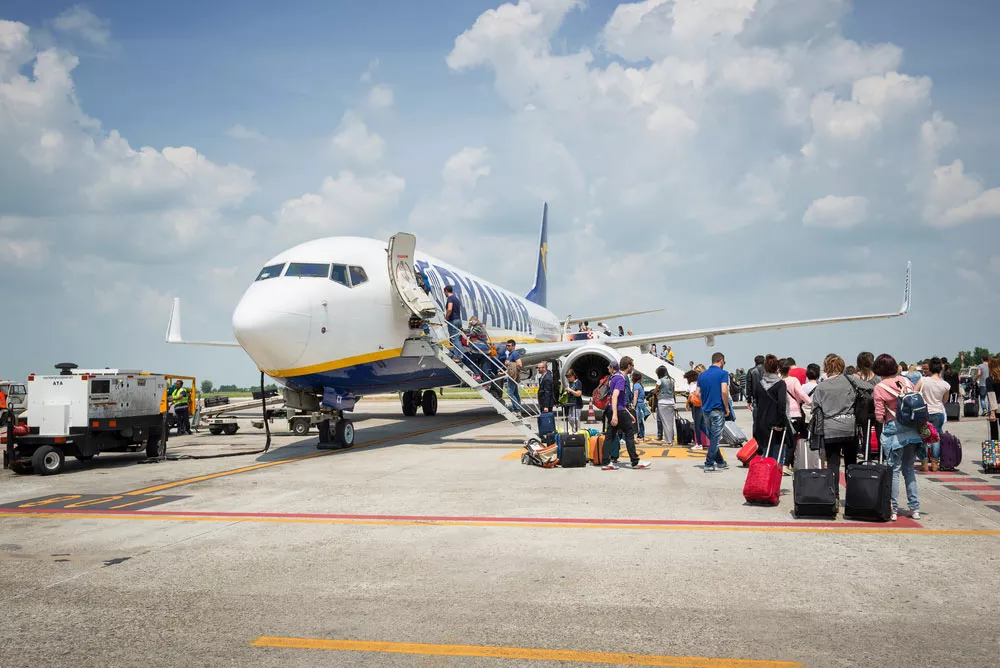
Flights within Europe are way different than what many of us non-Europeans are used to. Basically, Europe has a ton of budget carriers and they also have to compete with the high-speed trains, so you can find some crazy cheap airfare — like Paris to Berlin for $50. I once flew from London to Edinburgh for $2.
The strategies for finding cheap flights within Europe are similar to how we find cheap flights to Europe:
- Use A Flight Search Engine: Google Flights, Momondo, and Skyscanner are my favorite places to find the best deals on flights.
- Book A Few Weeks Early: Booking last minute can be expensive you can find some excellent deals but booking a couple of weeks in advance. Conversely, booking multiple months in advance can also be expensive.
- Budget airlines are often sticklers about luggage restrictions so pay attention to the size and weight limits as it’s an easy way for them to make money.
- Factor In Transportation Costs: Getting to and from the airport will be an extra cost so take that into account.
How To Save Money On Travel Gear
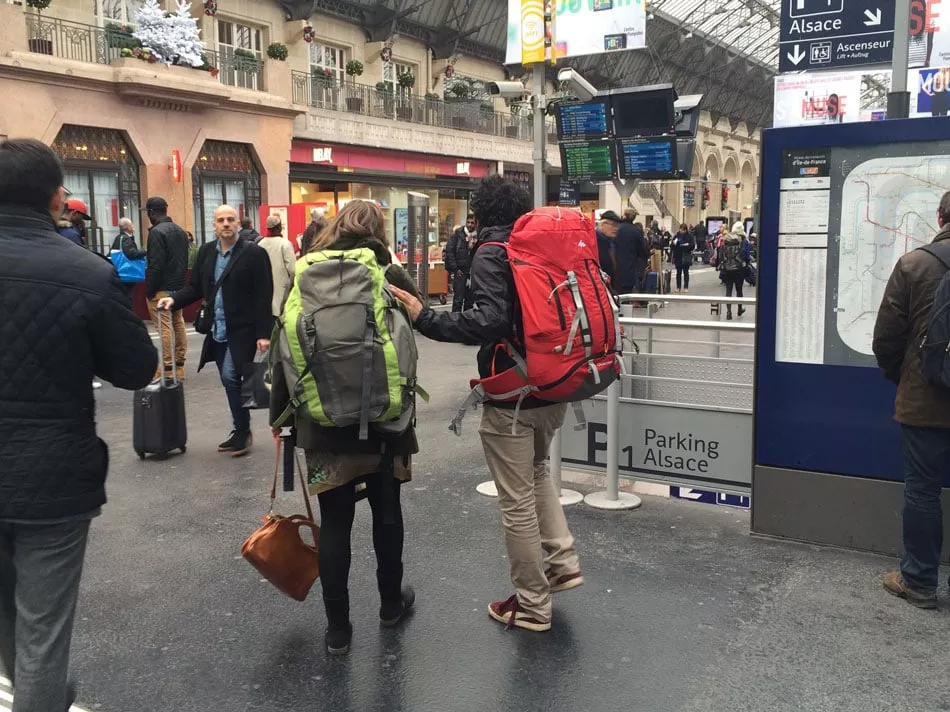
I’m a huge fan of travel gear but it’s easy to go overboard by spending a ton of money on travel stuff. In fact, there is a good chance that you already have basically everything you need.
Saving On Big Ticket Travel Gear
- Travel Backpack/Suitcase: A nice travel backpack can cost between $100-$300. Suitcases start around $50 but can easily go over $300 as well. Check with friends to see if anyone can lend you theirs. You can also buy these used on eBay for a decent price. Read more about my favorite travel backpacks .
- Comfortable Shoes: You want a solid pair of shoes but there is a good chance you might already have a perfectly suitable pair. Read more about my favorite travel shoes .
- Travel Clothing: There are lots of companies making clothing designed specifically for travel— i.e. quick-drying, wrinkle-resistant, odor-resistant, lightweight, etc. This stuff is nice to have but you can live without it.
- High-End Camera : Lots of people spend $600-$1000+ on a new camera for their trip. A nice camera can be great if you know how to use it but I find myself using my iPhone 99% of the time. In fact, even people who are good at photography get sick of lugging around a large camera and then switch to their phone.
- Laptop/iPad: Unless you absolutely need it for work, leave the laptop at home. An iPad does come in handy but I find that using your smartphone is more than enough.
More Money-Saving Packing Advice
- Pack Light & Save On Checked-Bag Fees: Almost every budget airline within Europe will charge a hefty fee ($30-$60) for checking a bag so you’ll save a lot by flying with a carry-on only. However, the weight of a carry-on bag is usually limited to around 20 lbs — which can be difficult for a lot of people.
- Pack Minimally and Buy As You Travel: Many people end up packing a ton of stuff they don’t need because they think they “might need it.” However, I find that it’s wiser to bring the essentials and then you can buy things while traveling.
- Borrow Gear: There is a good chance that someone you know has a bunch of travel gear packed away in a closet. Ask around before shelling out a ton of cash.
- Buy Used: Backpacks, cameras, guide books, electronics — all this stuff can be found at a heavy discount when bought second-hand.
- See What Gear You Have: Buying new stuff for your trip to Europe can be exciting but there’s a good chance you already own plenty of things that you might need for your trip.
Additional packing resources:
- Backpacking Europe Packing List
- Travel Europe Packing List for Women
- Europe Packing List (for any travel style)
- Hostel Packing List
- Ultralight Travel Packing List
- Winter Packing List for Europe
Choosing When To Travel

The time of year you travel will have a major impact on your overall travel costs — notably for airfare and hotel/hostel costs.
The summer will always be the most expensive time to travel — which generally runs from June to mid-September. Finding affordable airfare during this time can be difficult. Additionally, scoring affordable accommodation is also a challenge since there are lots of people looking for a place to stay.
The absolute cheapest time to travel Europe is during the winter (not counting Christmas & New Years) since the weather is generally cold and possibly rainy. That said, you can find some truly cheap airfare — I’ve flown from NYC to Copenhagen in November for $300. Hotels, hostels, and rental apartments also drop their prices to attract travelers.
My favorite time to travel is during the shoulder season — which roughly runs from late April to early June and mid-September to late October. These times offer a great mix of enjoyable weather and reasonable prices.
Visit Cheaper Countries

Scandinavia and Switzerland are all very expensive so you’ll pay a premium for food, alcohol, and accommodation.
Western Europe (especially major cities like London, Paris, Amsterdam, etc.) is also expensive but you can sometimes find decent deals.
Southern Europe is a little cheaper and you can often travel affordable in cities like Rome, Barcelona, and Lisbon.
Prices get even cheaper as you move east so you can find very solid deals in Berlin, Prague, Budapest, etc. Greece also has a lot of good deals to be found.
I’ve written 30+ city price guides for many of Europe’s most visited cities to give you an idea of how much you might spend when visiting.
Here are a few of my most popular city price guides:
- Amsterdam Travel Prices
- Athens Travel Prices
- Barcelona Travel Prices
- Berlin Travel Prices
- Budapest Travel Prices
- Copenhagen Travel Prices
- Dublin Travel Prices
- Florence Travel Prices
- Lisbon Travel Prices
- London Travel Prices
- Madrid Travel Prices
- Paris Travel Prices
- Prague Travel Prices
- Rome Travel Prices
Plan Around Major Cultural Events

Ok, this one can be a little harder to plan for but when cities host major cultural events it tends to spike accommodation rates.
For example, cities with large Christmas markets get a lot of travelers over the holidays and that raises rates. It’s the same around New Years in London, Paris, etc. because people come to party. Another example is Munich during Octoberfest as hotel rates can triple.
However, those events are predictable but there are other events like marathons, large sporting events, trade shows, local festivals, etc. that aren’t as apparent to foreign visitors. It doesn’t hurt to do a quick search as you’re planning your trip to make sure you don’t get stuck having to pay super-high rates.
Track Your Spending
If you’re on a strict budget then you’ll want to actually track your spending and review your notes often — because, let’s face it, it’s easy to lose track of how much money you’re spending.
There are various travel spending apps or you can simply write things down in a notebook as you go.
Save Money By Using ATMs and Avoiding Currency Exchange Offices
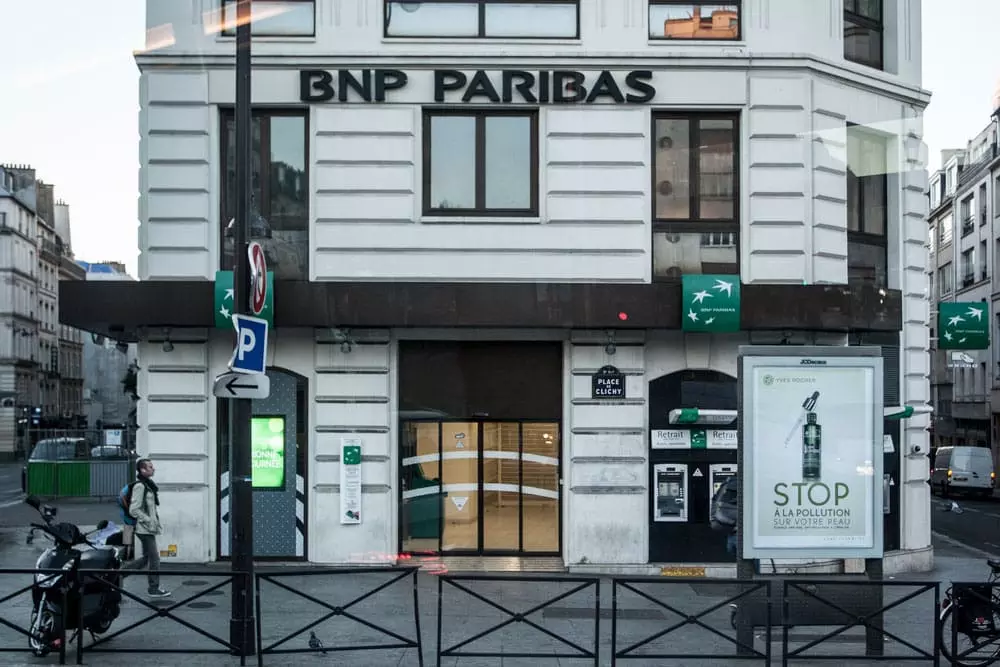
There are plenty of enjoyable ways to spend money while traveling Europe but spending money to get money from money exchange offices is never enjoyable.
The best (and cheapest) way to get money while traveling is from the ATM. In most cases, European ATMs don’t charge a fee (some airport ATMs that are attached to money exchange places will charge — those are tricky). Your own bank might charge a fee since it’s not your bank’s ATM but overall it’s the cheapest option.
Don’t bother getting cash from currency exchange offices because they charge big fees and commissions.
Similarly, don’t get a bunch of cash from your home bank before you leave because they also give you lousy exchange rates. If you’re really worried, get $100 worth of your first stop’s currency and then use ATMs after that.
Seriously, ATMs are everywhere in Europe.
Be Smart About ATM, Debit Cards & Credit Card Usage
Here is my strategy for paying for things while traveling:
- ONLY use your debit card to withdraw cash from ATMs.
- Use your credit card to pay whenever possible.
There are two main reasons to follow this strategy — it’s the cheapest option and it’s the safest way to use money.
Here’s the deal, card skimming (i.e. making a copy of a credit/debit card) is a very common scam in Europe — basically a waiter will take your card and scan it through a card reader that “copies” the card. The process takes a split second.
While most banks have fairly good fraud detection, if someone skims your card and then makes fraudulent charges the bank will cancel your card — which sucks if you’re traveling because getting a replacement card is nearly impossible.
So what happens if your debit card gets canceled? It means you have no way of getting cash from the ATM anymore. Furthermore, your debit card is directly connected to your checking/savings account so getting the money back is a much longer and more difficult process.
On the other hand, if you get fraudulent charges on your credit card it will still get canceled but you still have your debit card for cash from the ATM. And your credit card isn’t attached to your checking/savings account so you don’t have to worry about trying to claw back the stolen funds. In fact, I travel with two different credit cards just to be safe.
Financially speaking, there are some credit cards that don’t charge a foreign transaction fee and most use the current exchange rate so you’re not getting nickel and dimed on every purchase. Many credit cards also offer other benefits like cashback, travel insurance, travel credits, etc.
As far as getting money from ATMs, I recommend making large withdrawals so you can minimize the fees you’re paying. For example, my bank charges me around $3 per withdrawal so if I take out €300 ($325) I’m only paying about 1% in fees but if I take out €50 then I’m paying 5.5% in fees.
Skip Taxis & Use Public Transportation
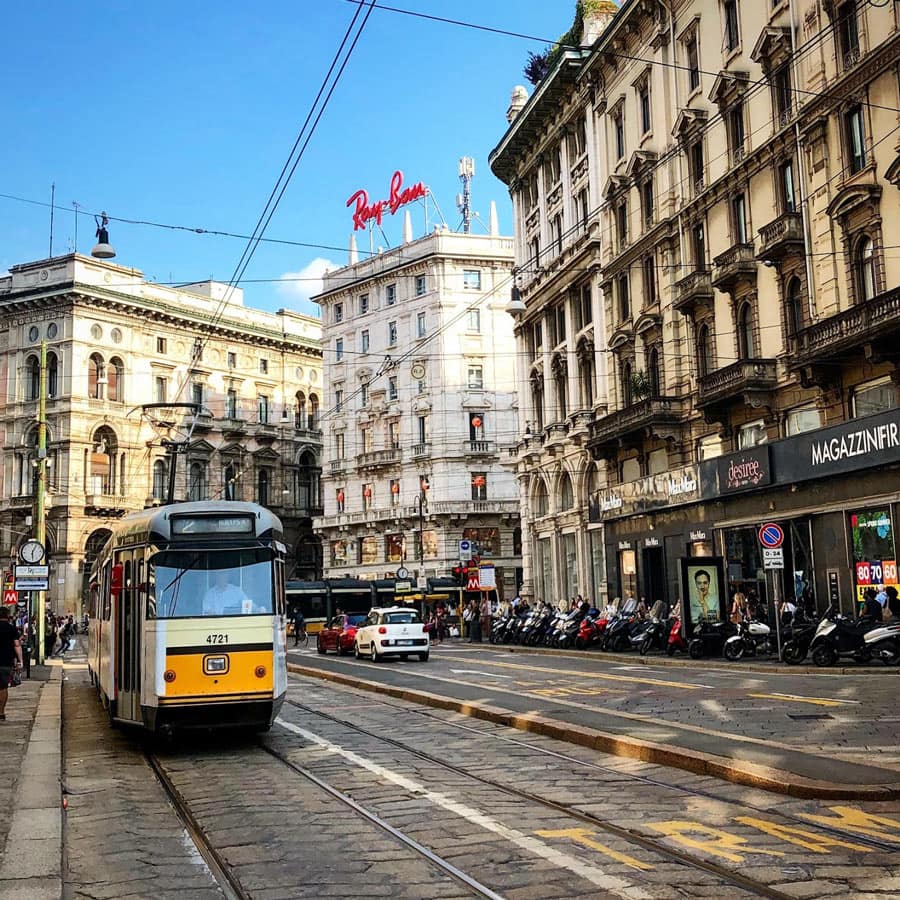
It seems like a no-brainer but using public transportation is much cheaper than using taxis. Most rides on public transit cost between $1-$3 so it’s hard to beat the price.
Where I get into trouble is when I feel like taking a taxi from the airport after a long flight — since I’m tired and have luggage. However, most airport taxi rides will cost €30-€70 so it’s a real budget killer when compared to the €2-€5 public transportation option.
Another thing to watch out for is taxi scams — which are most common in southern and eastern Europe. These scams can generally be avoided with Uber/Lyft but not all countries/cities allow ride-share companies.
Note: Only use taxis that are officially licensed taxis. There are plenty of “car services” that say they’re a taxi but they’re actually a private car and they can legally charge any rate they feel like.
How To Save Money on Train Tickets

I’m a huge fan of train travel and the Europeans truly know what they’re doing. In fact, I’d gladly pay a little extra for the train than have to deal with the hassle of air travel. Luckily, there are many ways to save on train tickets.
Book High-Speed Trains Early
As a general rule, high-speed trains are cheapest when booked as early as possible and get gradually become more expensive as the departure date approaches. If you book last-minute you’ll pay a premium.
Local and medium-distance trains are usually priced per distance so booking early doesn’t offer any money-saving benefits.
Here are some examples of high-speed train ticket prices to show you the price difference between booking early and booking last minute. Note: I used Omio to find these train ticket prices.
- Booked a few weeks before departure: €66-€100
- Booked two or three days before departure: €190-€250
- Booked a few weeks before departure: €99-€120
- Booked two or three days before departure: €133-€145
- Booked a few weeks before departure: €70-€100
- Booked two or three days before departure: €135-€155
- Booked a few weeks before departure: €13-€22
- Booked two or three days before departure: €20-€40
- Booked a few weeks before departure: €45-€70
- Booked two or three days before departure: €45-€70
- Booked a few weeks before departure: €25-€35
- Booked two or three days before departure: €25-€35
- Booked a few weeks before departure: €14-€30
- Booked two or three days before departure: €20-€35
Buy a Eurail Pass
I won’t say that Eurail Passes are always a great deal but many travelers find them to be a worthwhile investment.
In my opinion, the true value of the Eurail pass is its flexibility as you can essentially jump on any train without much planning — thus you’re not paying crazy high prices for last-minute train tickets.
On the other hand, pre-booking train tickets a few weeks/months early will almost always be cheaper than using a rail pass — but you give up flexibility/spontaneity.
Look Into Railcards
Most countries have some form of railcard that gives discounts on train travel. The discount can range from 15%-30% off the ticket price.
These railcards are usually for students (under 26 years old) and seniors — but there are some cards for people under 30 as well.
Railcards are typically meant for residents of the country but anyone can usually buy them.
Ask About Youth & Student Discounts

Pretty much anyone under 26 is considered a “student” in Europe and there are plenty of discounts for things like museums and train tickets.
Discounts vary by country and sometimes by the mood of the person selling tickets. Some countries only give a discount if you hold a student ID from a European Union university but others will give a discount to anyone.
It doesn’t hurt to ask so always bring your student ID just in case.
Travel With Friends

I love solo travel but there are certain times when traveling with a group of friends can cut down on travel costs.
Most notably, sharing a hotel or rental apartment with one or more people cuts down the per-person cost considerably. For example, splitting a $130/night Airbnb with four people ends up costing around $33/night per person — which is cheaper than a hostel.
Rental cars can also end up being very cheap when the cost is split between multiple people.
Meals can also be cheaper when split with others — you can split portions or make a meal for the group.
Get Travel Insurance
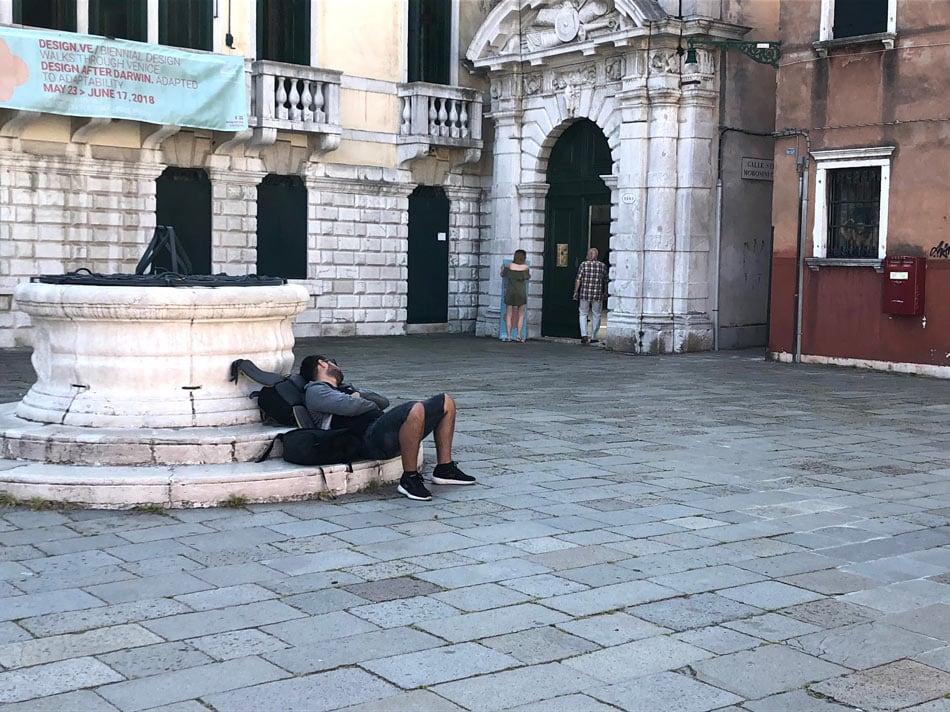
Travel insurance is a cheap investment that can save you thousands of dollars if you end up needing to use it. Trust me, you don’t want to get hit with a medical bill if you get injured overseas.
Travel insurance can also help you recover travel costs that you already paid for if your trip gets canceled/cut short and it can also help cover the cost of replacing lost/damaged luggage.
Personally, I use World Nomads as they’re geared toward budget travelers so their prices are very reasonable.
How To Save Money On Food & Alcohol
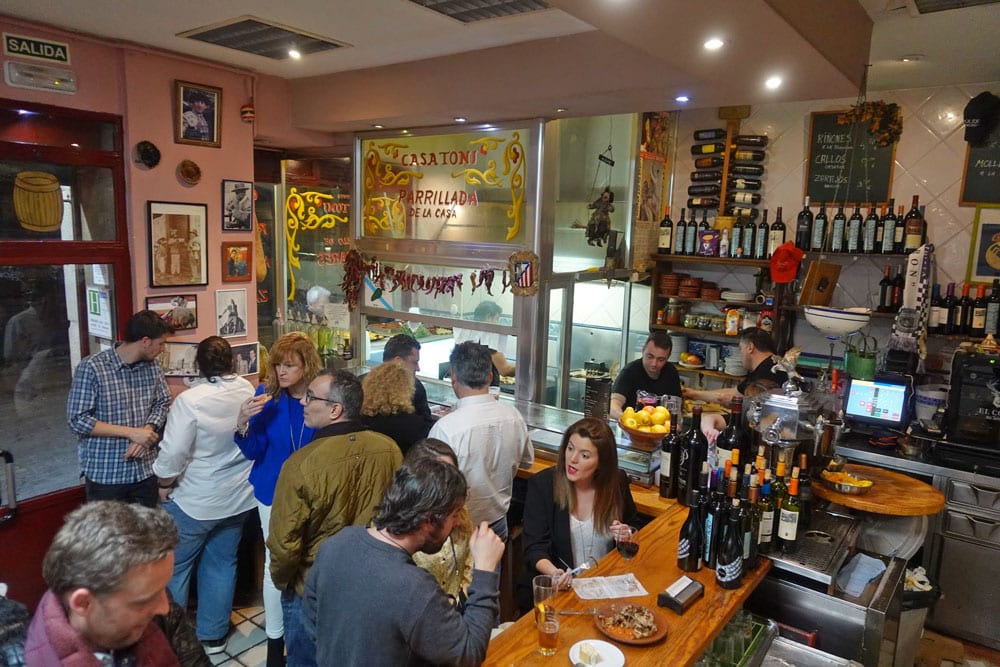
Ok, this is a big one because you can spend a fortune on food if you’re not careful. Luckily, if you’re flexible, there are plenty of ways to cut back drastically on your food expenses.
Research, Research, Research (Before You’re Hungry)
Here is my number one tip for saving money on food — do your research!
Whether you’re eating in restaurants or cooking your own meals, it’s super important to take the time to plan your meals.
Why? Because waiting to think about your meals until you’re hungry or as you’re “out and about” (and you’re usually in the touristy part of town that’s filled with tourist prices) is a surefire way to settle for a meal that’s too expensive or low-quality.
That’s why I always research potential places to eat so I know where I can find a quality meal at a fair price.
Shop At Farmer’s Markets and Grocery Stores
Farmer’s Markets are great for multiple reasons — they’re fun to explore, it’s a great way to experience the local culture, the food is high quality, and the prices are very fair.
Your cheapest option will be shopping at grocery stores — I also think it’s a fun cultural experience. The quality of produce isn’t as good as farmer’s markets but it’s still an excellent resource.
Plan A Group Meal
If you’re staying in a hostel that has a kitchen try getting a few people to pitch in for a group meal. This is an excellent way to make friends and save a ton of money.
Have A Picnic For The Park or City Square
A picnic in the park or city square is an unbeatable way to spend your lunch or dinner time. Even if you don’t feel like making your own picnic, you can easily find takeaway restaurants selling affordable food options.
Chow Down On Street Food And Takeaway
I love street food because it’s filling, tasty, and affordable. Each country/region has its own street food specialty — France has crêpes, Berlin has currywurst, Belgium has fries with a million types of sauce, pizza slices in Italy, and fish ‘n’ chips in the UK, so it’s a good way to try some local favorites.
Also, check out bakeries as they usually have quality sandwiches.
Local Favorites Are Usually Great Values
Do your research to find local favorite restaurants because they usually offer the best value in terms of quality and price. I’ve found that the best way to find these little gems is through local food bloggers and local food tours (they usually also have blogs on their websites).
I’ve also had a lot of luck looking on Reddit for restaurant recommendations as many locals post there and are happy to share their insider knowledge — r/Paris , r/London , r/Berlin , r/Amsterdam , r/Lisbon , r/Rome , r/Barcelona , etc.
Southeast Asian and Middle Eastern Food Are Great Deals
Chinese, Thai, Vietnamese, Indian, Turkish, etc. food are all delicious and is often very reasonably priced.
Save With Lunch Specials
Plenty of restaurants, especially those popular with locals, often have a fixed-price lunch specials to attract people who work in the neighborhood. This is a great time to sample the local cuisine at a discount.
The Menu Speaks Volumes
One sign that a restaurant isn’t a tourist trap is by looking at the menu. A handwritten menu usually means the ingredients are fresh.
Additionally, if the restaurant has a menu in multiple languages it often means they cater to a lot of tourists. Granted, some perfectly fine places have multi-language menus, but it’s a good rule of thumb.
Stick To Tap Water To Save
If you ask for water at a restaurant there is a good chance they’ll bring you a large bottle of water so you have to specifically ask for tap water.
Furthermore, skip the soda as well because you’ll be given a tiny expensive bottle that costs as much as a beer or wine.
Eating Inside vs Outside
Restaurants often charge a slightly higher price if you sit at their outside sidewalk tables. I love people-watching on a sidewalk cafe but if you’re trying to save a little then you’ll want to eat indoors.
Leave The Tourist Areas
Don’t get me wrong, you can find quality meals at fair prices in “touristy” parts of any European city but you’ll have to do your research. However, you’ll find much better deals by venturing out to more residential neighborhoods.
Drink At The Bar
Whether it’s alcohol or coffee, it’s often cheaper to drink standing up at the bar as opposed to at a table.
Drink Local
Every city will have its own regional beer, wine, and spirits — all of which are usually the most affordable option.
Look For Happy Hour Specials
The concept of happy hour isn’t quite as prevalent in Europe as it is in the US but it’s becoming more popular. Most bars will advertise these deals on their windows.
Local and Student Bars
Most bars in the center of the city are more geared towards tourists so the prices tend to be higher. Seek out places near universities or smaller local joints for better prices.
Buy Drinks From The Grocery Store (And Drink In Public)
Most European cities are very lax when it comes to drinking in public parks and squares as long as you’re not causing a scene. So head to the grocery store to pick up a perfectly fine $8 bottle of wine or some cheap beers and enjoy yourself!
Don’t Overtip
Tipping comes automatically to Americans but many European waiters are paid competitive wages so tipping isn’t expected or you might only add a little extra to the bill (but certainly not 15%-20%). Additionally, some restaurants automatically add a tip so pay attention. Each country has its own customs so do a little research first.
How To Save Money On Accommodation
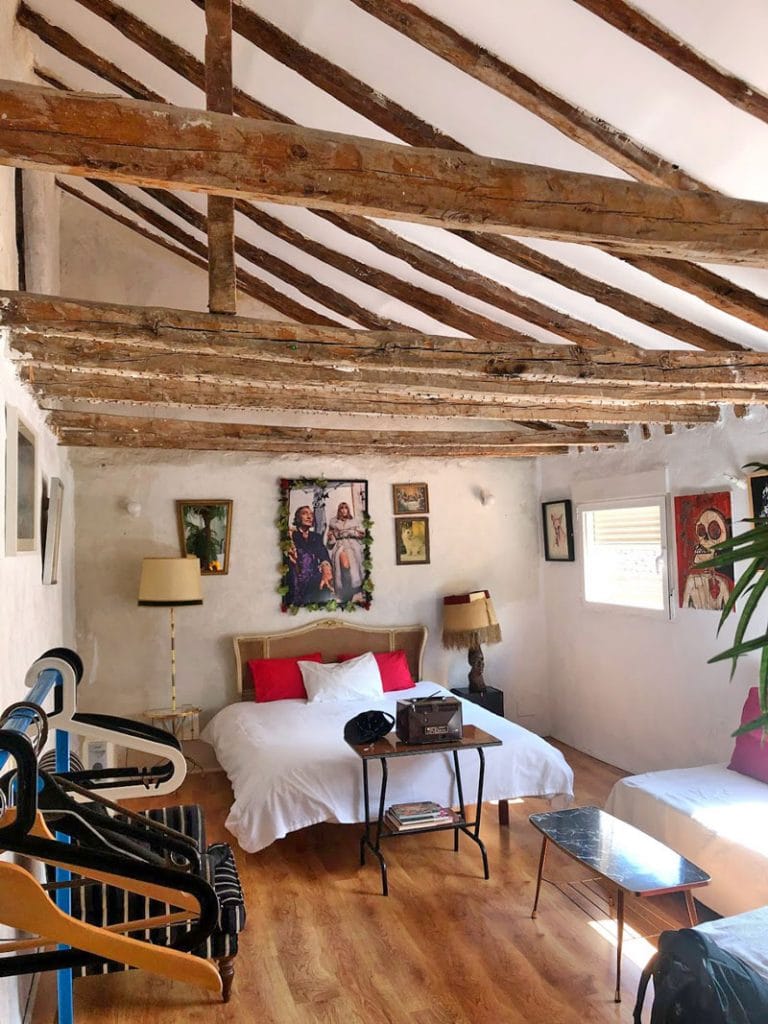
In many cases, your largest overall expense will be your accommodation but there are plenty of budget tips that can save you quite a bit of money.
You’ll Pay For the Location
The joy of visiting Europe is exploring its old cities so you’ll pay a premium if you want to stay in the center of it all — especially with hotels. And even within the city the prices will vary greatly based on neighborhoods.
I’ll be honest, staying way outside the city can take away some of the “magic” of Europe but it’s a great way to save a lot of money.
Stay In A Hostel
Hostels are one of the cheapest accommodation options in Europe and every city will have multiple different hostels that cater to just about every travel style. In fact, there is a recent trend toward “boutique” hostels that have many of the same amenities you’d find in a hotel (but they are a bit more expensive).
Most hostels start around $20-$50/night for the cheapest dorm bed option but private rooms can range from $60-$120/night.
To learn more about hostels, check out my guide to hostels in Europe and my recommended hostels in many of Europe’s top cities:
- Best Hostels in Amsterdam
- Best Hostels in Barcelona
- Best Hostels in Berlin
- Best Hostels in Brussels
- Best Hostels in Budapest
- Best Hostels in Copenhagen
- Best Hostels in Dublin
- Best Hostels in Edinburgh
- Best Hostels in Florence
- Best Hostels in Lisbon
- Best Hostels in London
- Best Hostels in Madrid
- Best Hostels in Milan
- Best Hostels in Munich
- Best Hostels in Nice
- Best Hostels in Paris
- Best Hostels in Prague
- Best Hostels in Reykjavik
- Best Hostels in Rome
- Best Hostels in Venice
- Best Hostels in Vienna
Try Booking Directly
You can sometimes get a better price on your hotel by booking directly with the property since booking websites like Hotels.com, Booking.com, etc. charge the hotel a hefty fee.
However, I haven’t always found that hotels are willing to lower their prices but sometimes they’ll throw in a free breakfast or other perks for booking direct.
Seek Out Independent Hotels Not Listed On The Booking Sites
As mentioned previously, there are still some independent hotels that don’t list themselves on booking websites since those websites take a large cut of the booking. Naturally, these hotels are a little harder to find but the extra work can save you a decent amount of money.
Bed and Breakfast Offer Great Value
Many people forget about B&Bs but they’re a great way to get a comfortable place to sleep while also getting a little closer to the local culture.
Start Looking Early
There are some good deals to be found but it’s easier to find deals if you start looking early.
Rent an Airbnb/Apartment
Rental apartments can be an excellent way to save big — especially if you’re traveling with a group. Rental apartments also come with a kitchen so you can save more by cooking a few of your own meals. Click here to save $30 off your first Airbnb stay .
Rent A Room
People often don’t realize that Airbnb lets you rent a room in someone’s apartment and this is another great way to save a lot of money. Additionally, Airbnb hosts who rent rooms are often happy to share their favorite local restaurants and sights. Click here to save $30 off your first Airbnb stay .
Check Weekend Rates
Hotels and hostels often raise their prices significantly on Friday and Saturday so that’s something to consider when booking and comparing prices.
Pay Attention to Extra Fees
The price you see when looking at hotel prices can sometimes be misleading as they’ll tack on extra fees when you go to book your hotel — and these extra fees can be significant.
Try Couchsurfing
The ultimate way to save on accommodation is by not paying anything — which is why Couchsurfing has become so popular. There are plenty of obvious downsides to Couchsurfing but a lot of people love it and it’s an excellent way to experience a different side of the local culture.
Become A Housesitter
If you’re going to be in one location for an extended amount of time then you might consider becoming a housesitter. The most popular website is Trusted Housesitters . It’s essentially a service that matches up people who need someone to watch their house while they’re away — usually to take care of their pets.
Popular locations have a lot of competition so you might need to do a few housesits in less popular spots to build up your reputation.
Focus On A Region or Visit Fewer Places
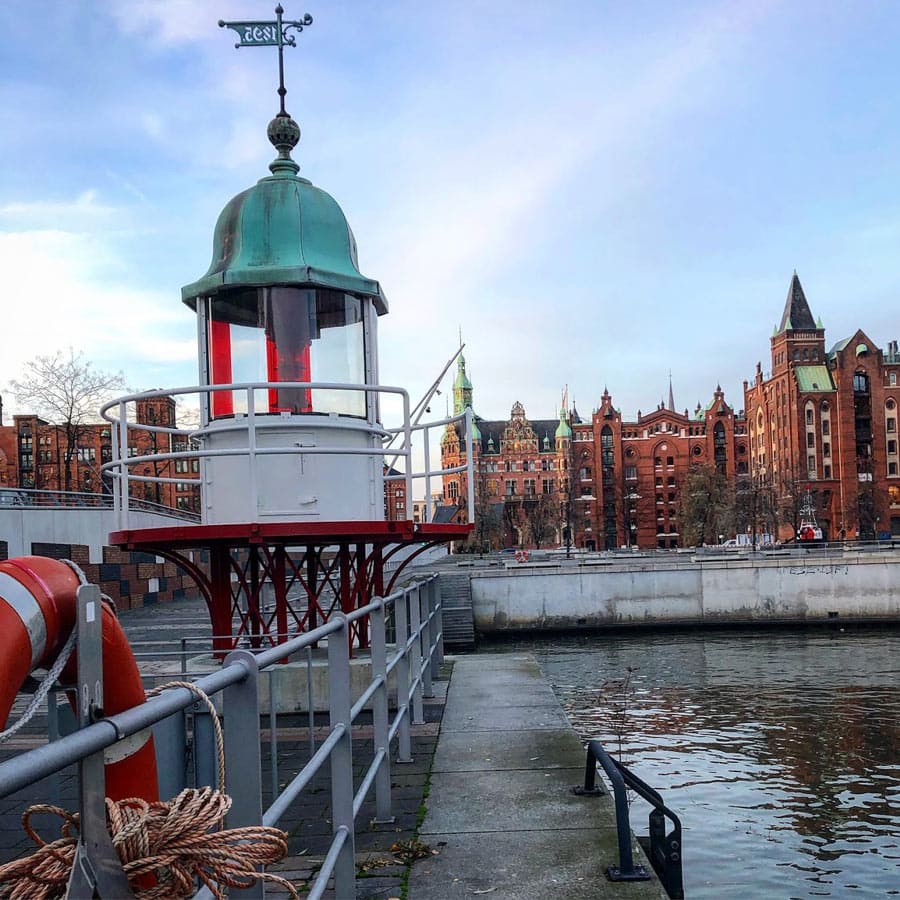
I know I’m guilty of this but many people who visit Europe want to jam their itinerary with multiple cities — after all, it’s so hard to choose where to visit.
However, moving around a lot can get expensive. First, there’s the extra transportation expense (trains, planes, etc.) and then you’re also losing time.
Next, some hotels and rental apartments will give you a slight discount if you book for a week and an even bigger discount if you book for longer.
Focusing on a small region also gives you more time to explore the area and to get to know it better — which I feel ends up being a much more rewarding trip.
How To Save Money On Sightseeing

You visit Europe for the sights but that doesn’t mean you need to spend all your hard-earned money seeing everything! Here are some money-saving tips:
Invest In A Guidebook
Despite their drawbacks, I still think guidebooks are an excellent resource for travel information and they can help you get the most value out of your trip. If nothing else, guidebooks help you make the most of your trip so you don’t waste your precious vacation time.
Both Lonely Planet and Rick Steves guidebooks are geared toward independent, budget travel but Lonely Planet is a little more focused on a younger demographic.
Visit The Tourism Office
Every city will have a tourism office and in many cases, they’ll have resources like free city maps and free wifi. They can also be a good resource about fun local things that are going on in town
City Passes and Sightseeing Cards
Most cities have some form of tourism card that gives you access to museums, cultural sites, and other touristy attractions. These cards can actually end up saving you a lot of money but other passes end up either being a waste of money — it really depends on your travel style.
When evaluating a city pass, it’s important to look carefully at what the pass includes and if those things actually look interesting to you.
Here are the general guidelines for how I evaluate the value of sightseeing passes:
- What It Covers: Many passes are loaded with tacky things like wax museums but skimp on cultural attractions (i.e. museums, etc.). So study the pass to see if you actually want to visit the attractions it covers.
- Pass Utilization: Sure, you can save a lot of money if you visit 5 different things in a day but that’s no way to travel — I try to limit myself to one or maybe two museums in a day, and then I might do another non-museum attraction. Trying to see too much is a surefire way to get burnt out.
- Cost Without The Pass: Most passes cover two or three “big ticket” attractions so the pass is rarely worth it if you don’t do those. The passes also tend to cover a lot of “cheaper” attractions that might only cost $5-$10/ticket so you’ll have to visit multiple sights to get your value’s worth.
In cases you’re interested, I’ve already written reviews of multiple city passes:
- London Pass Review
- Paris Pass Review
- Go Berlin City Pass Review
- Rome & Vatican Pass Review and the Go Rome Pass Review
- Vienna Pass Review
- Dublin Pass Review
- Stockholm Pass Review
- Go Barcelona City Pass Review
- New York City Pass Review
- Go Madrid City Pass Review
- Amsterdam Pass
- Gothenburg Pass
- Helsinki Pass
Free Museum Days
Most cities in Europe have one day a month when all the museums are free. For example, museums in France are free on the first Sunday of the month and many attractions in Italy are also free on the first Sunday.
Some individual museums have weekly free days or they’re free after a certain time of day.
Note: Free days/times at museums attract a huge crowd so expect it to be a little more crazy than normal.
Take Free Walking Tours
Nearly every city in Europe has free (aka pay-what-you-wish) walking tours and they’re an excellent way to see a new city while also learning a bit about its history.
Mix In Free Attractions With Paid Attractions
I like to pad my sightseeing with free things like parks, monuments, or simply exploring a neighborhood. These activities also force you to slow down a bit so you’re not rushing from attraction to attraction.
Enjoy A Leisurely Drink At A Sidewalk Cafe
While you’ll probably pay a premium for a beer or glass of wine at a sidewalk cafe, it still makes an excellent way to spend an hour or so relaxing and people-watching.
Search For “Free Things To Do In X”
A good guidebook will tell you about free attractions but there are often free concerts, events, shows, galleries, etc. happening on any given day. That’s why I always do a quick search for free things before arriving to see if anything looks interesting.
Pre-book Your Museum Tickets
Ok, pre-booking your museum tickets online won’t really save you any money but it can save you from spending hours waiting in line — and time is money, right?
In fact, some cultural sights require everyone to pre-book tickets but they split the available tickets between normal visitors and tour groups. Therefore, once the normal tickets are sold out, you’re forced to take a more expensive tour if you want to visit.
Walk or Bike When Possible
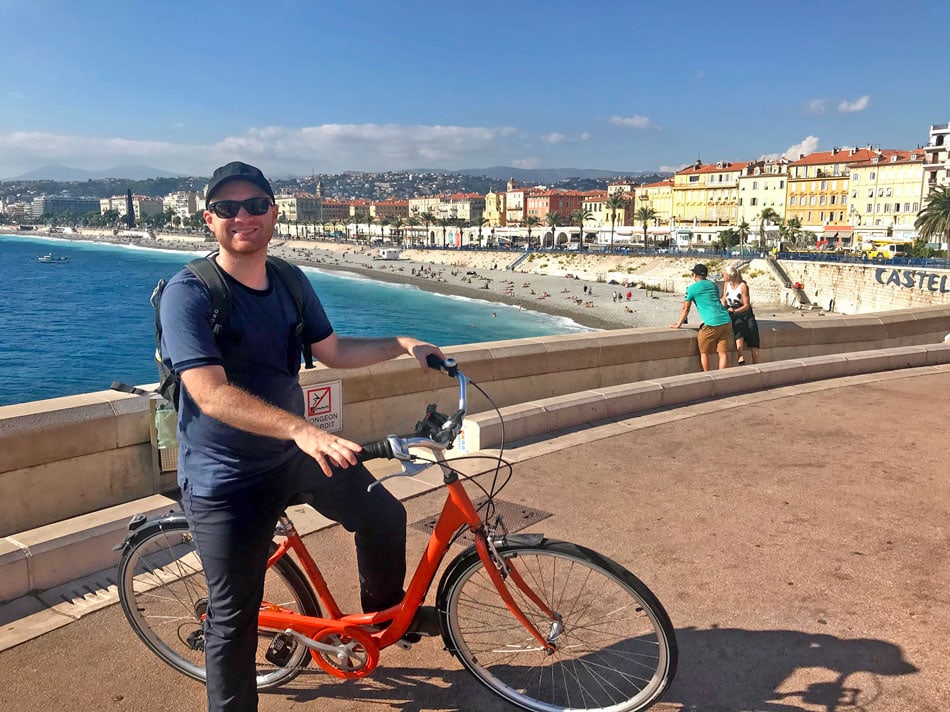
Exploring a city on foot or with a cheap rental bike is not only a great way to save money but it’s an excellent way to get to know a city.
For example, I love the Paris metro. However, if I can walk to my destination in 30-45 minutes I’d rather do that and see the amazing city than using the subway where I see nothing. And then you can spend the €2 you would have spent on a ticket at the bakery instead — win-win!
Many European cities now have free/cheap bike rental stations and this is another fun way to experience a city.
Rent A Car (For Group Travel)
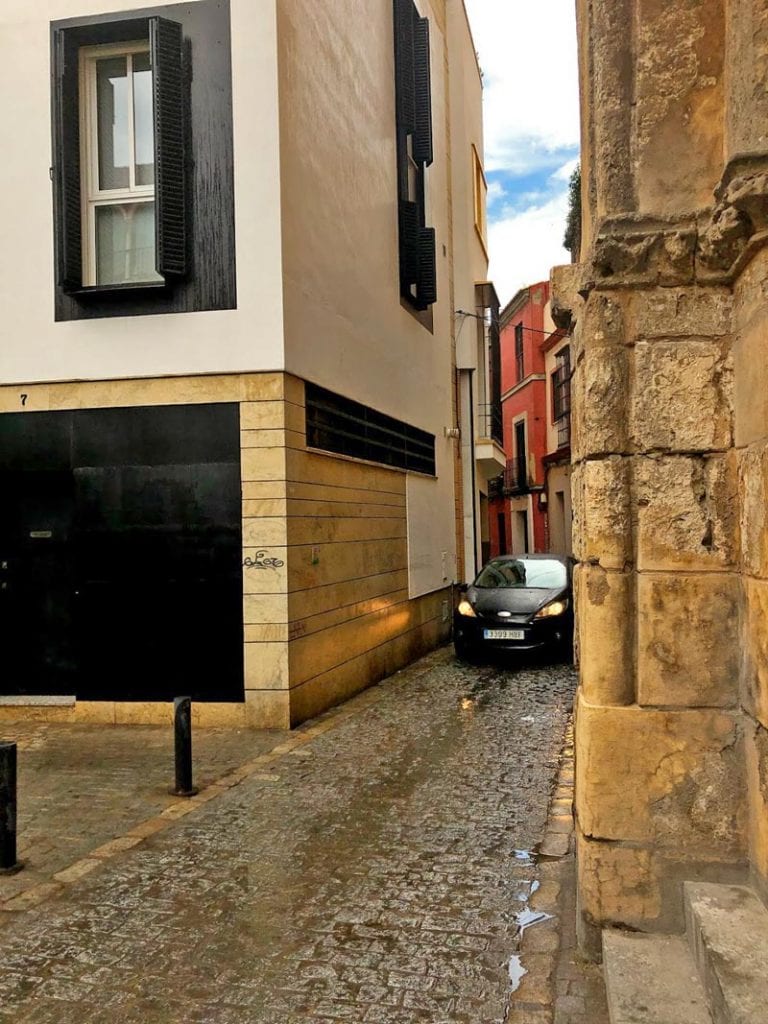
I’m not a huge fan of driving in Europe because it’s expensive (gas, tolls, insurance, parking, etc.) but if you’re in a group of 3-4 people a car can actually be a very affordable way to get from point A to point B.
That said, driving in any European city is a nightmare so I recommend parking outside the city if you’re driving.
I’ve used AutoEurope in the past to book my rental car because they search multiple car rental companies. Read my guide to renting a car in Europe for more tips.
Travel Europe By Bus

The cheapest way to travel around Europe is by bus and it actually has a very extensive long-distance bus network. Granted, the bus will be much slower than the trains since trains travel 2-3x faster and there is no traffic, but it will be cheaper.
Many of these long-distance bus companies will have random deals with super cheap advance fare tickets that are as cheap as €5. You can search for bus fares/routes on Omio .
Another possible way to travel around Europe cheaply is via carpooling with people who are already making the same trip. The most popular service is BlaBlaCar (it’s basically Airbnb for ridesharing) and they make matching up drivers and riders easy.
Avoid Tourist Scams
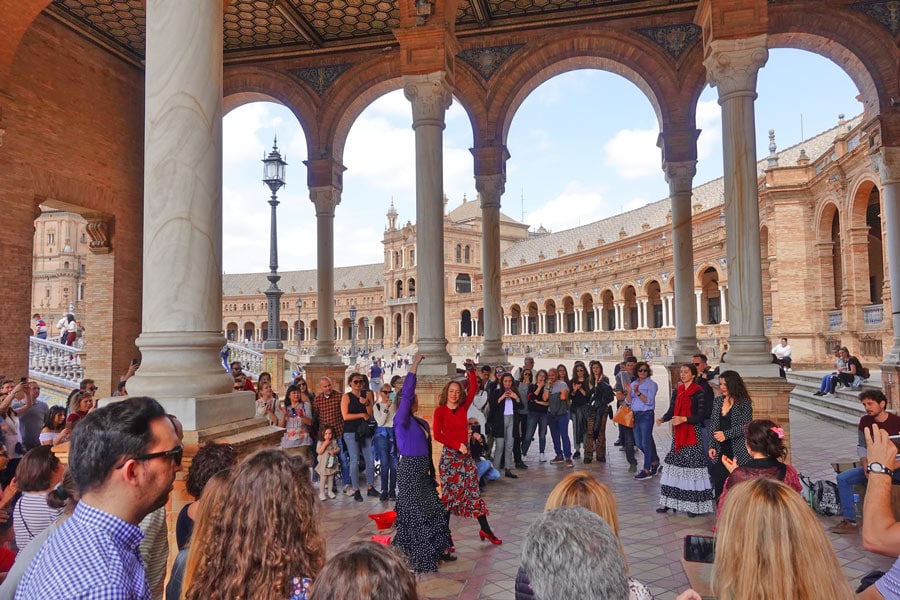
It’s one thing to spend too much money while traveling but getting scammed is another.
Let me start by saying that the chance of getting scammed or pickpocketed in Europe is low but it’s smart to know what scams are out there. Here is a list of Travel Scams in Europe but below are the most common:
Pickpockets
Any city that attracts a lot of tourists will have pickpockets — which is why Europe has gained the reputation of a pickpocket hotspot. Here are some things to pay attention to:
- Beware Of Crowds: Busy streets, subway cars, buses, trains, and places with a lot of tourists are where pickpockets strike.
- Smartphones Attract Thieves: Thieves love smartphones because they’re easy to steal and easier to sell. One of the most common places phones are stolen are off tables at sidewalk cafes.
- Lock Your Zippers: You can get little luggage locks for your bag’s zippers and this is enough to stop a pickpocket.
- Beware of Distractions: Most pickpockets work in teams. One person distracts you with a map or something similar, and the other person swipes your stuff. Groups of little kids are often used as distractions.
- Watch Your Wallet: Keeping your wallet in your back pocket is a pickpocket’s dream so keep it in your front pocket.
- Money Belt: Money belts are a popular way to hide valuables under your clothing.
Credit Card Skimming
I covered this earlier but credit card skimming (aka cloning) is very popular in tourist areas. The best way to prevent skimming is to not let people take your card out of sight and to check ATMs to ensure they haven’t been tampered with.
Some cities/countries have a well-earned reputation for taxi scams. Do your research on normal taxi prices and common scams to keep yourself informed — and don’t be afraid of speaking up if you feel like you’re being scammed.
Research Your Phone’s International Data Plan

Don’t return home from your trip to Europe to find a huge phone bill. Spend some time researching if you can use your smartphone’s data plan. Some plans give you free data in Europe and some let you pay extra to get high-speed data while abroad.
You also have the option to buy a new SIM card while in Europe — which is often the cheapest option but it’s a bit of a hassle.
Hit Up The Dating Apps
One way to experience a city like a local is by meeting up with a local — which is why many travelers are logging into their dating apps as they travel.
- Recent Posts
- The Best Travel Backpacks | In-Depth Buyer’s Guide & Backpack Reviews - April 28, 2024
- Best Prepaid UK eSIM | Data Plan Buyer’s Guide - April 21, 2024
- How to Avoid Pickpockets in Europe — Tips for Outsmarting the Thieves - April 19, 2024

No Funny Business
The Savvy Backpacker is reader-supported. That means when you buy products/services through links on the site, I may earn an affiliate commission—it doesn’t cost you anything extra and it helps support the site.
Thanks For Reading! — James
Questions? Learn more about our Strict Advertising Policy and How To Support Us .
Related Reads
Itinerary planning advice for backpacking europe on a budget.
Choosing well-researched itinerary is essential for budget travelers. This guide will help you make the most of your time & money.
Money & Budgeting , Planning
How To Buy a SIM Card In France | Guide to High-Speed Mobile Data in France
Your guide to using SIM cards and mobile data plans in France.
How To Buy a SIM Card In Spain | Guide to High-Speed Mobile Data Plans in Spain
Your guide to using SIM cards and mobile data plans in Spain.
Money & Budgeting , phones and technology , Planning
How To Buy a SIM Card In Italy | Guide to High-Speed Mobile Data in Italy
Your guide to using SIM cards and mobile data plans in Italy.
City Guides
Choosing travel insurance, travel packing lists, budget travel newsletter.
The best budget travel tips sent straight to your inbox.
Join My Journey
Europe travel tips, advertising & privacy policies.
TheSavvyBackpacker.com is a participant in the Amazon Services LLC Associates Program, an affiliate advertising program designed to provide a means for sites to earn advertising fees by advertising and linking to amazon.com.
© 2010 - 2024 The Savvy Backpacker
Website Design by FHOKE
- EN - English
- PT - Portuguese
- ES - Spanish
- How it works
- Become a Host
- Download the app
Top Destinations
- United States
- United Kingdom
What type of experience are you looking for?
- Non-Profit School
- Permaculture project
- Eco Village
- Holistic Center
- Guest House
- How Worldpackers works


Learn from the most experienced travelers of the community
Traveling with worldpackers, planning and budgeting for travel, make a living while traveling as a lifestyle, travel with worldpackers.
- Using Worldpackers
- Work exchange
- Social impact
Plan your trip
- Women traveling
- Budget travel
- Solo travel
- Language learning
- Travel tips
- Get inspired
- Digital nomads
- Travel jobs
- Personal development
- Responsible travel
- Connect with nature
Top destinations
- South America
- Central America
- North America
- More destinations
- WP Life WP Life
- Exclusive discounts Discounts
- Europe travel tips
What is the average cost of a trip to Europe?
A summary of what a trip to Europe may cost, based on different travel styles, time frames, and destinations.
Gabrielle Budget Travel With Gabby
Mar 05, 2024

Europe is one of the most fascinating continents in the world. With 44 countries packed into a relatively small area, you can hop from country to country quickly and cheaply.
And between each country, the landscapes, cultures, and histories vary so much. You can jump on a bus or train for a few hours and end up in a completely different world from where you started.
Currency, language, architecture, traditions, cuisine, and lifestyles are so different in various European countries. It’s such an amazing place to travel because you can experience and learn so much in a shorter time than you could on other continents.
So for anyone who is planning a trip to Europe , you may be wondering how much money you need. As a whole, Europe is one of the more expensive continents to travel around. South America or Asia would be much cheaper.
But it is possible to explore Europe on a budget . And it is important to note that every traveler is different, so the average cost of a trip to Europe could vary greatly from person to person.
But we’ll provide a general Europe trip budget that can be used as a guideline. We’ll also explain some of the main factors that may affect your Europe trip cost, such as where you go, how long your go for, and your travel style. So let’s dive into the average cost of a trip to Europe.

Important to consider when creating a Europe trip budget
The cost of a European vacation will be different for every person because every traveler is different. But there are some factors that will greatly influence your Europe trip cost . Here are some important things to consider when planning a trip to Europe and estimating how much money you will need.
Some countries are cheaper than others
As I mentioned earlier, countries in Europe are completely different from each other despite being so close together geographically. When thinking about the average cost of a trip to Europe, it is important to think about which countries you will be visiting .
Generally speaking, countries in Eastern Europe are much more affordable than countries in Western and Northern Europe. Most tourists tend to head to Western Europe, whereas the eastern side of the continent isn’t as touristy. That means you get much better value for money in the east.
Some of the cheapest countries to visit in Eastern Europe include Albania , Romania , Bulgaria , Serbia , Montenegro , Hungary , and more. Countries like Greece and Croatia are a bit more touristy and expensive, but they are still generally cheaper than Western Europe. If you spend more time in these countries, your money will go much further.
The most expensive countries in Europe to visit include France , England , Sweden , Norway , Denmark , Switzerland , and Germany . All of these are in Western or Northern Europe, with Scandinavia being one of the most expensive regions in the world. If you spend lots of time here, you’ll need more money for your trip. Countries that are mid-range include Italy, Portugal, Czech Republic, Poland, Slovakia, Austria, Spain, Latvia, and more.
What is your travel style?
Another factor that will affect the average cost of a trip to Europe is your travel style. Are you a frugal budget traveler? Or do you enjoy luxury? The way you choose to spend your money will greatly affect your Europe travel budget.
For example, a luxury travel style may look like this: staying in 5-star hotels, eating in nice restaurants, getting cocktails in bars, booking expensive excursions and guided tours, shopping for clothes or souvenirs, taking private taxis everywhere, etc. This type of travel style means you will need a lot more money than the average person.
A budget traveler in Europe may have a travel style that is more like this: staying in backpacker hostels , couchsurfing, doing work exchanges , cooking their own meals, eating street food, taking public transport, hitchhiking, prioritizing free attractions, avoiding tourist traps and souvenir shops, flying budget airlines, drinking cheap beer and wine at happy hours, shopping at local markets, etc. With this type of travel style, you won’t spend as much money so you can do more with a smaller budget.
A mid-range traveler will be somewhere in between. It’s a good idea to have balance while traveling. You can travel longer with less money if you use some budget travel tips, but it’s fun to treat yourself as well.
Work exchanges are a great way to travel in Europe because you can save money on accommodation, get to know the locals, and use your saved money for other things like tours and attractions. Some examples of popular work exchanges in Europe include:
- Work in an organic kitchen at a sustainable community in Germany
- Volunteer at a permaculture project in Bulgaria
- Help take care of the local dogs at a homestay in Spain
- Work as a yoga teacher on an island in Greece
- Help with gardening and animal care at a guest house in Sweden
- Take care of the horses at a homestay in Ireland
- Work at a fun, social hostel in Croatia
- Learn to grow food at an eco farm in Slovenia
- Work with a local family at a winery in Italy
These are just a few examples of top-rated work exchanges in Europe where you can lower your trip costs.

Average cost of traveling to Europe on a budget
For the purpose of this article, I’ll be breaking down the average cost of traveling to Europe on a budget . This is the bare minimum you’ll be spending on your trip if you travel on a backpacker budget. So take into account your travel style and tack on more money accordingly.
Accommodation
Budget travelers in Europe have a few different options for accommodation . Hostels, work exchanges, and couchsurfing are the most popular. All of these options are significantly cheaper than staying in a hotel.
One night in a hostel dorm room in Europe will cost around 20 Euros , on average. This will vary depending on where in Europe you are staying. For example, expensive cities like London , Paris , Reykjavik , Amsterdam , Berlin , Stockholm , or Interlaken will have prices closer to 30 Euros per night. Cheap cities like Warsaw , Budapest , Sofia , Bucharest , and Tirana will have prices closer to 10 Euros per night.
And if you want to find free accommodation in Europe , work exchanges or couchsurfing is the way to go. Accommodation is usually the biggest expense while traveling, so finding free places to stay will significantly lower the average cost of a trip to Europe.
For a work exchange, you’ll work around 20 hours per week to get free accommodation and sometimes free meals. Couchsurfing is another option - It's an online platform where you can find locals that open up their homes to travelers for free.
Average cost of meals
How much money you spend on food in Europe is hugely dependent on the individual. Eating out can get very expensive, so budget travelers tend to mix in some nice meals with some cheap street food or cooking at your hostel or work exchange kitchen.
The cost of a meal in a restaurant also varies greatly around Europe. An average estimate is also about 20 Euros per meal . Lunch and breakfast are usually cheaper than dinner, especially if drinks are involved. In Western Europe, you’ll easily spend 20 Euros on just breakfast or lunch with a coffee or drink. Dinner could be 30 or 40 Euros with wines and cocktails. In Eastern Europe, you can eat a massive meal in a restaurant for 15 Euros or sometimes less.
Street food and cheap takeaway places around Europe sometimes sell sandwiches or meals for around 10 Euros. So if you’re a budget traveler, let’s say you’d spend an average of 30 Euros per day on food . Again this will vary, especially if you’re doing a work exchange and you get some or all of your meals provided. But if you’re buying some groceries, snacking on street food, and eating out for one meal a day, you’d spend roughly 30 Euros on average.
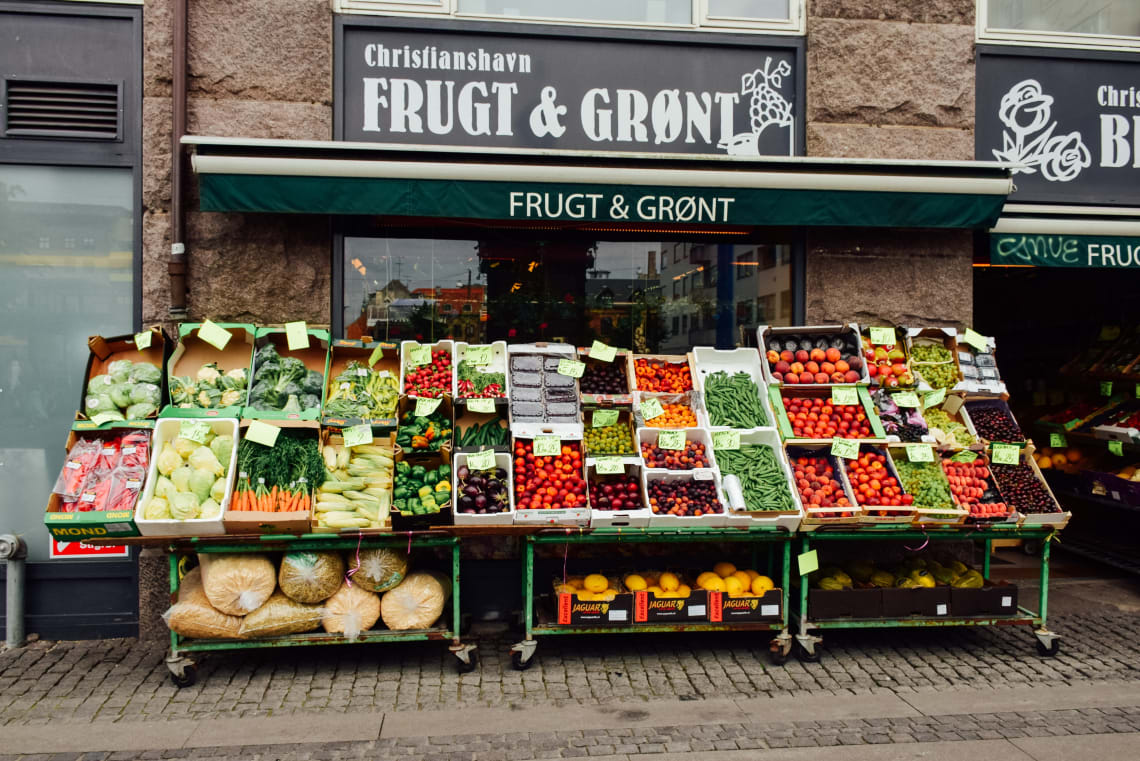
Transportation in Europe
If you’re a budget traveler, stick to public transport to save money . The amount you’ll spend on transport depends on where you are and how far you want to venture. Many cities in Europe are walkable, so if you get some comfy shoes you can walk to many attractions. But if you’re traveling in more rural areas, public transport, taxis, or renting a car may be necessary.
For the sake of this article, let’s just say you’re staying in a city. To get from place to place, you take public transport, whether it be the train , bus, metro, or anything else. You try to walk as often as possible. Public transport is usually affordable around Europe, even in expensive cities like London. A single journey is only a couple of Euros .
So in one day in a European city, you’ll probably spend around 10 Euros on public transport . Some days you may spend more, such as when you travel to and from the airport or take day trips, which usually cost more than an inner-city journey. But some days you may not use any, so we’ll say 10 Euros is average.
European attractions
Europe is full of touristy, paid attractions, and free attractions. Many churches, beaches, lookouts, museums, markets, statues, parks, gardens, and galleries are free around Europe -but many have a steep entry fee.
The average cost for museums and galleries around Europe is 10-20 Euros. Day tours are around 100 Euros, but lots of stuff is free as well. We’ll put an average spend of attractions at 20 Euros , to account for the cheaper and the more expensive options.
Keep in mind, this is just an estimate. Extreme budget travelers can very easily avoid paid attractions and just enjoy the sights around Europe for free. So you could definitely spend less than 20 Euros per day. But you also don’t want to miss out on things.
So to recap, the average cost of traveling to Europe on a budget is:
- Accommodation: 20 Euros per night
- Food: 30 Euros per day
- Transportation: 10 Euros per day
- Attractions: 20 Euros per day
This will vary from person to person, and of course, costs will be lower if you’re sticking to Europe’s cheaper countries. But it’s just a quick estimate.
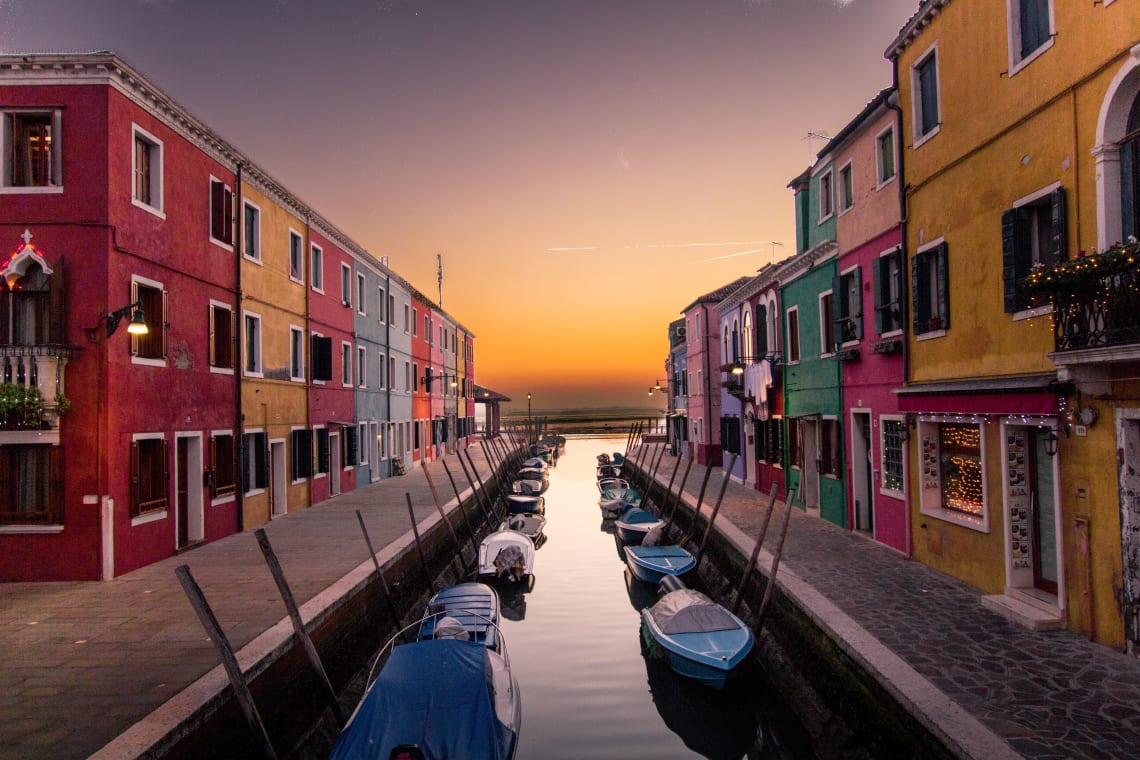
Average cost of a 2 weeks trip to Europe
Now let’s look at a two-week trip to Europe. Based on the information I just gave, you have an idea of what the daily expenses look like for a budget travele r in Europe. I’ll now summarize what the average cost of a 2 weeks trip to Europe might look like for each type of budget range (backpacker, mid-level, and splurge).
Backpackers traveling through Europe will be sleeping in hostels or doing work exchanges , cooking some meals at home, eating at cheap local restaurants or street markets, drinking local alcohol, and choosing free attractions.
Based on the prices I estimated in the above section, here is what 2 weeks in Europe may look like for a budget traveler:
- Accommodation: 20 Euros per night for 14 nights = 280 Euros
- Food: 30 Euros per day for 14 days = 420 Euros
- Transportation: 10 Euros per day for 14 days = 140 Euros
- Attractions: 20 Euros per day for 14 days = 280 Euros
So for 2 weeks in Europe, a budget traveler may spend around 1,120 Euros . This could be lower if you budget to the extreme. Keep in mind, a work exchange cuts your accommodation costs down to 0, and your food, transport, and activity costs may be lower as well depending on what your host offers.
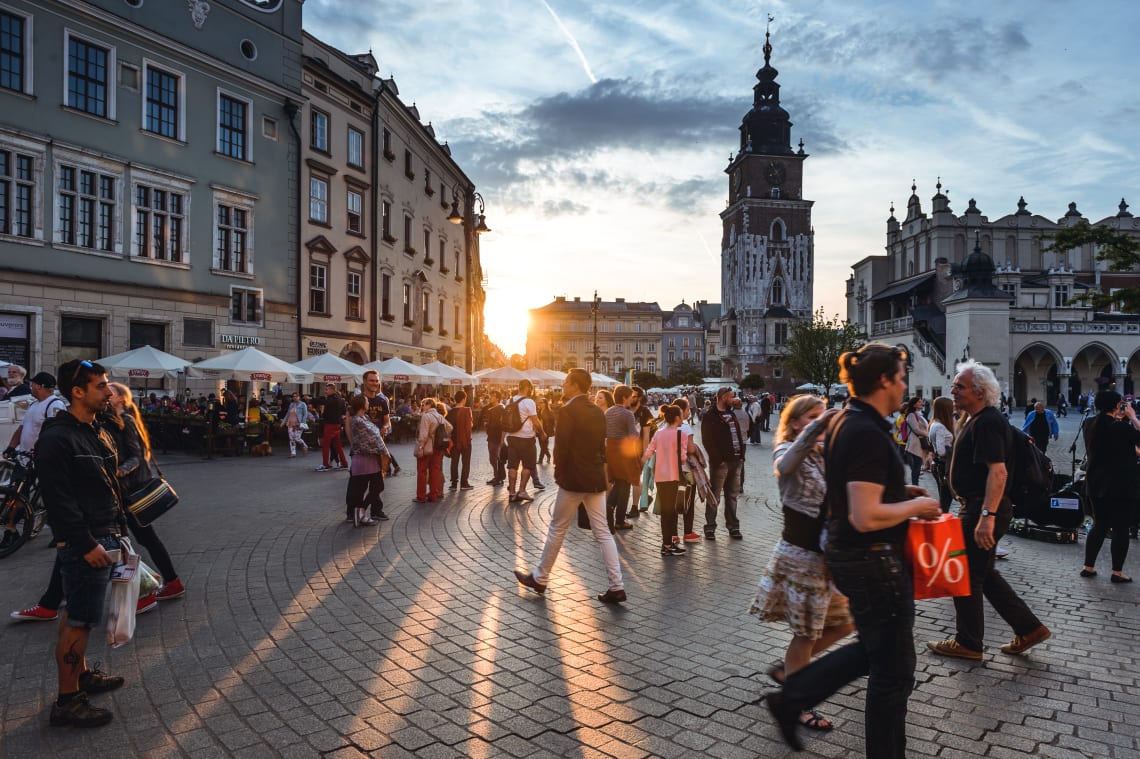
Mid-level budget
Two weeks in Europe on a mid-level budget will give you a combination of budget travel tips as well as plenty of opportunities to treat yourself. You may stay at a few hostels and a few nicer hotels, or maybe you’ll spend all of your time in affordable budget hotels.
You may also eat out somewhere nice once per day, and mix in some nights out with some affordable meals. Transportation will still be relatively low , unless you opt for taking taxis instead of buses or metros. And attractions will be about the same, with maybe a few expensive day trips or tours to take your trip to the next level.
Here is an estimate of what 2 weeks in Europe might look like for a traveler with a mid-range budget:
- Accommodation: 40 Euros per night for 14 nights = 560 Euros
- Food: 40 Euros per day for 14 days = 560 Euros
- Attractions: 50 Euros per day for 14 days = 700 Euros
So your total might be around 1,960 Euros for two weeks.
Splurge in Europe
If you have a budget with no limits, you can really live like a king or queen in Europe . There are so many fancy hotels, restaurants, and services that you can indulge in. The real luxury options will have outrageous price tags that suit the rich and famous, but even if you’re an average person who wants to splurge, you can keep the budget reasonable without missing out on anything.
Splurging in Europe, within reason, means staying at nice hotels, taking taxis, dining out, getting cocktails, and booking every attraction you want to regardless of the fees. Here is an overview of what two weeks in Europe on a high budget may look like:
- Accommodation: 200 Euros per night for 14 nights = 2,800 Euros
- Food: 80 Euros per day for 14 days = 1,120 Euros
- Transportation: 30 Euros per day for 14 days = 420 Euros
- Attractions : 70 Euros per day for 14 days = 980 Euros
That adds up to 5,320 for two weeks of luxury in Europe. This could easily be more, but it’s just a starting point.

Average cost of a trip to Europe wrap-up
The main factor you should take away from this article is that you are in charge of your own trip. These estimates are designed to help you formulate your own budget that suits your destinations and your travel style.
Also be sure to budget for flight costs , travel insurance , and any other purchases you think you might make abroad. And if you’re looking for the best way to cut costs while traveling in Europe, work exchanges are the way to go.
Check out our full list of work exchanges in Europe if you want to save money during your trip!
Join the community!
Create a free Worldpackers account to discover volunteer experiences perfect for you and get access to exclusive travel discounts!
Gabrielle Boucher
Budget Travel With Gabby
Hello! I am a 25 year old from the USA with a knack for traveling on a budget. I fell in love with traveling while studying in Europe, and that love grew even more when I started volunteering abroad in South America. Since then, I've worked odd jobs and volunteered all over the globe while cultivating passions for hiking, wildlife photography, food, wine, animals, permaculture, and more!
Be part of the Worldpackers Community
Already have an account, are you a host, leave your comment here.
Write here your questions and greetings to the author
May 10, 2023
my name is Arslanbek I need a job I can assemble furniture can you help me
May 14, 2023
How to pour from me
Jul 10, 2023
How to come...........?
I'm interested how can I contact you?
More about this topic

Germany on a budget: a guide with the best tips and the cheapest places to visit
Best way to travel europe: all you need to know to plan your trip.
Backpacking through europe: all you need to know
How do worldpackers trips work.
As a member, you can contact as many hosts and travel safely as many times as you want.
Choose your plan to travel with Worldpackers as many times as you like.
Complete your profile, watch the video lessons in the Academy, and earn certificates to stand out to hosts.
Apply to as many positions as you like, and get in contact with our verified hosts.
If a host thinks you’re a good fit for their position, they’ll pre-approve you.
Get your documents and tickets ready for your volunteer trip.
Confirm your trip to enjoy all of the safety of Worldpackers.
Have a transformative experience and make a positive impact on the world.
If anything doesn’t go as planned with a host, count on the WP Safeguard and our highly responsive support team!
After volunteering, you and your host exchange reviews.
With positive reviews, you’ll stand out to hosts and get even more benefits.

- January 19, 2022
Budget for a trip to Europe: How much do i need?

Table of Contents
That Europe is one of the most sought after destinations for tourism travel everyone already knows, we even have a list of 5 most visited countries in Europe and their incredible sights that certainly corroborates this conclusion! However, planning this trip can be a difficult task, since there are so many things to think, research and organize that can leave you lost, even more with the high costs that are a big problem for your plans, right? That’s exactly why we are here! We can help you with the basics or, if you prefer, you can start by taking a look at how to plan a trip to Europe during the pandemic and then come back here to create your budget for a trip .
So, have you gone and come back? Or did you prefer to stick around here? Well, roll your mouse over and find out all you need to know about how to make a cheap trip to Europe !
ON THE POINT: Writing down expenses
To plan a trip you should go through a basic itinerary of where you want to go, how many days you intend to stay, which places to visit and make reservations . This will all be part of your budget. As we are here to help you we recommend that you take into account two very important things: the external conditions and the standard expenses .
External conditions
When we talk about external conditions, we talk about a tip that can change everything! This is because each one of them greatly influences your pocket when it comes to buying and booking. They are:
- The country : some countries are cheaper than others and the difference can be quite significant, as you can check in Little Money: 3 countries to visit in Europe with little money ,
- The period : times with less tourist movement is called low season, and this term, like its name, is synonymous with low prices, ranging from tickets to accommodation and attractions.
- The European currency quote : the value of each currency is constantly changing and it is important to be aware of its current value to catch its best times.
Standard spending
The standard expenses are the essential costs of the trip – or at least the basics of a complete and still economical trip – that you should write down considering the above conditions and the time you intend to stay abroad:
- Return air tickets;
- Travel insurance;
- Accommodation;
- Tourist attractions.
Now that your expenses are organised, open your browser, take out your pencil, paper and calculator and get to work!
WHAT TO DO TO SAVE MONEY?

Before starting the calculations, it is best to follow a few steps thinking about the external conditions of your trip, so you will have an overview of the expenses, besides finding the cheapest prices for when you calculate the rest of your budget for a trip.
Step one: plan everything in advance!
- When it comes to planning, even more so when you want low prices, you have to be willing to be flexible with dates and times , plus the earlier you book the better it is!
- So the first step for your planning and subsequently your budget is to choose dates well ahead, such as booking tickets 2 to 6 months in advance .
Step two: look for a cheap city!
- The cities located in Eastern Europe are a bargain! With a list that includes Budapest , Krakow , Istanbul , Prague and Sofia and prices of up to 40 euros per day .
- Others between Greece, Italy, Spain and Portugal have a cheap average spend, between 50 and 60 euros per day .
- And there are still some very popular tourist destinations such as Berlin , in Germany, London , in England, Paris, in France, and Rome , in Italy, as well as Amsterdam , Barcelona , Brussels and Lisbon , with average prices ranging from 60 to 70 euros per day .
Step three : choose the best time!
- The period of your trip matters a lot, after all you can catch the low season at the right times, besides, of course, less suffocating with queues and crowds.
- In most places it occurs in the winter period as seen in some countries mentioned in 5 incredible places to visit in the European winter , starting in late autumn . From November to March are the months with the lowest prices .
- Spring is also a good time. In general, the landscapes in the season of dry leaves and flowers in bloom are beautiful and unite natural beauty with good prices.
Step four: keep an eye on the European currency!
- The value of the European currency changes constantly and even small amounts make a big difference when it comes to paying.
- Many hostels and locations only accept European currency.
- Therefore, you have 2 options: one is to convert it when calculating the expenses, always keeping in mind a margin of error; and the second and more practical option is to exchange the currency of your country for the Euro, so you reduce the difficulties of your trip.
- As the currency can overvalue or depreciate depending on the weather, it is good to exchange in advance.
- Also bear in mind that although the Euro is the official European currency, some regions make use of other currencies such as England with the Pound Sterling and the Swedish Krona and Czech Koruna , respectively of Sweden and the Czech Republic.
Step five: search for reliable sources and websites!
- Once you find it, you can search and book (in advance) your tickets and accommodation.
Lean more at How Much Does it Cost to go to Europe?
PRE-TRIP EXPENSES
After following the recommended steps, start to really calculate each of the standard expenses, starting with those that must be done in advance, because then it is less of a worry and it is enough to save for when the day of the trip comes.
As the item that should be purchased the furthest in advance, tickets should be your priority, and remember:
- As the goal is cheap tickets, we will follow the previous tips aiming at the low season period;
Flights booked in December with a date in March of the following year, that is 3 months, 4 days of stay in the city, being the time that interchanges the outward and return trip, and for 1 adult in economy travel, stay around
- Flight with (1) connection NY – Lisbon: from 181,22 euros;
- Direct flight NY – London: from €257.73;
- Direct flight NY – Paris: from 250.83 euros
- Direct flight NY – Rome: from 316.04 euros
* These cities were just some examples, the values may change depending on the place of embarkation and disembarkation.
Ps: don’t forget to look for flexible airlines! So, if necessary you can change the date of your trip without problems or having to pay extra for it.
Travel insurance
I’ m sure you’re already tired of hearing about travel insurance when it comes to Europe, right? But that just goes to show how essential it is. And if you’re lost about it, we recommend you check out how to travel safely to Europe during the pandemic in 2023 to learn how important it is. But to put you in context, this obligation is a guarantee that, in case you have an accident or something similar happens, you will be able to pay for the medical-hospital expenses.
So what do you need to know about them for your budget for a trip?
- Which countries require travel insurance . Not all of them, but many countries do, including the member countries of the Schengen Treaty (if you haven’t seen the first article mentioned, take the opportunity to check it out now, there is a list of all of them);
- What insurance covers . Of the main services offered from travel insurance, medical-hospital and pharmaceutical costs are top of the list, however insurance still covers other issues such as:
- Flight cancellation due to medical emergency or otherwise;
- Tracking and compensation in case of lost luggage;
- Compensation for disability or accidental death, as well as funeral assistance;
- Legal costs and bail bonds;
- The best plan for you . Depending on the length of your trip or what collateral you find most essential, you can choose an insurance plan that covers what you want, for the most affordable price. You can do this using simulators.
- The price of insurance is from 2,35 euros per day;
- From 13,80 euros per day without luggage insurance;
- And a more complete plan around 20 euros per day.
Ah, keep an eye on the European Travel Visa! Soon the Schengen Visa Waiver will come into effect, which will have a fee for the service, but its cost-benefit is also great, as it will be valid for 3 years. You can see more in United States and Europe: will you need a visa in 2023 ?
Accommodation
As well as the time of year, the country and the location of the accommodation you choose will also influence the price of the accommodation you choose, whether it is a simpler or more elegant hostel, budget hotels or flats for rent, always keeping the focus on the low price.
Best hostel options
- Lisbon (daily rate – 1 person): from 12,49 to 78,47 euros;
- London (daily rate – 1 person): from 12.24 to 70.39 euros;
- Paris (daily rate – 1 person): from 21,81 to 39,08 euros;
- Rome (daily rate – 1 person): from 12.56 to 53.52 euros.
Best options for flats
- Lisbon (daily rate – 1 person): around 53.83 to 152.86 euros;
- London (daily rate – 1 person): from around 47.87 to 166.67;
- Paris (daily rate – 1 person): from 45.36 to 137.64 euros;
- Rome (daily rate 1 person): from about 55,40 to 180,80 euros;
Best hotel options
- Lisbon (daily rate – 1 person): from 12 euros;
- London (daily rate – 1 person): from 18,05 euros;
- Paris (daily rate – 1 person): from 24.48 euros;
- Rome (daily rate – 1 person): from 33,27 euros.
Expenses during the trip
Now that you have seen the expenses before the trip, you need to know how much you will spend during the trip, which on average is around 50 euros per day for one person. Let’s break this down?
Sightseeing and tourist attractions
When talking about saving money, you have to be aware that it requires a lot of searching. Attractions are no different. They can vary a lot, from attractions that cost nothing or have very low prices , as is the case of Serra da Estrela, in the Portuguese winter period, or can be quite high, depending on its fame and how much is demanded.
However, on average the cat cost with attractions is 20 euros per day for a person, enough to visit the main sights. Even because, with the incredible landscapes
that there are, walking a little bit through the streets enjoying the view, is one of the best experiences and doesn’t cost anything! Of course you don’t have to miss out on an attraction you like because of the price, just make sure you control how many you go to so you don’t lose your hand on the budget and a lot of money in your pocket.
Transport when travelling is essential, especially if you don’t want to get lost in unknown lands. And it is even possible to go from city to city only with train rides , so it is a very interesting expense, don’t you agree? But you have to think well about the cost-benefit before spending. So, decide if you want to stay in one city only or travel between several.
- If you choose to stay in only one city, bus or train rides are very cheap, ranging from 1 to 3 euros . You can also buy 24 to 72 hour passes.
- From Lisbon to Madrid: 16 euros;
- From Madrid to Rome: 26 euros;
- From Rome to Paris: 23 euros;
- From Paris to London: 38 euros.
If you are interested, read more about how to travel by train in Europe: the best itineraries!
The cost of food to be cheap just depends on you! There are many famous restaurants in Europe, but the price can be discouraging. However, you can still choose a good option, get to know the cuisine and culture you want without having to spend too much!
- The first tip is: book hotels or hostels with breakfast included ! Even if it doesn’t, opt for the cheapest, so you can spend between 3 and 5 euros .
- The same tip goes for lunch; if possible, eat at the hotel . Or just leave lunch as your “out of town” meal. A simple meal will cost you around 12,56 euros .
- For dinner, you can eat at the hotel, which is much cheaper, or you can try the fast food at those times, which are always cheaper, and can be as low as 5 euros !
- Another cheap option is the “ Tourist Menu “, going for 9 euros .
- And then there are the markets, with excellent prices and a great alternative for buying meals.
- On average, opting for good quality and still economical, your meal will be around 20 to 25 euros per day.
SUMING IT ALL UP: How much does a cheap trip to Europe cost altogether?
After writing down all the expenses before and after the trip, choosing the best periods and following the tips for an economical trip, and taking the average of tickets and hotel accommodation for 4 days, the expense that a person would have to visit Europe for four days is 500 euros . Very economical, isn’t it? With this you can even spend a little more, since it is impossible to do a tour like this and not buy anything or take souvenirs home – which by the way are an expense of about 30 euros a day! And now, do you know everything to plan a budget for a trip and start your journey?
If not, we have a complete budget for a trip: Holidays in Portugal: how much money do I need?
If so, how about doing some more extensive planning and a 10-day trip to Europe?
Want to keep up with our blog?
Get our most valuable tips right inside your inbox, once per month!
- budget for a trip , Europe , travel cheap , travel cheaply , Travel in 2022
Related Posts

Madeira Expedition: Sunrise at Pico Ruivo and Camping in Encumeada
I woke up early, around 6:30 am, my goal there was to capture the best

Madeira Expedition: Lunch at Pico do Areeiro and camp on Pico Ruivo
I woke up there in Pico Alto, it was cold, it was 8 am, I

Madeira Camping Expedition: Funchal to Pico Alto
This is the article number 1 of this series I left work on a Friday

Exploring Lauterbrunnen: A Day in the Swiss Paradise
This was a special Saturday. It was a cloudy morning, rainy weather in Switzerland, and

Swiss Hiking Adventure: Lucerne to Mount Pilatus
That day I had arranged with my cousin to go to a lake near Estavayer-le-lac.

Venice to Lucerne: Exploring Swiss Beauty and Italian Flair
We got up early in Venice to catch the flixbus to Milan. We went from
LATEST ARTICLES
© all rights reserved. 2021.


Accommodations
As you can imagine, your Europe trip cost will vary greatly depending on your style and where you visit. I recommend budgeting $150 a night for your hotel, which works out to $2,100 for 13 nights. From hostels to luxury hotels, Europe gives you many options to easily find accommodations that fit your budget.
If you’re backpacking through Europe, hostels will probably be your choice of accommodation. If you decide to go that route, the average price is $15 – $20 a night. Alternatively, there are a lot of great boutique hostels out there that cost more but offer a better experience since they’re competing with hotels and Airbnb.
Recommendations: YHA London Central (London), Barnacles hostel (Dublin), The Flying Pig Uptown (Amsterdam), Goodmorning Hostel (Lisbon)
Mid-range hotels
For those who think $150 is expensive, I would argue that it’s on the cheaper end. The reality is that hotels are expensive these days, so getting one for $150 a night is a pretty good deal. Remember, this is just an estimate. In some European countries, some hotels will cost you more while others will cost you less. You can also follow my guide on how to save money on hotels .
Recommendations: Alhambra Hotel (London), Stauntons on the Green (Dublin), Hotel Nicolaas Witsen (Amsterdam), Hotel Excelsior (Lisbon)
Luxury hotels
There will likely be luxury hotel options regardless of what city you’re visiting. If you like the experience or don’t mind spending the extra money, you may want to budget another $200 – $300 a night. Your Europe trip cost will skyrocket if you’re going for luxury stays.
Recommendations : The Langham (London), Clontarf Castle (Dublin), Amsterdam Marriott Hotel (Amsterdam), Iberostar Lisboa (Lisbon)
Depending on the city, I sometimes prefer to use Airbnb. I’ve been able to find private apartments in good locations for about $100 a night. If you’re travelling with kids or family, Airbnb can be a great deal since you should easily be able to find a space that fits your entire party. I do admit that Airbnb has become more expensive over the years, but it’s still a good hotel alternative.
If you have the right credit card, you can save a fair amount of money on hotels. Americans should strongly consider the Marriott Bonvoy Brilliant American Express Card since you can earn up to 95,000 Marriott Bonvoy points and $300 back at U.S. restaurants as a welcome bonus . Canadians should consider the Marriott Bonvoy American Express , which gives you up to 75,000 Marriott Bonvoy points. That’s enough points for a few free nights at some hotels, which could easily have a value of over $500.
Local transportation
Since I assume you’re doing thee cities during this trip, you’ll need to factor in flights and/or trains to each destination. I’m also assuming you’re booking a multi-destination ticket, so you don’t need to backtrack. Realistically speaking, budgeting $400 for location transportation may be a bit high, but remember, you must also pay for trips to/from the airport, day trips, and any other public transportation you use.
Generally speaking, getting a Eurail pass won’t be worth it if you’re in Europe for just two weeks and visiting three cities/countries. If you’re going to neighbouring countries or taking day trips, buying tickets as needed is fine. That said, buying your train tickets well in advance (even before you depart) is usually worth it, as you’ll get better prices and a confirmed seat.

Attractions
This is where things can get tricky. Attractions aren’t expensive, but if you keep going into them, you will naturally spend more. First off, always do the free things in every city. That means checking to see if any museums or art galleries have no entrance fee. Note that even museums with an admission charge (including big, famous museums like the Louvre Museum in Paris) usually have a free day, so you must see if the timing works out.
Parks are always free, and quite often, simply walking around neighbourhoods is the best way to see a new city, and that doesn’t cost you anything. In Europe, there are also many free walking tours – well, you need to pay a tip – but that’s a cheap way to learn about the city.
Finally, check to see if museum passes will help you save money. Many cities offer something such as free entry into a bunch of attractions for a fixed price for a set period of time, e.g. 24, 48, or 96 hours. You would need to do the math to see if the cost of the attractions you’re interested in makes up for the cost of the pass.
If you plan to pay for some attractions or do day trips into the countryside to see some of the local landscapes, check to see if Klook sells tickets. Buying your tickets in advance usually means you can get a small discount and skip the lines when you arrive.
Food and drink
The food and drink budget will vary by person, but a rough estimate for a meal, including drinks is as follows:
- Breakfast – $5
- Lunch – $10
- Dinner – $30
That works out to $45 per person per day, which some people think is too much, while others think it’s too low. If you like to drink alcohol, you’ll need to budget more. What I personally try to do is balance eating street/fast food with restaurants. I also go to grocery stores to get breakfast and snacks, which saves me a lot of money. Cutting back on eating out will help you see Europe on a budget.
Every city and country you visit will have some local delicacies which I highly recommend you try. To this day, I’m still mad at myself for not having tapas in Spain because I thought it was too expensive. I’m not suggesting you blow your budget on food, but it’s okay to splurge occasionally. Even then it doesn’t need to be fancy. A baguette and cheese in Paris is pretty cheap but also delicious.

Random spending
Many people forget to include shopping when planning their vacation budget. It’s silly to think that you’ll spend nothing on random things; you’ll buy gifts for people, right? Plus, you’ll want to pick up plenty of souvenirs for yourself, regardless of how tacky they appear. There’s nothing wrong with buying gifts for yourself or friends; you just want to make sure you budget for it.
As you can imagine, some cities have better shopping experiences than others, so you must consider where you’re going and budget accordingly. For example, you may be headed to Italy and intend to buy a leather purse. There’s nothing wrong with that. Just make sure you’ve set aside some money for that purchase.
As a general rule, you should set aside $200 or 200 Euros for those random expenses that come up. Heck, even spending some extra money on sightseeing can be worth it.
Cost to go to Europe
So how much does it cost to go to Europe for two weeks? You know the answer – it depends! But, a good estimate is about $4,280. One time I spent just $2,300 because I focused on doing it for as cheap as possible. Another time I spent closer to $8,000 (for two people) when visiting just three cities. The cost of a Europe trip depends on you, but it’s not hard to stretch your travel budget.
For more European inspiration, check out my guides to Scotland , Italy , Croatia , Austria , Malta , Greece , and Amsterdam on a budget .
Frequently asked questions
Is it possible to see europe on a budget.
Absolutely! But it will take some planning. The biggest thing to remember is what countries or cities you visit. Places like London, England, Paris, France, Copenhagen, Denmark, and Florence or Milan in Italy will cost a lot more than places like Romania, Poland, Bosnia, Slovenia, and even Croatia. There are also several other ways to help cut costs and see Europe on a budget, even in the pricier destinations. Take a look at my Europe on a budget article for more tips and advice on how to see and do more for less.
Is it safe to backpack Europe?
Generally speaking, yes. This is somewhat of a blanket statement as Europe is a huge place and different countries and even cities will have some not-so-savoury places that are best avoided. But that’s the same everywhere. Some cities are very backpacker-friendly, such as Berlin, Zagreb, Luxembourg, and Munich.
You should be fine if you travel smart, follow basic safety protocols, and trust your gut. At the end of the day, use common sense. Don’t go to a bar with strangers and get black-out drunk. That’s not a good idea anywhere.
If you are uncomfortable or unsure about doing it yourself, you can always book a package tour or even a cruise. However, these will dramatically increase your costs and don’t allow for as much flexibility.
Are rail passes worth it?
It depends. Rail passes, such as the Eurail Pass , can be great because they take out a lot of planning and leg work and make it easy, but you pay for that convenience. Oftentimes there are more affordable transit options that are just as comfortable. Many countries have slower local trains that you can take advantage of. In some places, like Ireland, the bus system is better connected (and cheaper) than trains, etc.
If you are trying to figure out how much does it cost to go to Europe because you are on a tighter budget, it’s worth taking the time to do a bit of planning and do it on your own. If money isn’t an issue and you are more concerned about convenience, then a rail pass might be worth it for your Europe tour.
What are some fun things to do in Europe?
Europe is a popular destination for North Americans because it’s so different from here in many ways. The history and architecture are incredible; it’s wild to think some buildings are centuries older than Canada. Food is another huge perk to travel in Europe. It’s so varied across the continent, and while we have plenty of food options from different cultures in Canada and the USA, it’s always better from the source.
You may also be interested in visiting Europe for specific events. Perhaps St. Patrick’s Day in Ireland, or Carnival in Venice, or the Christmas markets of Germany. Don’t worry about finding things to do in Europe, and there’s plenty.
What are the best places to visit in Europe?
This depends on your interests. Are you interested in history? Maybe cities like Berlin and Vienna will be the most interesting for you. Love art? Perhaps Paris is the best option. More into beaches and nature? Try Croatia. Some people have dreamt about the canals in Venice and the Leaning Tower of Pisa, so they make Italy their priority.
What are the five most important tourist attractions in Europe?
It depends on your likes and interests. What is interesting to me might not be interesting to you. That being said, the most popular tourist attractions in Europe include:
- The Eiffel Tower in Paris
- The Colosseum in Rome
- Neuschwanstein Castle in Germany
- The Acropolis in Athens
- Stonehenge, England
- Aurora Borealis in Iceland
What are some unusual things to do in Europe?
Europe has plenty of weird and wonderful things to do that you wouldn’t necessarily find in North America. A few recommendations include the following:
- Visiting Sedlec Ossuary just outside of Prague (It’s made of human bones)
- Eat haggis in Scotland
- Attend a Krampus Run in Austria (Krampus is essentially a Christmas demon that kidnaps and tortures children. Like an anti-Santa)
When is the best time to go to Europe?
This can depend on your goals and the destination itself, but generally speaking, the shoulder seasons (September/October and April/May) are great. It’s not too crowded, the weather is pleasant, and you can avoid peak season costs.
How long can I stay in Europe?
While many backpackers love to do European tours, you need to be mindful of the amount of time you are allowed to spend not just in a specific country but in an area. Many European countries are part of the Schengen Zone, and Canadians and Americans can only spend a total of 90 days within a 180-day period in these places. Examples of Schengen zone countries include Austria, Netherlands, Spain, Poland, Italy, Iceland, and more.

About Barry Choi
Barry Choi is a Toronto-based personal finance and travel expert who frequently makes media appearances. His blog Money We Have is one of Canada’s most trusted sources when it comes to money and travel. You can find him on Twitter: @barrychoi
128 Comments
Great post. Our vacation plans for this year is to go to Denmark and Sweden. I heard that Scandinavia is really expensive. I found airline tickets for $1,600 for 2 people. Still looking for accommodations at Airbnb. My plan is not to go over our budget of $5k for our 11 day trip.

I’ve actually heard Scandinavia is expensive so let me know what the real costs are after. The good thing is, flights to Scandinavia have never been cheaper. You can get cheap flights if you fly via Iceland and I’ve also seen cheap airfare on Noreweigian.
Hi Barry! I’m planning an all girls trip (around 6 girls) to Europe from Pakistan. Which countries/cities would you recommend? Also we all have a budget of $2500 per person. Do you think it would cost less on accommodation as the cost would split? And would love if you can give some tips?
So I recommend talking to your girlfriends and asking what cities/countries they’re most interested in first. From there, you can try to figure out logistics. Your flights will be the biggest expenses. If you fly into one city and out of another, you won’t need to backtrack. E.g. fly into Paris and out of London.
As for accommodations, since there are 6 of you, you could look for a hostel that has rooms for 6 – 8 with a private room. If you buy out every bed in the room, you’ll have the entire place to yourself. That will likely be cheaper than getting 2-3 hotel rooms each night. You could also look for an Airbnb that accommodates 6, but that might be tough.
$2,500 a person is doable (depending on the destinations) and how long you go for, but I always recommend budgeting extra. This sounds like a really fun trip for you and your friends, the last thing you want is to be watching your budget the entire time you’re there.
Hi I’m from south Africa and I’m looking to travel to barcelona for 2 weeks.
I’m a student so I’m looking for as cheap as possible but I dont want to miss out on anything.
I have a friend living in barcelona so accommodation is already paid for which is a big expense luckily.
We are looking to travel to Greece and Amsterdam during this time.
Was wondering if I take 2000 euros if that would be enough for the two weeks.
Kind regards Jonathan
Hi Jonathan, if you’re staying at hostels or inexpensive accommodations when you’re in Greece and Amsterdam, that should be enough. I’m assuming your flight isn’t part of that 2000 Euro budget.
Nice post but the airfare costs seem to have gone up from your estimates.
Lowest price to Germany from Toronto was $1000 and that was a deal where you are estimating $850 CDN. Plus $200 travel insurance.
Hey Heather,
Yes flight prices have gone up this summer. I expect them to drop during the fall, but I haven’t researched it thoroughly yet.
Thanks, Barry! You always have the best budget/travel advice 🙂
[…] is one of few places that actually has a decent choice of accommodations that won’t burst your travel budget. Hostels are always a favourite among solo travellers, and there are plenty to be found around the […]
I know this is a little old of a thread. I was able to backpack europe with a friend, and only staying in Airbnb. 980$ is what was spent on lodging. We were gone for 4 weeks. The total trip was $5,000 which included souvenirs, trains, rental cars, ferries to the Greek Islands and 4 flights. Two were one way tickets from JFK to Paris, then London to JFK. One of the flights was also $400 from Croatia to Greece. Some of the trains and ferries were accidentally booked first class (which after doing so, I recommend).
Thanks for sharing. Europe can definitely be cheaper if you want it to be. My prices were rough estimates with hotels in mind instead of Airbnb. I love how travellers can see Europe on any budget and as you mentioned, they may still get the luxury experience unintentionally.
Thanks for putting this site togehter. Im planning for a trip to Budapest and Athens, 1 week each, the first 2 weeks of October. Is it still tourist season at this time? Some say prices only drop mid way or end of October. Can you confirm or deny this?
October tends to be slower for Budapest, but depending on where you go in Greece, parts may still be busy since it’s now cruising season in Europe
Thanks for the rapid response, I’m planning on Athens since I’m greatly interested in the historic sites. Not going to any islands like Crete, Rhodes etc. Also out of interest a question if you don’t mind: do you think the recent economy stabilisation (although it probably won’t last long) will change the price of visiting Greece?
Generally speaking, October is the lower season, but since Athens is so popular, it’s not like you’ll see NO tourists, it’ll still be busy. As for their economic situation, I don’t there will be much change as their economy has been tanking for years without prices at hotels or restaurants falling.
I am planning a Euro trip from Canada. I am intending to visit Croatia, Amsterdam and France if possible London. My budget for me and my wife is 7000 USD.
Any advise is much appreciated. Such as where to start and end must visit places and best time to go.
With that budget, you should have no problems seeing those countries. London, Amsterdam, and Paris are quick train rides away from each other. Although Amsterdam and London can be a bit pricier, during the fall, you shouldn’t have many issues finding a reasonably priced hotel. Paris can be inexpensive if you choose a hotel outside of the main areas, just find a place near the metro.
Adding Croatia gets a bit tricky since it’s not really close to the other countries. THat being said, you can find discount air carriers from London, Amsterdam, or Paris to get there. Most people who visit Croatia see more than just one city which is why you need to decide how much of the country you want to see when planning your trip.
Hello! I’m planning out a ways (gives me something to look forward to) for Europe in spring, 2021. We’ll start at a friend’s relative’s in the Black Forest, then on to Paris by train, then Italy by train. Goals are Rome, Florence and Venice. I’m very excited, as I’ve never been to Europe. With staying free the first few nights in Germany, and then four of us sharing AirBnbs, I’m thinking (depending on airfair) that we might be able to do this for around $2,500 each. That’s the goal. I love the idea of looking for special food everywhere we go. In Puerto Rico, we ate the fried plantains, and I enjoyed those. Not sure what tapas is, but hope you get to go back and eat it!
That sounds like a reasonable budget since you have some of your accommodations covered. As for tapas, it’s basically small plates meant for sharing. I actually went back to Barcelona earlier this year and splurged on tapas this time around. It was worth it!
Good for you. Thanks for the tips. Anne
Hi there, I’ll be visiting Europe for 9 days in Feb-Mar flying directly from Newark to Rome, from there to Paris and end the trip in Madrid. On airfare I spent USD 500, in lodging thru AirBnb and hotels a total of 225. I was wondering how much money should I expect to spend on attractions and food? Note: the amount mention above is per person and we are going to be 6 people in total. Note 2: thank you for reminding me to have a category of random expenses!
How much you spend on food is really up to you. Generally speaking in Rome you can get takeaway pizza, sandwiches, or pasta for 5 – 7 Euros per person. Sit down places will probably cost you 10 – 15 Euros per person. I rented an apartment when I was in Rome last and saved a bunch by stocking up on water, drinks, and alcohol from the grocery store. That being said, food in Rome is EXCELLENT so you could easily end up spending more if you want to try more things. I ate gelato twice a day because it was so good there. I wasn’t even hungry, I just wanted it! I STRONGLY advise checking yelp or tripadvisor before dining at any restaurant as the quality can vary quite a bit. Be sure to ask your host for recommendations.
The costs in Paris will likely be similar to Rome, probably a little cheaper (wine is cheaper than water). I haven’t been to Madrid so I can’t comment there, but I would suggest splurging on tapas one day.
Random expenses ALWAYS come up which is why I always budget a little more.
Planning a 10-11 day vacation for family of three( two adults one 7year old) in July 2019 to London, Amsterdam and Paris planning for a 7000 budget. Does this seem reasonable? Round trip from lax to Heathrow are about 2400 planning on doing Airbnb and we are not shoppers. Most likely spend on food, drinks and attractions. First time big vacation so exited!!!!!! Any feedback would be appreciated
That sounds more than reasonable assuming you’re not staying at hotels that cost you $1,000 per night =D. In Paris, it’s easy to find cheaper accommodations. London hotels can be pricey, but there area areas that are more reasonable. Amsterdam tends to be expensive in general unless you stay in Amsterdam SOuth and the take the train into the main areas. That being said, with your budget, you can likely find hotels in good locations.
We are going to Budapest, Kiev, Chisinau, and a couple stops in western Europe (Paris and somewhere else) in June, 2019, for about 23 days. International tickets aside, and with free lodging in Kiev, do you think $50 per person per day is reasonable? Two adults and one 17 ye old are our ages. We are not backpacking and we feel too old to sleep on someone’s couch for three weeks. Thanks for your input.
Does that $50 a day include accommodations? If not, that’s probably way low for an estimate. Food alone will cost you $50 if not more per day. You also need to factor in local transportation, attractions, and any souvenirs you may buy.
Thank you for this article. I am planning an European vacation for next year during the summer, Our trip can be any time between the months of July and August, there will be three of us, myself and my two daughters, 18 and 12. My budget is about 20,000 USD, I´m going to try to make it as long as I can stretch it, maybe 3 weeks, could it be stretched to 4?. I am not sure where exactly to go, I am thinking England, Paris, Italy for now, but that might change depending on where we can fly in and out of the cheapest. I guess my questions are, given that summer is the most expensive time to travel, which cities would you recommend traveling into and out of? I´m in the east coast. Also, I have read about hostels and I’m aprehensive about using them with my daughters, what is your take on them? Another concern of mine is traveling with my daughters, with me being a woman, are there any cities I should stay clear off because of crime? Any help, guidance is greatly appreciated! Thank you!
Hi! Im playing on going on a 16 day eastern european trip to several countries with a budget of around $2500-2700. I plan to save a lot by going to grocery stores and using airbnb. However, I will be going in the wintertime when the world junior ice hockey championship is so the tickets of a couple games might cost $50-100. Is this a reasonable budget for 1 person?
It can be done, but your flights and accommodations will eat up a lot of your costs. It also depends on how many countries you plan on going to. If you’re going to do Airbnb, try renting a private room as opposed to a private apartment since they’re cheaper.
Is it reasonable to expect to find a ticket to Greece or Italy for the $650 estimated price if we book now for July? I haven’t flown much so not sure, but looking at prices from US on Google seem to be more in the $1000-1500 range. Do I just not no where to go for a reasonable deal on a ticket? Any help is appreciated.
July is the summer so prices tend to be higher. For whatever reason, it’s usually a bit more expensive to fly into Greece as opposed to other destinations within Europe. It might be cheaper to fly into a major hub such as London or Amsterdam and then catching a discount carrier from there.
Note, sorry, I just realized I commented on the wrong place before. I apologize.
That budget is pretty healthy so I think you’ll do alright. Here are some things to consider. Have you talked to your daughters about where they want to go? It may be worth letting each daughter choose one destination or country ad then you pick one. That will give you three spots to build your itinerary around. I do believe you could stretch our your itinerary to 4 weeks as long as you don’t go all out on everything. That being said, even at $250 USD per night for hotels, you’d only spend $7,000 for 28 nights.
Figure out your destinations first and then you can work out flights. Getting to Europe will be more expensive in the summer, but getting around once you’re there is realtively inexpensive due to discount carriers.
Hostels can be okay to save money, but again, your budget is quote high so you’d be better off getting a hotel. ALternatively, Airbnb can be a great option for 3 people. That being said, some hostels have private rooms that sleep 4 and have their own bathroom so they might be worth considering. I just think it would be better to use Airbnb.
As for crime. I don’t think it’s fair to say one city is more dangerous than the other. You should obviously do some research about local scams and find out if certain areas are less safe than others, but use common sense when you travel e.g. don’t show off valuables, don’t walk down dark streets alone.
Thank you for your quick response! I will definitely ask my daughters to pick a city/country they want to visit, and then go from there. I´ll also be reading more of your posts to help me along, and will be asking you questions as well,
Hi, I am trying to plan a 15 day trip (not counting 3 days for travel to and from the United States). We want to spend 3 days in Amsterdam, take a night sleeper train to Munich on night 3. Spend maybe a half day exploring Munich before heading to Italy for 5-6 days. From Italy we want to travel to France for 2 days. From France we will travel to Spain for the last few days and fly home from there. Its myself, my husband and our teenage children. I will probably only have between $10,000-$11,000 for our trip, our flights would not be coming out of that. Normally when we travel, we do bananas and oranges for breakfast to save money but we’ve only traveled in the US so I’m not sure how that would work. Is a trip like this doable on that budget?
It’s probably doable on that budget, but I think you’re packing in too much. You have 15 days and you want to go to the following:
Amsterdam Munich Italy (where I assume you’ll go to more than one place) France Spain
You’ll essentially be on the road every 3 days which is crazy busy. Based on your itinerary, Munich seems like the easiest destination to drop. I’d also even consider dropping Spain so you can spend more time in Italy and France.
There are plenty of grocery stores in Europe so you can eat for cheap for breakfast if you like.
Hi Berry, thank you for your reply. Originally my plan was Amsterdam, Italy and Spain but the sleeper train from Amsterdam to Germany makes since so we can sleep while traveling so we aren’t really losing time there and my husband wants to see France over Spain and its closer to Italy so I guess Spain is out. Yes in Italy we want to do Venice and Rome.
ALthough you would save on accommodations and technically travel, you’re still adding another destination. Right now you’re looking at:
Amsterdam Munich Rome Venice France
This is all in two weeks. Are you going to skip Florence? How much of France are you planning on doing?
Hello Barry!
My husband and I are planning a trip to Europe this summer around July for two weeks. We’re budgeting about $4000 (or a bit over depending) each person and want to visit at least 4 cities while we are there. Our top picks are London, Amsterdam, Paris, and somewhere in Italy! Is it doable with our budget? And will we have enough time in each city? We’re flying out from LA and wondering where we should start first. I think a lot of people fly out to UK and start there. Would that be the best course? And flights look most expensive in July and August. Will we be able to plan something in June or is that too soon?? (It’s almost April already) sorry I just bombarded you with so many questions. Any help is appreciated!! We’re super excited and want to make sure we get the best scenario for our trip!
I second this question from Gloria please!
We have 14-15 days and right now thinking spain, italy, france. Leaning towards warmer time of year where we can maybe go to a couple beaches. However we are open to weather in 60s or above. How soon in advance should we be booking this trip? Any suggestions would be greatly appreciated!
Yikes, I don’t know how I missed Gloria’s question last year.
With 14-15 days, I personally would stick to three locations at max with maybe a few day trips on the site. You could easily spend 14-15 days in each of the three countries you’ve listed. I personally recommend going with what your top priorities are. If you want beaches, Spain and France are probably your best bets. Maybe start in PAris, head to southern France and then make your way to Barcelona where you can fly home? I would save Italy for another trip where you do that country on its own.
Hello! My boyfriend and I are leaving May 9th and returning on June 5th (27 days). We are going to London (staying with family), Brussels, Bruges, Munich, Vienna, Salzburg, Interlaken, Milan, Barcelona & Madrid. We booked all of our hostels & aribnbs, bought the eurail pass and paid for our flights. How much should we bring with us for food, attractions, etc for those 27 days?
It really depends on how many attractions you want to see and if you’re foodies or not. Many attractions (especially in London are free), but you could also spend 10 – 20 Euros per museum which adds up quickly. Be sure to do your research to see what’s free and pick one attraction in each city that you’re willing to pay for. Food can be cheap if you visit the grocery store your entire trip and make sandwiches, but that gets boring fast. Between the two of you, you could spend $20 – $100 a day depending on what you like to eat. That being said, many hostels offer free or cheap breakfast so you won’t need to buy every meal.
I think we planned on doing a grocery store breakfast, street food for lunch, and a sit-down/casual meal for dinner. Naturally, we are trying to stick to free attractions. We both enjoy doing things on our own but definitely will at some point pay to get in.
I think we were each planning to bring $3,000 for 27 days ($6,000 total). This would be for food, miscellaneous transportation & attractions. Do you think this is enough? We don’t plan on living lavishly but also not living like “bums” 🙂
I truly appreciate your reply. I have been reading your articles and you are fantastic. Thank you for your advice!
Hey Audrey,
I think that’s a great budget and you’re being smart about your meals. One piece of advice, don’t save just for the sake of saving while there. Enjoy this month with your boyfriend. I personally would rather save money at home where I skip coffee/snack breaks and pack more lunches. You should be able to enjoy as much gelato as you want in Italy guilt free.
Don’t forget to factor in spending on things such as local transportation and souvenirs. You won’t spend a ton on that stuff, but it’s something many people forget to account for.
Hi, i’m planing to travel to Europe next year around Easter time with my teenage son for 2 weeks, our plans are to visit Barcelona, Madrid (soccer game) Paris and Italy, i estimated $6000 for our budget , planning on using Airbnb and trains and lot of walk , which it could be the more economic order to visit those countries?
Hi Alexandra,
Booking an award flight for 4 persons is challenging.
Hawaii being a popular vacation destination, finding award seats can be difficult. I would suggest to set up price alerts for Hawaii flights as this is a very competitive route. It’s often a better value to pay for the flight than using miles.
As for Asia, the biggest challenge is to find the transpacific flights. But if you book well in advance and are flexible on your dates you can find 4 award seats in business class on Air Canada to several destinations in Asia. You can also often find availability on Air China if you don’t mind a layover in China. United could also be a solution for some routes via one of their major hubs like Chicago, Houston, Washington or San Francisco. Finally, you can be lucky and find flights on EVA directly to Taiwan as they fly to Toronto, Vancouver and several US cities.
Once in Asia, you will have more options since there are more Star Alliance airlines to choose from including Asiana, Singapore Airlines, Air Nippon and Thai Airways. Finding availability is also easier since there are more flights and some airlines like Singapore Airline releases more business class award seats for short hauls than they release for long international flights.
Note that since Aeroplan search engine has limited capacity for long and complicated itineraries, you will have to search for each leg one by one as one-ways to see if there is availability.
In conclusion, it is possible to make such a trip for 4 people in business class, but it will require a fair amount of preparation and luck!
It depends on where you’re flying from and what direct routes you have available. Paris, Rome, and Barcelona are all major hubs so it might not be that difficult to figure out a route. You also need to factor in if there’s a certain date you need to be in Madrid for the soccer game.
Hi there! I came across this post while trying to research info about traveling to Europe. My 2 friends and I are trying to plan a trip to France, UK, and possibly Austria within 8-10 days in mid-December. We’re trying to figure out about how much the trip might cost for each of us if we are able to stay with people we know at these destinations. We threw around the number $2000-2500 USD, but I was wondering if you even thought this would be possible (esp so close to the holidays)? We are planning on taking in the sites as much as we can, and want to experience the culture of each of these places, yet we want to do it on a tight budget! Would love to know your thoughts and any advice you might have.
It’s possible, but your flight alone would eat up a fair amount of your budget. You also need to factor in the train and flights when you’re in Europe. Food can be cheap, but it can add up unless you’re just eating fast food or getting groceries. Many attractions are free, but there will be ones you want to pay for.
I think it would be tight, not impossible, but I’d personally budget a little more.
Thank you for a quick response! We’ll see what we can do – hopefully the trip will all work out!
I think it’s doable but just note that you’re choosing 4 expensive destinations. In Paris and Italy, you can likely find reasonable accommodations but London and Amsterdam are a bit on the more expensive side.
For two weeks, I think 4 cities is the maximum you can do. If you need to drop one, drop Italy as that country deserves a trip on its own. London, Paris, and Amsterdam are all within train distance which will make your life easier. Where you start and begin depends on what direct routes you have available to you and prices. Once you’re on the ground, it’s easy to get around. Heck a flight from London to Amsterdam might only cost you $110 USD one-way.
June is a great time to go, those cities don’t require too much planning.
Thank you so much Barry! We are so excited! 🙂
I will be in England, France & Scotland for 2 weeks in June. Thankfully, I will be staying with a friend. I’m not into buying tons of souvenirs, and I don’t expect we’ll be eating out much. Planning to go to lots of free museums & walks in London. We will take train into London & Paris. I’ve been reading every bit of advice I can. Thank you for your helpful articles!
Hi Barry, Im planning to go Europe trip 2 weeks.What 3 -4 cities can you suggest.Mostly do sightseeing, eat from grocery stores, staying at budget Airbnb or hostels, Do free stuff as possible.How much should be the cost.Including air fare.i will be going with my husband as our wedding anniversary. Thanks
My article gives you a good estimate of costs with some recommended cities. If you’re trying to do things cheap, you should look at eastern Europe. You also need to consider what flights you have available to you e.g. is it cheaper for you to fly direct to say Paris or Rome? There are so many variables in play that I can’t just give you a blanket statement or estimate.
Hi Barry Thanks for getting back to me. We plan to start from Paris then 1 day in Prague then Rome Italy to finish.I want to visit Amsterdam but this city is a bit pricey.I hope 2 weeks is enough to cover major attractions, try food and wander around.
Paris, Prague, and Rome aren’t close together but you can get to each one by taking discount carriers. You should probably restrict your itinerary to 4 cities at max or 3 with day trips. Every city can be affordable if you stay outside of the major tourist areas and use public transit.
Helpful site! But you don’t say where you are based out of, when you mention airfare costs. Info please! And thanks.
Hey Catherine,
I’m based out of Canada, but with flight prices, I tend to give an average from North America.
Where in North America? Big difference between east and west coast!
The east coast.
Hi Barry, So glad I stumbled upon this article, very useful info and helpful advice. Thank you! I am planning a trip to Europe perhaps end 2020 for my family of 6 (3 adults, 2 teenagers & a 11yo) for 2 weeks or max 3 from Malaysia/Singapore. 1st trip. Staying with friends in Manchester, hope to take a trip to London. Also visit friends in Geneva. What other cities would you recommend? possible for a budget of usd15k? Mainly Airbnb, groceries, some eating outs, buying food stuff home, minimal souvenirs, mainly doing free stuff if possible. Thanks Barry.
If you’re staying in Manchester and you plan on going to Geneva too, I would just look for another stop in between the two via a discount carrier. Paris and Amsterdam are likely cities that fit your route.
I think your budget is pretty reasonable. It’s the flights that will cost you the most.
We are currently living in Dubai. We (with my boyfriend) are planning to do a Europe Tour. Which country would you recommend most? Planning for a 3-4 week vacation. Would love to see Paris,Rome, Amsterdam, London, Norway,and Prague. What do you think? Any recommendations for perfect destination for us? And propose budget for both of us?
If you have 3-4 weeks, you can do quite a lot, but I would recommend to sticking to a route that’s logical and limits the amount of time you’re on sitting on trains. Right now you’ve listed all the major cities but Norway is sort of out of the way. If you’re going to Rome, you should probably check out Florence too.
I would recommend choosing 3-4 MUST SEE destinations first and then building your itinerary from there. I can’t recommend you the perfect destination as I don’t know what type of traveller you are or the type of person you are.
Thanks Barry, appreciate your input.
Me and my husband are planning to visit to Amsterdam, paris and swiss by the end of August 2019 from India. we have no clue how to plan a budget travel as we never been there in europe. please give your input to plan our budget travel. thanks in advance 🙂
Just start researching everything. Look up the cost of flights from India first then start looking at hotels or Airbnb in the destinations you want to go to. AMsterdam and Paris are a quick train ride away from each other, but if you want to go to Switzerland, you may need to fly. Switzerland can be quite expensive.
I am glad I stumbled across your website. I have not travelled much at all and never internationally, but I want to take my daughter, who just graduated from high school to France and possibly Germany in the next couple of months.Can you recommend what cities or areas we should see, definitely Paris, but I wasn’t sure if I should consider other areas? I was planning on probably 8-10 days in Europe. We love history and museums and music (my daughter is a cellist and singer). Also, since it’s just the 2 of us and we don’t have any international travel experience, do you think it would be better for us to stay at hotels or Airbnb?
Thank you for all your great suggestions!
Hi Stefanie,
If this is your first time travelling to Europe, you should ask your daughter what city she wants to see most and build around that. 8-10 days will give you enough time to see two cities with maybe one day trip. If she’s a cellist and singer, perhaps Vienna will appeal to her? Hotels or AIrbnb likely wouldn’t make a difference. Just go with what fits your budget.
Im planning a 2 and a half month, Western Europe trip in summer of ’21 and was wondering, if I am backpacking through France, Germany, Belgium, Netherlands, Czechia, Austria, Italy and Switzerland could I reasonably get by with 10,000? Airfare and a eurorail pass to get around wouldn’t be included. Just wanted to know if I am out of my mind or if thats a reasonable price if Im spending 100 a day, on hostels and food and then would have around 2.5 for a little bit of wiggle room. Just wanted someone who has done this before to get their opinion on it please!
If you’re slow travelling and staying in hostels, that amount will likely be more than enough. Some countries will cost more than others but everything should balance in the end.
This was great and gave me better idea’s on a visit to Europe, thank you very much. I’m a 68 year young woman and thinking about going to see my friend in Portsmouth. I don’t have a clue on budget. I’ve never been to Europe so I thought on a budget of $2000. I could possibly do this for 7 to 10 days staying with my friend of course. I’d like to see a couple of places, Rome and Paris.
That budget is tight and likely wouldn’t leave you much wiggle room. Even though you’ll stay with your friend in Portsmouth, you’ll need to get there first which may eat a lot of your budget depending on where you’re flying from. You’ll then need to factor in flights and hotels in Rome and Paris. There’s also food and attractions to consider.
Hi! I’m looking to plan a trip with a friend from LAX to Switzerland. I found round trip tickets to Zurich for $550 and definitely want to go to Grindelwald (we’re both hikers and Harry’s potter fans). It looks like accommodation in Grindelwald can work out to about $100 per day, so $50 per person. Is that a reasonable budget for Zurich as well? We’re not looking at hotels but Airbnb and hostels. We plan to eat maybe 1 meal a day at a restaurant and definitely breakfast at the hostel or Airbnb. Does a budget of about $1,000 per person for one week sounds reasonable to you? I was surprised while pricing it out that accommodation, travel etc. basically double the cost of the trip. Any recommendations for Switzerland (specifically near the Zurich and Grindelwald areas)?
The above $1,000 is for 6-7 days.
If you’re able to keep your accommodation costs down it’s doable, but note that Switzerland, in general, is expensive. You’ll also need to budget for food, transportation and attractions which can add up quickly.
Really a great article. I need your suggestion on my itenary and budget. I am from India and planning a first time trip to Europe covering 14 countries stating from Turkey to Greece (10 days), Italy(10 days), Paris (only) 5 days, Swizterland(4days), Luxembourg 3days, Belgium 4 days, Netherlands 4 days, Austria 7 days, Budapest 3 days, Prague 3 days, Denmark 3 days, Sweden 3 days, Norway 5 days and finally 10 days in Iceland. A total of 75 days in Schengen Area. and 5 days in Turkey. Me and my wife and our 1yr old son will be doing this trip and I plan to start in March 2020. My budget is 13000 Euros. I am planning on getting a EU global pass most of my europe travel will be in trains apart from a few places like India to Paris, Iceland to India and Athens to Venice, etc and staying at airbnb everywhere I go. I also want to do food cheap apart from eating/tasting local delicacies once per city, Only going to free attractions or buying citypasses.
Is this doable? what are your suggestions and comments?
Hi Shankar,
Thanks for reaching out. I think your budget is reasonable, but I think you’re being a bit ambitious with your itinerary. You could likely do it if it was just your wife and you, but with a 1 year old, it’ll be torture.
Train travel sounds easy with a 1 year old, but your son will be on your lap the entire time. Every time he gets adjusted to a new spot (don’t forget about jetlag), you’ll be on the move again.
When I traveller with my wife and 9 month old, we originally planned to do Copenhagen, Stockholm, Amsterdam and Brussels in about 21 days. We realized that we didn’t want to be on the move so much so we ended up doing Rome for 7 days and Amsterdam for 14 days. This made travelling and the experience much easier.
If I were you, I would personally cut back on locations quite a bit.
Thank you Barry. Will do and what locations should I remove If I reduce it to say 45 days If I start in March 2020. What would be my must see locations around March/May timeline.
Really appreciate the quick turn around and please help me with your suggestion
I think you and wife should just choose the locations you want to see most and work from there. I personally quite enjoyed Turkey and it’s not that expensive compared to some other cities. Italy is a bit more expensive but I loved it. March is still a bit cold in England and Scandanavia so maybe start from the east and make your way west?
With 45 days, you’ll still have LOTS of time. It’ll also allow you to enjoy cities more. I mentioned I did 15 days in Amsterdam, that’s considered long since the city doesn’t have much to see, but we enjoyed just going for walks and living like locals.
I’m going to Scotland and Ireland for 10 days in early September. Right now the budget is at $3870 per person. We booked a guided tour which includes all of our accomodations, bus transportation, tours and 19 meals. Plane tickets were $645 per person round trip from North America. Does that seem expensive? My significant other thinks that $387 a day is expensive for Europe. Some meals are not included based on the nature of the tour so we will be on our own.
It definitely seems on the higher side compared to if you booked things on your own, but it’s not an apples to apples comparison. As you mentioned, just about everything is included in your tour including a guide which is why prices are likely higher.
You could do Ireland and Scotland on your own for cheaper, but then you need to figure out all the logistics on your own.
We(4 members) are planning for Europe trip next year. Can i know best time to travel and what is the avg budget during that season. Do also have any travel tips and places to visit for sure. My trip will be 2 weeks period.
Hello I am planning for a family vacation to europe: paris, london, rome, for 4 adults, 2 kids, and 1 infant with budget of $10k which include ticket, hotel, for 10 days on january. Any thought. Do u think that is enough budget.. Is it doable for three places to go. Thanks
How and where can I get best deal for airline tickets
That budget is going to be tough as you’ll need 6 flights and probably two hotel rooms in each location. With just 10 days, doing 3 different locations is likely too much. I would personally stick to two or just one country. As for the best deal for airline websites, I like using Google Flights or KAYAK.
Hi, first thank you for your site and information! I’m planning a solo trip to Europe but not sure how much I should save. I’m flying from NYC and as of today the tickets to my top 3 destinations (Italy, Spain, Greece) are only $350 or less RT. I’ll only be going to only one of the countries and will only have 6-7 days to work with. I’d like to stay in a 3-4 star hotel. What are your thoughts on budget? Should I consider multiple destinations? I honestly don’t want to go over $2k-$3k but I want to pull the plug since the tickets are so cheap.
I know this is vague :/. Thank you so much for your help!
I am planning a trip to Germany – 4 nights, Austria 2 nights and Slovenia – 4 nights. With hotels, flights and innercity transfer its about $2200. I expect my total trip to cost around 3,400 after food, souvenirs, day trips etc Is that good for a solo travel or can i cut it down a bit?
I think that budget is fine. You’ve budgeted a lot for food, souvenirs and day trips, but I don’t think you’ll spend that much.
Hi! Do you have any suggestions for traveling with a wheelchair? We are planning a trip to Europe this summer, July, for 5 people including my son (mobile but in a wheelchair for any distance) and my 82 year old father. Do you have any suggestions? We have a little over two weeks and the only must do is Paris (and Disney). We don’t have a set budget yet but probably about 10,000 not including flights from US.
Unfortunately, as I’ve never travelled with a wheelchair, I can’t really comment. All I can really say is that many cities have quick a few stone roads e.g. Rome and Amsterdam where it may be slightly difficult with a wheelchair.
Hi Barry What is the most cheapest month to travel France? I’ll travel 20 days to France, specifically Le Havre, and the planned date to trip is October 2020.
I find October and April to be the cheapest but since you’re going to be in a smaller town, prices don’t tend to go down that much.
Hello Bary ,
so i’m from Egypt anyways yet I’m planning for an European round tour for around 15 days as max. ( Greece, Italy , Spain , France, Germany , Netherlands , Amsterdam ) with a plan of 2 days per city , The thing is this is my first solo trip abroad and also this is my first ever trip abroad and i am a bit scared from where to go and so on and also i don’t know how much money i should keep on me and how much should i expect to pay like on airplanes and hostels or even coach serving , i am also aware that this trip would be perfect if i made it on September or October so if you could help that would be awesome and highly appreciated , Thank you so much .
I’m Actually a bit torn between what i just mention and South Korea round tour as it’s my dream country anyways ! ♥
I just flew through Egypt. DO NOT try to do 6 countries in 15 days. Think about what you just said. 2 days per city and you’re not factoring in transit times. Each country also has multiple cities. You will NOT enjoy it. I recommend 4 cities at max in 15 days even that’s rushing things. 3 is safer with day trips when you can.
Hostels and airfare will be paid in advance. You can easily find out costs before you depart. Daily costs on food and attractions are up to you. Credit cards are widely accepted and you can just withdraw cash as you need it from ATMs.
If South Korea is your dream destination, I would personally go there first. If you want to do a tour, just look for a good tour operator. G Adventures is one of the best.
https://www.gadventures.com/destinations/asia/south-korea/
Hi Barry! I will be going to Europe for 12 days in March. (London, Paris, Switzerland and Italy). I have already paid for flights, hotels, transportation and breakfast. It was all a total of about $3,800. Now I have to focus on saving up for lunches, dinners, and little miscellaneous things (gondola rides, the louvre tickets, souvenirs, etc.) and that’s pretty much it. I have $5,000 saved up. Do you think that’s enough or should I save up more?
If all your flights, hotels, transportation and breakfast is covered, $5,000 is more than enough unless you like to eat and shop A LOT.
me and my friend are planning to follow an artist on tour through Europe and see him around ten times in maybe 2 months, how much would we have to save up for this trip? we’re both from the Netherlands which means we don’t need plane tickets to fly over from another continent.
i calculated it might be around €5000 euros each including food, hotels, concert tickets, random spendings and train/plane tickets.
also, would you advice going by train or by car?
I think your estimate is decent, but it shouldn’t be hard to get an accurate estimate since you know where the artist is playing. Just look at the tour dates and start figuring out when it makes sense to train and fly.
This is best budget and good information for travelling Europe. I want to travel Europe then I find best Europe Tour Packages from USA.
Hi Barry ! I am planning for 6 nights trip to europe for 2 of us in mid Feb 2021 flying from Canada
Want to visit Paris, London, Rome, Santorini and also Iceland(if possible) Will appreciate your advice for budget including transportation (trains or car rentals) and accommodations for 6 nights in different cities.
It is impossible to do 5 destinations in 6 nights. If you only have 6 nights, I would choose two destinations at max. A better idea would be to choose 1 spot and then do day trips. Once you narrow down your choices, I can help you out.
Hi barry, priceless article and info you have here. im planning a trip starting with st. petersburg and entering the eu at helsinki. i want to do stockholm, malmo, copenhagen with a side trip to ystad somewhere and then iceland. We are a family of 2 adults, a 14 yr old and an 8 yr old. We will be staying in airbnbs. We are ok with budget food options, take away food, fast food and such. how much should we budget for a month, excluding airfare and accomodation? Thanks.
I haven’t been to those areas, but from what I hear, Scandanavia is much more expensive compared to western Europe.
That said, if you’re not factoring in flights and accommodations, your food costs will likely be similar, or maybe to your monthly grocery / eating out budget at home. I assume you’ll cook some meals, but enjoy yourself at the same time.
Local transportation also needs to be factored in, but it shouldn’t be crazy expensive.
I appreciate these messages, questions and answers. We plan to go to Europe next year, considering the status of the CoronaVirus. We live in Texas. We know that travel from the East coast is much more convenient and less expensive. Would you suggest flying from Texas? Or would you travel in some other way to the East coast? I assume the flight or a train or car would take us to the East coast from which we would fly to England.
Can you also give us a guestimate of the cost of traveling to England from Texas?
Thank you. S. Briggs
All you need to do is just check the flight prices from where you live to London. That way you have an accurate estimate of flights. Once you do the search you can see if it’s cheaper to fly direct or via a connection.
All the other estimates in my article would still apply.
Hi Barry, thank you very much for all this information! I’m planning on doing and Europe trip next year for two weeks (preferably on the cheapest months I can find ex: September November I think?)
So how much do you think I would need if I only plan on doing Italy (Rome and/or Venice if possible) and part of Switzerland in two weeks since it’s close and I would love to do the train trip to Switzerland, it’s only for One person and I can adjust to anything.
Would you say $2500 is enough? Or how much would you say is a safer bet? Don’t wasn’t to be having second thoughts about having enough money for the whole trip while being there but I can definitely accommodate my expenses, would be my first trip to Europe specially 2 countries in 2 week but would love to know more from someone with much more experience! Thanks in advance.
Italy can be done on a budget, but Switzerland is one of the most expensive countries in Europe. I’m not sure where you’re coming from, but your airfare could eat up a fair amount of your budget. I personally recommend budgeting more and not trying to do Europe super cheap. I made that mistake the first time and I regretted it.
You can save money by staying at hostels or in cheaper parts of the city. You could also do Airbnb. Saving money on food is easy if you go to grocery stores. But, why go all the way to Italy and not try the local cuisine?
Here are some guides on Italy and Switzerland.
https://www.moneywehave.com/how-much-does-it-cost-to-go-to-italy/ https://www.moneywehave.com/how-much-does-it-cost-to-go-to-switzerland/
Thanks for your comments, I was just thinking if it would be possible to do a quick trip for Switzerland but spend most of the two weeks in Italy, I was more interested in the train trip to switz and watching some natural landscape anywhere in the country than actually visiting through the whole country, not sure if that would still be out of budget, but I’m thinking about what other train trips I can think of near Italy that go into the budget, do you have any recommendations if Switzerland if way out of budget even for a very quick trip? (Not sure about France since I’m not sure it would be as interesting) But I’ll have to keep an eye out for other train alternatives, thanks again!
Italy is big enough that you could spend two weeks, but if you’re looking to just cross the border since you’re nearby, it’s not a terrible idea. I would just prioritize what you want to see first.
I personally would only do Switzerland if you’re flying in or out of it. E.g. fly into Zurich, make your way down to Italy, fly out of Rome.
I loved reading this article and the comments. For the last 6 years we have been traveling internationally as a family of five. We were unable to travel in 2020 due to Covid. We have been to 15 countries so far (six of them twice). We tend to go to 2-4 cities/ countries each trip. We stay in AirBNB’s, eat out 1-2 times per day nothing too fancy and we eat fruit for breakfast. I splurge on guides and museums. I like to book through AirBNB Experiences. We usually travel 15-17 days. I usually spend $12,000 total for five people. This year we are traveling 26 days through Egypt- Spain- Turkey and we are spending $18,000 which feels very expensive to me. Our travels have meant the world to me as we have gotten to share so many amazing experiences with our children, however it’s not friendly on the wallet. If you have any suggestions of how I can do things cheaper please let me know. We take public transport, use miles for our tickets most of the time (not this coming trip) and eat breakfast at the AirBNB. I can’t give up the guides, day trips, and museums. I love history and want my family to have an appreciation for the history of other cultures and the guides truly bring everything to life and make everything so much more interesting (my children tend to listen to them intently). We did not have guides on our first trip through Japan and we missed out on so much. Interestingly enough I found out on our second trip to Japan how reasonable guides are in Japan compared to other countries. Please let me know how you think we are coming in on our budget.
I wish someone would write an article on traveling through Turkey and The Czech Republic because they are so affordable and interesting. I have truly enjoyed every country that we have been to. Thank you again for writing such a great article.
Hey Lizzie,
When you’re travelling as a family of 5, it’s hard to cut back on costs. I think you’ve already established your priorities and you’re spending accordingly.
The thing I would suggest (and you may already be doing this), is to try to save money when you’re not travelling. Any funds you save can be put towards your travel budget.
I personally try not to eat out much when I’m home. When I’m travelling, I have no problem splurging.
Also, you’re right about Turkey, it’s one of the cheaper places I’ve been. Egypt was cheap too relatively speaking. Jordan is a another destination that’s budget friendly. I enjoyed Jordan more than I did Egypt.
I am wanting to go to Jordan! We went to Israel and loved it. I feel like if we weren’t going to Egypt and Turkey this year we would be spending a lot more than 18k for our 26 day adventure. My children’s favorite country is Turkey. They loved all of the stray cats. I would love to see someone write an article on traveling on the cheap’s most yucky experiences 🙂 When we went to Turkey five years ago I rented an AirBNB that was VERY inexpensive ($60 a night for five people) there were slugs coming up through the wet bathroom drain….my husband dealt with that. The funny thing is my children loved that AirBNB more than any other and want to return to it because of the stray cats that snuck in through the open windows (we were on the third floor) in the middle of the night. They loved waking up with cats cuddling them hahaha. I hope that you write more articles I enjoyed reading this one very much 🙂
Ha, Airbnb is still great for families, but it’s getting pretty expensive in some destinations. I remember booking an Airbnb in Manhattan for $90 USD a night before Airbnb was a household name. Now it would be triple that price, plus cleaning fees.
As for other articles, I actually have a ton on different countries and cities – https://www.moneywehave.com/?s=how+much
Fabulous!! I am excited to read these articles 🙂 My husband doesn’t like AirBNB as much as I do. I like that all of our children can have their own beds and that we are all in the same apartment. I have splurged on maybe two AirBNB’s that had amazing views (France and Santorini) I am a sucker for a good view. I feel like one thing that has been really important to us enjoying our trips is staying within walking distance to the attractions, restaurants, and shopping areas. My children love to window shop, or “lick the windows” as they say in France. In Santorini we stayed out in the middle of nowhere. My family felt like they missed staying out late (9-10pm) walking around and people watching after dinner. I am going to have a great time reading your articles!! Thanks again 🙂
Hi. Planning to do trip in June. It’s a honeymoon trip and we are planning to cover Amsterdam, Switzerland, & Berlin. We are travelling for the first time. Can you please tell how much it will cost to us? We will be taking bus or train, plus hostels. Our trip is of 11 days. And we are coming from India. Please share your feedback of cost plus what places should be visit
These articles should give you a rough idea of costs. Note that 11 days for 3 cities for your honeymoon is A LOT. You’d be rushing many things and may not enjoy yourself.
https://www.moneywehave.com/how-much-does-it-cost-to-go-to-amsterdam/ https://www.moneywehave.com/how-much-does-it-cost-to-go-to-switzerland/ https://www.moneywehave.com/how-much-does-it-cost-to-go-to-germany/
Hi, We. are planning a trip next year November 2023, for 12 days, there’s 6 of us. Is Euro trail a good idea to hit just main capital in 10 days? From Paris, France, Amsterdam, Netherland, Berlin, Germany? Our budget would be $3000 each not including airfare.
Hey Ellene,
3 cities in 12 days is doable. I think a budget of $3,000 each is pretty good.
Hi Barry. Great information. Summer of 2024 I would like to take my family of four (Wife, myself and two kids). We would like to visit a few countries in Europe including England, France, Germany, Austria, and Italy. We would like to go for three weeks to a month.
We live in Vancouver. What city should we fly in to and what city should we fly out of? We really have no idea about traveling in Europe. Thanks for any insight.
So first I’d consider the age of your kids and determine how much they can handle. Three to four weeks is a lot of time in Europe so you could easily see quite a few places. That said, I would probably stick to 3-4 destinations and then do some day trips.
Try to figure out which is the top place you want to go to and make that your priority. You’ll then base your decisions around that. Alternatively, you could try to find the cheapest flights to Europe first and then determine where you want to go from there.
Generally, the earlier you book, the better chance you have at finding flights for a reasonable price. Google flights is a good way to quickly see the cheapest way for you to get to Europe.
We are planning a trip to Strasbourg for a wedding in August. We have our accommodations for 3 nights at the venue but we have contacted a travel agent to plan a 10 day trip. We will fly to Munich from Green Bay, WI. USA. Spend 3 nights. One day hopping on and off site seeing on own. One full day on the Romantic road trip. Then by train we go to Strasbourg and we have our hotel for 3 nights. She did book an optional wine tasting? We want to spend one day going to tourist sites and the other 2 with the wedding festivities. We are still trying to find out if there is a way to get around Strasbourg similar to the hop on and off like Munich. Our hotel is about .8 of a mile from some tram? The last leg of our trip takes us to Innsbruck via train thru Switzerland. Here we spend 3 nights and have 2 gondola excursions one goes up to the 007 Element. We wanted something where we get see the Alps not so much the Bond experience. We then go back to Munich for the night and fly home. Our cost is coming in around 5000.00 per person. Does this seem about average or high?
Considering where you’re flying to and from, plus everything else included, that sounds like a pretty reasonable cost.
Leave a Comment Cancel Reply
Get a FREE copy of Travel Hacking for Lazy People
Subscribe now to get your FREE eBook and learn how to travel in luxury for less

Travel costs in Europe: Which country costs what?
Planning a trip to Europe? Congratulations! Chances are if you are reading this you are new to travelling or at least new to the continent of Europe. Well, fear not, I’ve got you covered! I have been travelling to Europe solo for the last 8 years. My first experience was daunting and overwhelming, but since then I have visited at least once a year and sometimes up to five times a year. So if you are wondering about the travel costs in Europe, get your notepad ready! I’ve got all of the information below to help you plan and budget for your trip.

Travel Costs in Europe by Country
So you’re planning a trip to Europe – exciting times! Europe is by far my most favourite part of the world to explore – so much so that I make sure I visit every year.
But you will soon realise Europe is expensive if you don’t know where to go for your budget. Below I will break down the average daily cost of visiting each popular tourist country, as well as how to save money along the way.
For reference, the below prices are costs per person, per day, on average spend. While this budget is a generalisation, you could easily budget to spend less or splurge and spend more. To put it simply, they’re somewhere in the middle! Prices for travel costs in Europe are accurate at the time of publishing in 2020.

The most Expensive Countries in Europe
Daily cost: €182.19
The most expensive country in Europe on a daily basis goes to France. This probably doesn’t come as a surprise to many of you – I know I’m not shocked after many trips to Paris!
But the high cost of visiting France is slightly inflated because of Paris. Most travellers visit Paris for a few days of jam-packed sightseeing and then hot tail it out of there to other European cities.
Tips for budgeting:
If you want to save money in France, venture beyond Paris. Food is very affordable throughout the country and even in Paris if you know where to go (hint: its the latin quarter).
Stay at an Airbnb instead of a hotel. They’re way more affordable and you’ll have a much more local experience.

Switzerland
Daily cost: €181.55
Another country I’m sure no one is surprised to see topping this list is Switzerland. Honestly just looking at things in expensive feels expensive! Breathing the clean mountain air feels expensive!
Shorten your stay. No matter which way you look at it, Switzerland is expensive in every way imaginable. If you have friends or family you can stay with, this will cut out a huge portion of the cost.
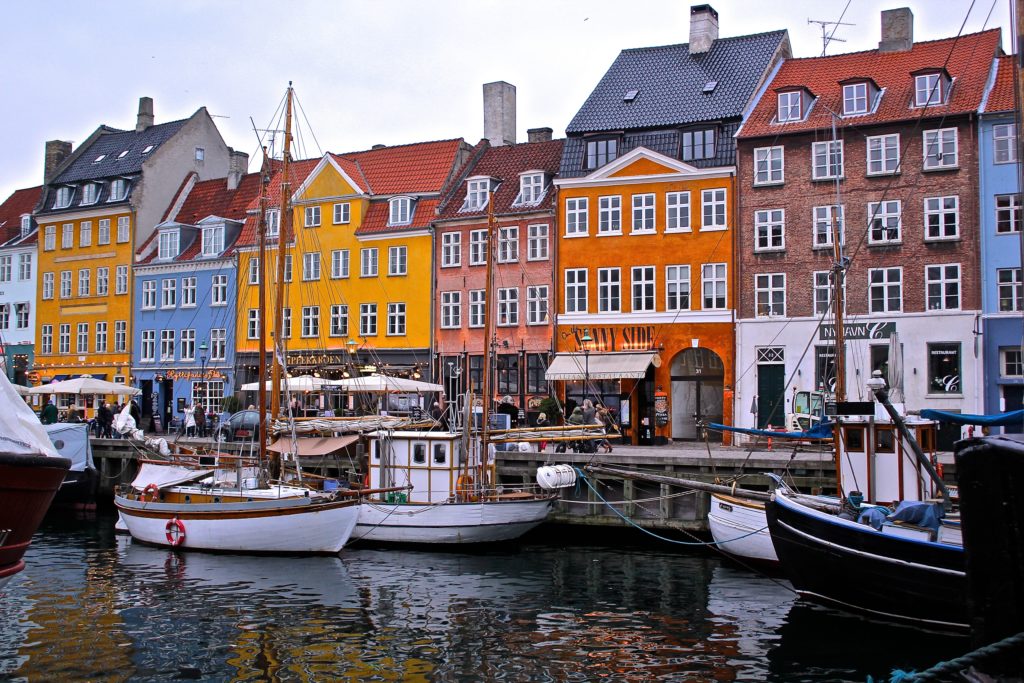
Daily cost: €161.46
I visited Denmark in my early twenties and it was so expensive I gave up converting prices and just decided I couldn’t afford anything. If I remember correctly, I ate supermarket sandwiches for dinner and washed them down with a coke zero. Très chic!
Stay outside of Copenhagen. This is notoriously one of the most expensive cities in Europe. I can personally vouch for that!

Daily cost: €133.63
I knew before I visited Iceland that it was going to be an expensive trip. The flight itself was a steal (Barcelona to New York via Reykjavik), offering a cheap stopover en route to NYC.
Iceland is expensive in terms of hotels, food, petrol and entrance fees. Even to visit the waterfalls you need to pay an entrance fee!
Road trip between destinations and travel with a friend to split the costs. Affordable hotels are available throughout the country, especially where there is more demand in Reykjavik.
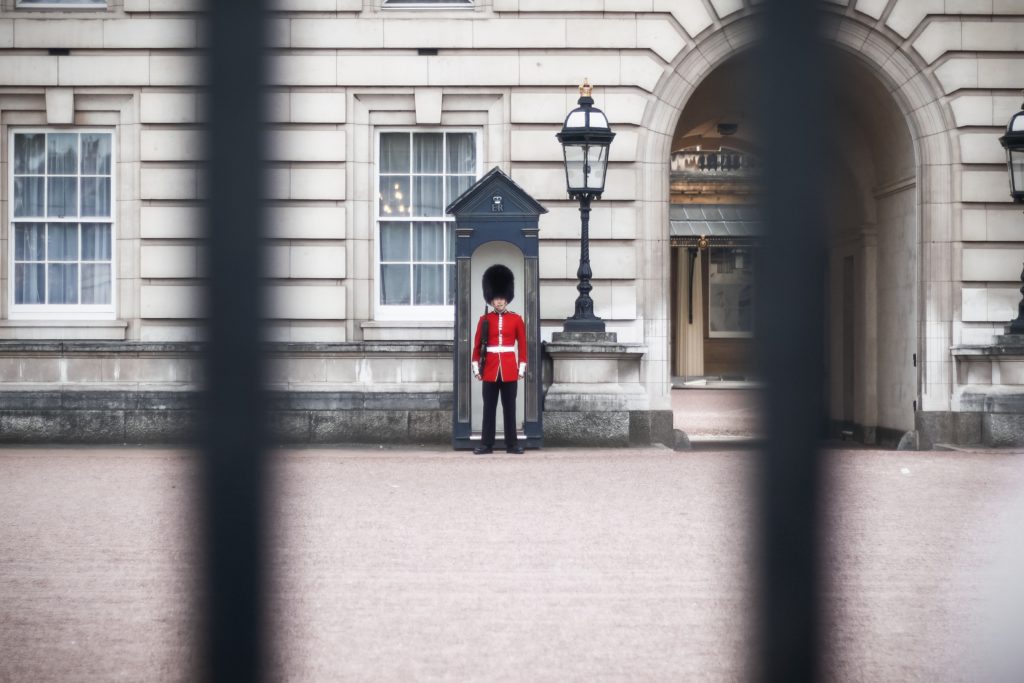
United Kingdom
Daily cost: €127.40
When you visit Europe for the first time it is highly likely London will be on your agenda. And for good reason! This iconic city is year after year the most visited city in the world. The main expense when visiting the United Kingdom is accommodation. It doesn’t help that the pound always performs favourably to most other world currencies.
Waitrose and Sainsbury’s are your friend. You can grab a quick sandwich snack to eat on the go and skip the expensive restaurants. Many if London’s museums are free, as are the parks and just walking around Soho will fill an entire day of entertainment. Other cities outside of London are much more affordable to visit.

Daily cost: €124.14
This one may come as a bit of a surprise to you, because with cheap pizza and house wines, how could it be expensive!? While the food is affordable, the price to travel through Italy quickly adds up. Cities like Rome, Venice and Florence are the most expensive.
Get outside of the touristic cities and stay in small towns. Instead of staying in Florence, try Lucca. Instead of staying in Venice, stay in Verona. You can always take a train and make day trips!

Netherlands
Daily cost: €122.66
When you think of the Netherlands , you think of Amsterdam. That’s normal! But I promise you there is so much more to the Netherlands beyond the city of Amsterdam. Besides, other cities are much cheaper to visit! The average price per day spent in the Netherlands is €122.66 . But you can easily save money with these few tips.
Check in to an Airbnb in Amsterdam or a local hostel if that’s your style. You can also save money by splitting the cost with a friend. Street food is readily available in major cities and is not only cheap but tasty!

Daily cost: €120.73
Finland is an expensive country to visit whether you’re in the capital, Helsinki , or further afield in small towns.
Try staying with a local family for a local experience. I stayed with a family in the lakes district and not only was it affordable but also gave me an insight into the local culture.

Daily cost: €112.67
The most expensive city to visit in Sweden is Stockholm. But don’t let that stop you! There are some great free attractions plus the public transport is easy to use.
Use the public transport and swap restaurants for cheap eats and supermarket lunches. If your accommodation offers breakfast, make this your biggest meal of the day.

Somewhere in the Middle
Daily cost: €111.96
Spain is reasonably expensive to visit but as soon as you exit the big cities (like Barcelona and Madrid) it becomes a lot more affordable.
Swap big cities for small towns. Indulge in tapas and kick back with a jug of sangria!

Daily cost: €110.33
Greece can be expensive but it doesn’t have to be. There are some great ways to save money, especially if you aren’t short on time. Local ferries are a great option for island hopping and they’re much more affordable than flying between the islands.
Use local transport to save on travel costs between the islands. It will take a little longer but it is the journey, not the destination that matters! If you are carefully considering travel costs in Europe, sometimes you have to sacrifice time to save money.

Daily cost: €109.47
Ireland is one of my favourite countries to explore in Europe. It is so naturally beautiful and sets the scene for a perfect road trip! As soon as you leave Dublin, the country becomes much more affordable to enjoy.
Road trips are a great way to see this country but public transport is much more affordable if you’re on a budget.

Daily cost: €106.78
Germany is in the heart of Europe, meaning it is really well connected with trains. This makes for a great adventure by land and will also save you money. The large cities like Berlin, Cologne and Munich are much more expensive than the countryside.
Swap the major cities for countryside escapes.

The Cheapest Countries in Europe
Daily cost: €18.75
Serbia is the most affordable country on a day-to-day cost analysis. If you are carefully considering travel costs in Europe, Serbia is a great option for budget travellers. Belgrade is a surprising city with so much to offer visitors and I can highly recommend it!

Daily cost: €23.00
Ukraine is another great choice for travellers considering travel costs in Europe. The local transport might seem daunting at first (as no signs are in English). However, you would be surprised how much you can converse with hand gestures and broken English!
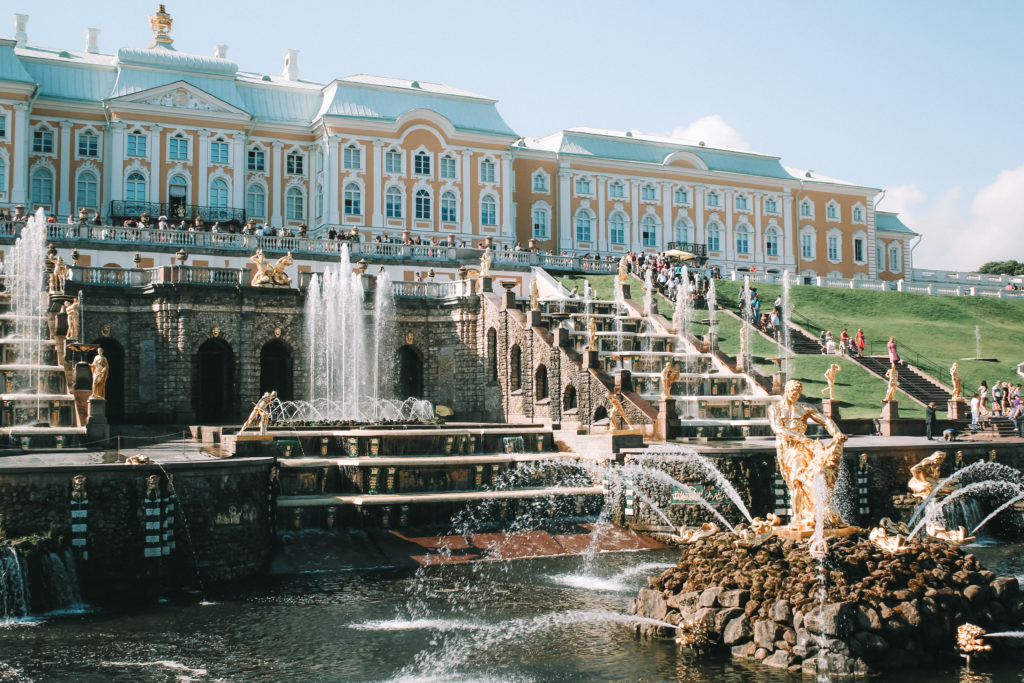
Daily cost: €38.92
Russia is one of the more affordable countries in Europe to explore, however Moscow and St Petersburg are still quite expensive. If you’re up for a real adventure, head out into the small towns and spend more time off the beaten path.

Daily cost: €41.31
One of my friends recently went on her honeymoon to Albania. It isn’t the ordinary first choice for a honeymoon but she said it was a great adventure! Albania is still one of the least visited countries in Europe. This makes it very affordable and quite underrated.

Daily cost: €51.04
Still in Eastern Europe, Bulgaria is a great choice for budget travellers. As you might have already noticed the more you venture East, the more affordable it becomes.

Bosnia & Herzegovina
Daily cost: €54.85
Bosnia and Herzegovina is one of my fondest travel memories. This country is so underrated and the locals are so welcoming to foreigners. To save money on my trip, I stayed with a local Bosnian family in Blaggaj. They were kind enough to cook me breakfast every day and even drive me to Mostar each day!
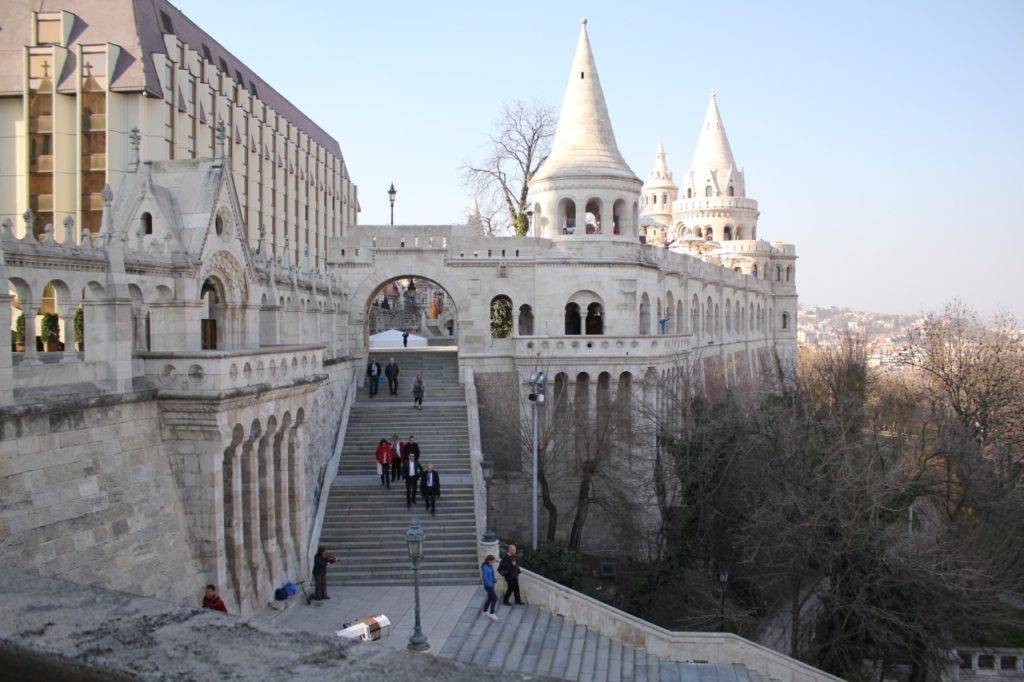
Daily cost: €57.68
Budapest has become one of the most sought after cities to explore in Europe. The capital city of Hungary has a high supply of accommodation, making it affordable to stay for a while.
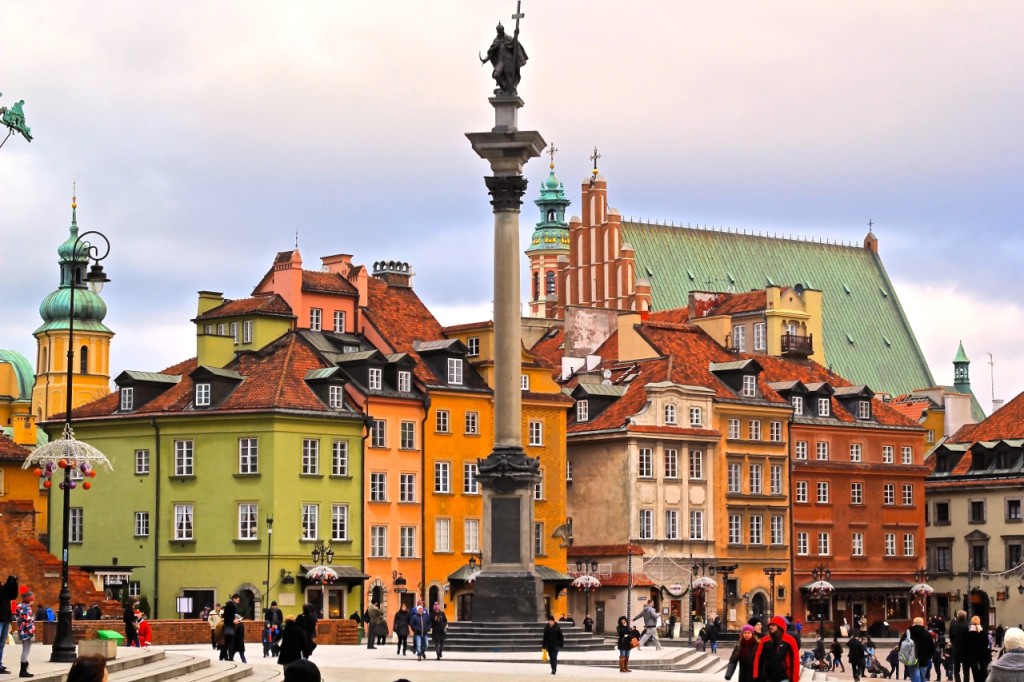
Daily cost: €58.58
Finally we round out our list with Poland. This country is often overlooked by visitors, although many travellers make their way to Krakow in the South. However if you make it all this way, I would strongly encourage you to spend more time in Poland! The capital city of Warsaw has been one of my favourite capital cities in Eastern Europe.
For more of my adventures, follow along on Instagram .
Brooke Saward founded World of Wanderlust as a place to share inspiration from her travels and to inspire others to see our world. She now divides her time between adventures abroad and adventures in the kitchen, with a particular weakness for French pastries.
Find me on: Twitter | Instagram | Facebook

Los Angeles
Plan a trip
First trip solo
Packing guide
20 Best Places for Solo Female Travel
Travel after a break up
20 Places in your 20’s
WAYS TO TRAVEL
Solo travel
Adventure travel
Luxury travel
Learn a language
Become a blogger
You are here
How much money do i need to travel europe.
For some people, setting a budget is just one more exciting thing to do when planning their European holiday. Mainly because it gives them an opportunity to dream about the castles and banquets they’ll be spending their euros on.
Then there are others who dread the whole ordeal – probably the same people who haven’t visited the dentist in a year.
Knowing things is hard. And who’s got time for calculations?*
Allow me to introduce you to the amazing Holiday Budget robot planner 3000! (Well, it’s not really called that). Planning a budget is hard, it’s not like you just know the cost of a bratwurst and a 1L jug of beer in Munich off the top of your head is it? That’s impressive if you do, but our Holiday Budget Planner actually does know that kind of stuff. Try it out below!
*Ain’t nobody got time for that.
Try our fancy new budget calculator (above) now!
How to plan a trip to Europe with a budget
First up, you need to figure out what you need to budget for.
To work out your rough costs, you’ll need to know:
- Where you’re going – for flight costs.
- How long you’ll be away – for nightly accommodation costs.
- How you want to get around – for transport costs.
It also helps to budget with those you’ll be travelling with, so you can work out what costs are solely yours and what you can share. It’s also a good way to set out what type of holiday you want to have. If you’re a budget traveller who wants to hostel-hop your way through Europe, your budget will be very different to the traveller that wants 5-star, all-inclusive, buffet breakfast, city-view, luxury hotels.
I_DemiQuinn_Mykonos-770x578_90kb.jpg
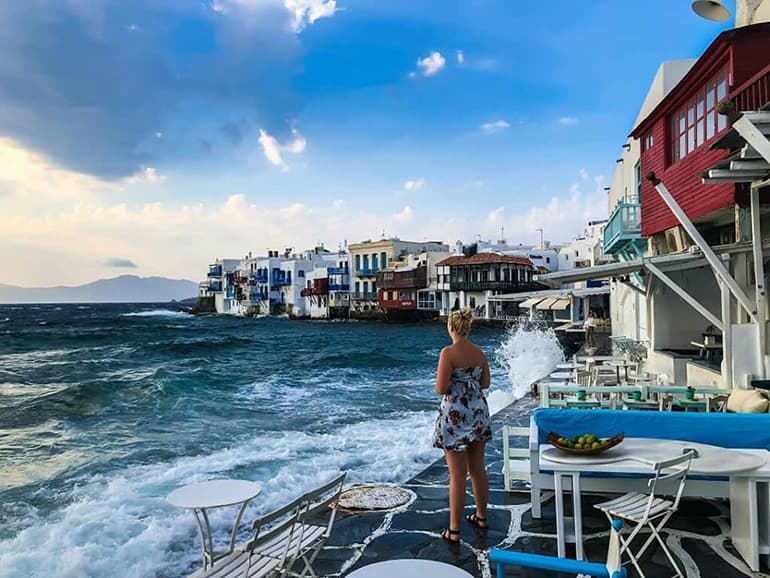
How much does a Europe trip cost?
Let’s take a look at a few examples of different kinds of holidays you could have in Europe, and address some of those big-ticket costs that need to be budgeted for.
The lovey-dovey couple
This romantic pair is travelling through London for 2 weeks during its beautiful, warm summer. Between them, they’ll need just under $10,000 AUD for flights, accommodation and daily transport.
The solo backpacker
This lucky vagabond is travelling Solo (not even Chewbacca is invited). They’re hitting up France , Spain , Italy and Greece for a whole month of adventure. Depending on how frugal they decide to be, they’ll need about $4,000AUD for flights, accommodation and public transport. Don’t forget to budget your meals and adventures though!
The fun family
This wonderful family of 2 adults and 2 kids (under age 11) is going on a cruise to visit Barcelona during the school holidays – lucky kids… The parents will need to save around $13,000AUD worth of pennies to afford the flights, cruise and accommodation for this trip.
Note that these are your core expenses. Other costs from travel insurance, daily expenses like food and drinks, sightseeing, activities and all those shopping trips aren’t taken into account.
Costs of travelling Europe per day
We’ve looked at the big stuff, now let’s get into the intricate expenses.
First of all, a good holiday budget will keep in mind where you can tighten up on expenses – and where you can splurge! Having this type of flexible holiday budget is essential because you never know when an opportunity might come up that you don’t want to miss out on.
For a middle-of-the-road holiday (neither budget nor luxury living) we recommend from:
AU$100 to AU$150 per person, per day.
This will cover sightseeing, food and drinks, shopping and other nitty-gritties. But of course, there are heaps of ways to cut down on this cost – or add to it – to create your preferred budget.
Travel Money Oz Infographics_14_Blog.jpg
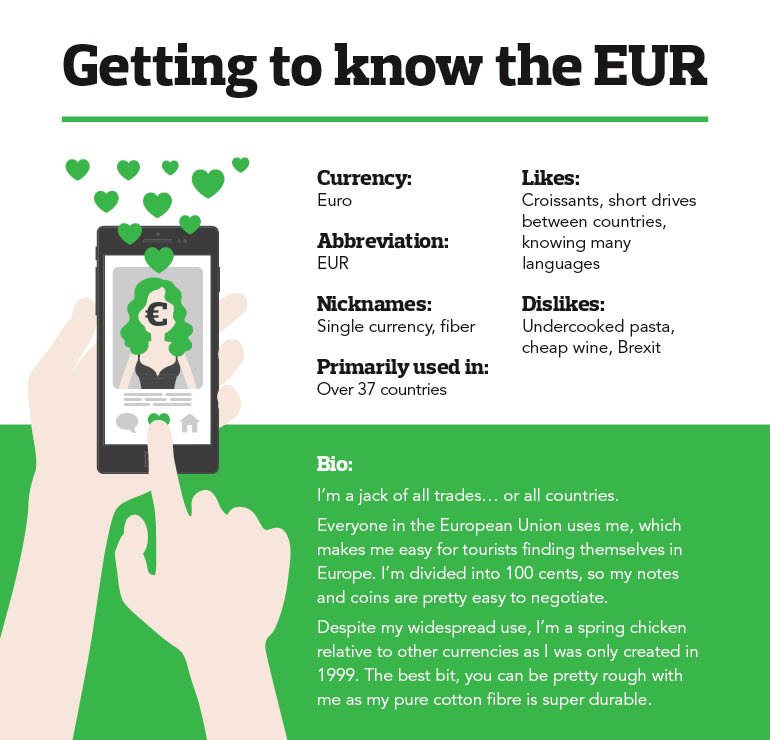
Consider your bookings
It helps knowing exactly what’s included in what you’ve booked. Does your hotel include breakfast in the per night cost? If it does, then that’s one less thing you need to budget for. Or does your accommodation have kitchen facilities? That gives you a cheap’n’easy, DIY meal option.
You can also look for other ways to save. Can you purchase a public transport pass, rather than buying single tickets (as usually, this will offer some savings)? Or can you purchase a sightseeing pass that includes entry costs and public transport? If you can, why not go for it and save.
Final words on budgeting
Well, that was probably a lot to take in, so let’s finish up with some easy-peasy dot points.
- It can help to have a pre-agreed cost for things (pre-agreed with yourself, or your travel companions if you’re splitting costs). This avoids arguments, stress and overspending.
- Put time and research into your ‘per day’ budget and include the things you really want to do. Once you know the costs, you have a goal to save for.
- It pays to book things in advance, but sometimes you might be able to find a cheaper price when you are in the country
- Don’t forget to factor in your pre-travel costs (e.g. travel insurance, immunisations and visas).
- Budget for cheap eats some days so you can gorge other days. From enjoying a glass of champagne at the top of the Eiffel Tower to devouring food at Germany’s food stalls.
- Don’t forget those sneaky costs (e.g. transfers, tours and tipping).
If you still need help with setting a holiday budget, our travel money experts have a handy budgeting tool available in any of our 165 stores across Australia and New Zealand.
*Flight costs based on search from www.flightcentre.com.au and are indicative costs only, based on prices available on 10 August 2018. ^Accommodation costs are based on an average per night price for budget , moderate or luxury hotels, as indicated in the table. ~Cruise cost is based on search from www.ncl.com for a 7 night Western Mediterranean cruise onboard Norwegian Epic, departing Barcelona in May 2019, and is an indicative cost only, based on prices available on 10 August 2018. **Rail Pass cost is based on search from http://www.eurail.com and is an indicative cost only. COST COMPARISON TABLE: All costs are based on estimated approximate costs from major metropolitan cities in each country. “From” costs indicate costs that start from the indicated price and may be higher than shown. Average prices indicate a typical estimated cost you would pay for the indicated item. Prices may vary from time to time, and in different cities and towns within each country. Cities included are: London, United Kingdom; Rome, Italy; Paris, France; Berlin, Germany; Barcelona, Spain; Athens, Greece; Budapest, Hungary; Prague, Czech Republic; Amsterdam, The Netherlands. This blog is provided for information only and does not take into consideration your objectives, financial situation or needs. You should consider whether the information and suggestions contained in any blog entry are appropriate for you, having regard to your own objectives, financial situation and needs. While we take reasonable care in providing the blog, we give no warranties or representations that it is complete or accurate, or is appropriate for you. We are not liable for any loss caused, whether due to negligence or otherwise, arising from use of, or reliance on, the information and/or suggestions contained in this blog.
AUD News: Global growth concerns continue to put a cap on Aussie dollars performance
Travel hacks: halloween hotspots around the world, more like this.


The Cheapest Ways to Travel Europe, According to a Cheapo Who Loves Traveling Europe
Last Updated: October 27, 2023
*FYI - this post may contain affiliate links, which means we earn a commission at no extra cost to you if you purchase from them. Also, as an Amazon Associate I earn from qualifying purchases. Check out our Privacy Policy and Disclosure. for more info.

What’s the cheapest way to travel Europe?
After 7 years of bouncing around Europe as a) a backpacker, b) a broke student and now c) a restless expat, this is a question I’ve relentlessly sought the answer to.
My first taste of European budget travel was during my first ever backpacking trip around Western Europe. I had travelled from Paris to London, two major bucket list cities of mine, for less than the price of 6 Chicken Nuggets.
It was exhilarating. My mind was blown… and I suppose you could say, that’s when a monster was born.

Save these cheap ways to travel Europe for later!
You’ll be very, very glad you did. (Your wallet will be too!)
When I returned a year later as an exchange student, I took advantage of budget travel options to go absolutely insane and indulge in weekend trips anytime I could.
Along the way I discovered wild deals like 5 euro bus tickets to Paris, 20 euro roundtrip tickets to London, 40 euro roundtrip tickets to MOROCCO.
Not to be dramatic: but a whole new world – nay, a whole new ME – emerged. Since moving back to Europe, I’ve continued to take advantage of the countless cheap options out there – after all, why spend extra when you don’t need to?
That’s why I want to share with you my top tips today, lifting the veil on the cheapest way(s) to travel Europe.
You can also click here to download a free checklist that breaks down my process for finding the cheapest ways to travel from Point A to Point B every time. Enjoy!
PRO TIP: I always use Omio to quickly compare the prices of flights, trains and buses. It sorts everything by cheapest, recommended, shortest, etc. and is totally free!
My Cheapest Ways to Travel Europe Video
One of the most important things to do before travelling internationally is figuring out how you’ll get around. Want a video version of all the info below? Here you go:
1. Taking Buses to Travel Europe Cheaply
If affordability is what you’re after, I highly recommend traveling around Europe by bus.
While it’s not as comfortable, convenient or scenic as train travel, it comes at a fraction of the cost (which means more euros in your pocket for croissant hoarding and wine guzzling).
These days, the main contender in European bus travel is FlixBus .

For me, Flixbus wins in terms of price, flexibility and convenience. With fares as cheap as 5 euros one way, the price simply can’t be beat.
Plus, you can easily download an app where you can check different bus times/purchase tickets up to the day of.
They even have the most chilled out cancellation policy ever – you can cancel/change your ticket up to 15 minutes before departure for only a euro (note: in the good old days, this was even free!)
That’s why I think Flixbus is the perfect choice for a spontaneous budget traveler.
They even have an awesome pass called Interflix that allows you to book 5 journeys for only 99 euros. That means you can ride from one European hotspot to another for only 20 euros… an absolute steal.
Click here to scope out the best Flixbus deals

NOTE: As with all things in life, you get what you pay for. Flixbus isn’t world-renowned for amazing service or punctuality, but they do get you from Point A to Point B eventually. I’d recommend them if budget is your #1 priority.
Other bus options to check out in Europe:
Eurolines: I’ve only used Eurolines a handful of times because Flixbus is so convenient to book, but they offer a lot of routes around Europe and in my experience, tend to be more punctual than Flixbus.
However, they’re a lot less flexible when it comes to modifications/cancellations, with a zero refund policy within 48 hours of the trip date, and a 25-50% deduction of the total fare if you cancel earlier. In other words, if you want to be flexible, Flixbus is a better choice!
RegioJet, AKA Student Agency Bus: I took this one from Prague to Budapest 2 years ago and it’s still (to date) the most luxurious bus trip I’ve ever had!
It was super affordable, there were movies available on board and even a “bus attendant” who gave us free hot chocolate and tea. Most of their routes seem to be in/out of the Czech Republic, but they’re an amazing deal if you’re travelling in that area.

Megabus: Megabus used to be my go-to bus company (they’re how I got from Paris to London for two pounds in 2014 – like I said, for less than the price of 6 nuggets!) but their European routes have since been acquired by Flixbus.
That said, they’re still active in the UK, and have some crazy deals if you book early enough (the first to buy tickets on certain routes can score them for only 1 pound)
Another cost-effective option in the UK is National Express. I’ve used them many times and they’re always very professional and punctual. The key with them is to book as early as possible to score the best deals!
Local bus lines: While travelling around the Balkans, I relied on a number of local coach companies to get around. If you happen to be travelling around the Balkans, your best bet is to inquiry at the local bus station for tickets – they’re usually very affordable even the day-of.
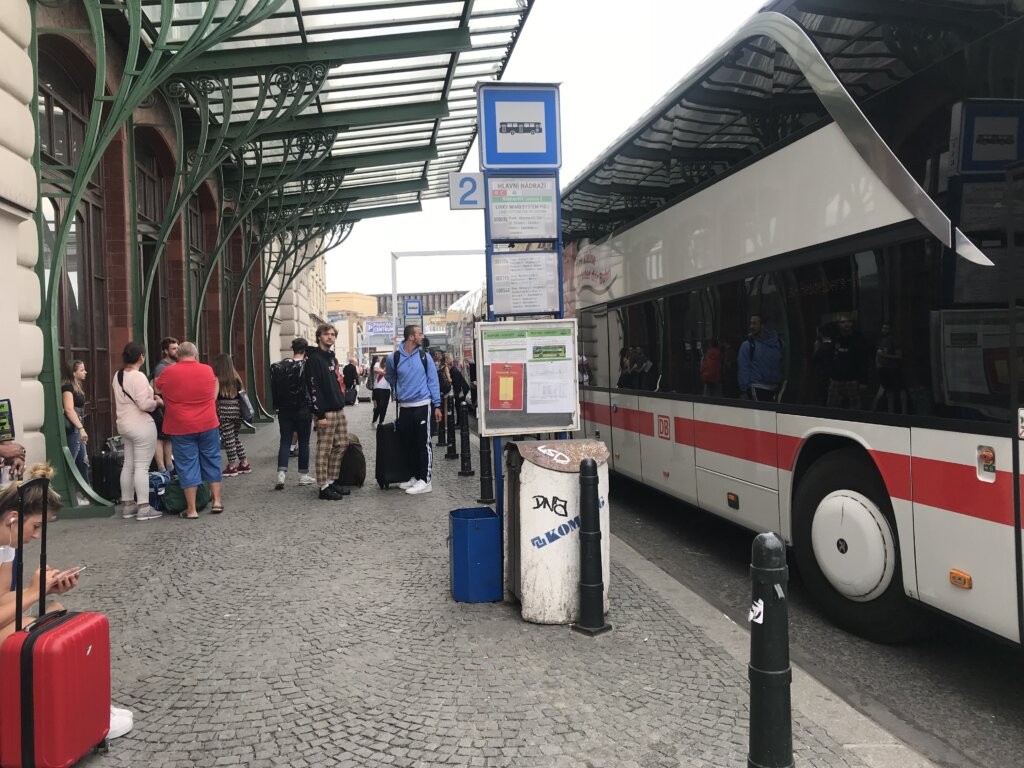
2. Hopping around Europe Cheaply with budget airlines
One of the most popular (and cheapest) ways to travel Europe is through budget airlines.
Unlike North America, Europe is crawling with budget airlines that can take you from Point A to Point B at ludicrously low costs.
… Sometimes even cheaper than the bus!
With Ryanair for example, I can get from Munich to London for only 10 euros if I book early enough. That’s cheaper than the cost of actually getting to the airport!
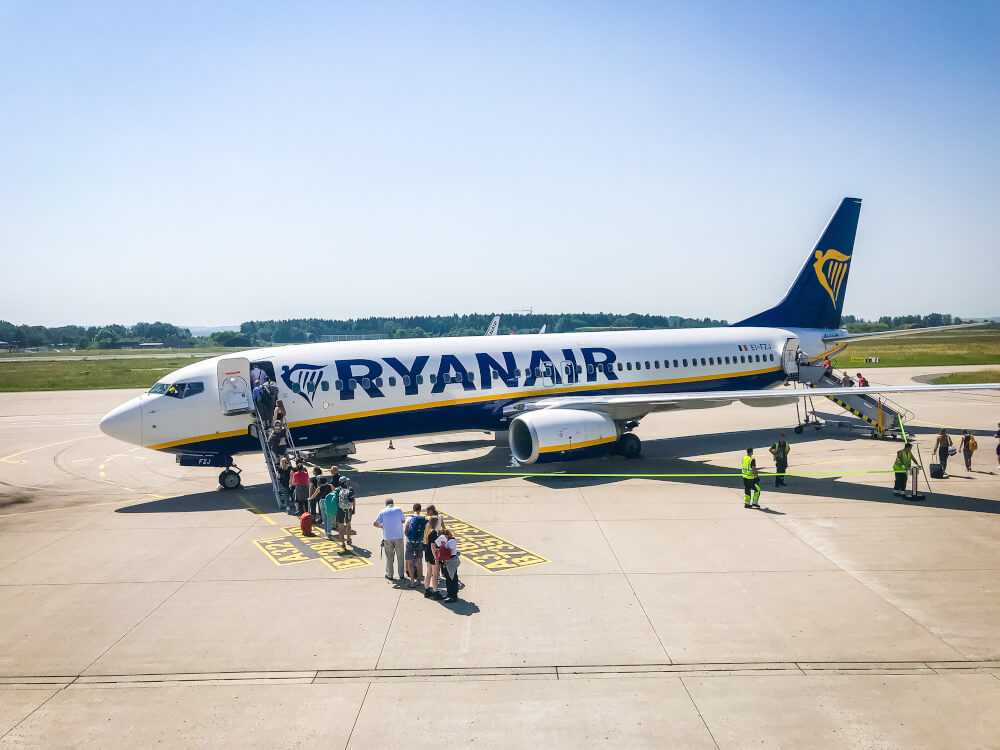
How to find them: I always use Skyscanner to check out the best flight deals. A few big names to look out for include RyanAir , EasyJet, WizzAir , Volotea, EuroWings, and Vueling.
You can also use Omio (for free!) to search up flights, buses and trains at the same time so you can see which out of all these options is cheapest.
Lastly, you can double check deals from various locations using a VPN like Private Internet Access to see if you can find better deals.
Download my free checklist: I actually wrote an entire post on how to find the cheapest flights TO Europe, and the tips/systems I introduce definitely work for flights within Europe as well. Click here to read it, and click here to download the free checklists I made that will help you find the cheapest flight every time.
One note with budget airlines: you absolutely, 1000% get what you pay for.
This means limited legroom, ‘meh’ service and additional costs for everything (including extra bags, in-flight meals and even printing your ticket at the airport).

But hey, for the price, you really can’t beat it. So long as you familiarize yourself with each airline’s rules and hidden costs, you’ll be fine.
If you want a preview of what the experience is like, click here to read my honest RyanAir review, and click here to read my honest Wizz Air review.
I wouldn’t stress too much about having the most luxurious and wonderful experience though… instead, it’s much easier to accept a mildly uncomfortable 1-3 hours.
After all guys, you are paying 10 euros to fly in a hover-box through the sky. Chill out, and enjoy the (dis)comfort of your legroom-less seat.
Click here to scope out the best flight deals on Skyscanner
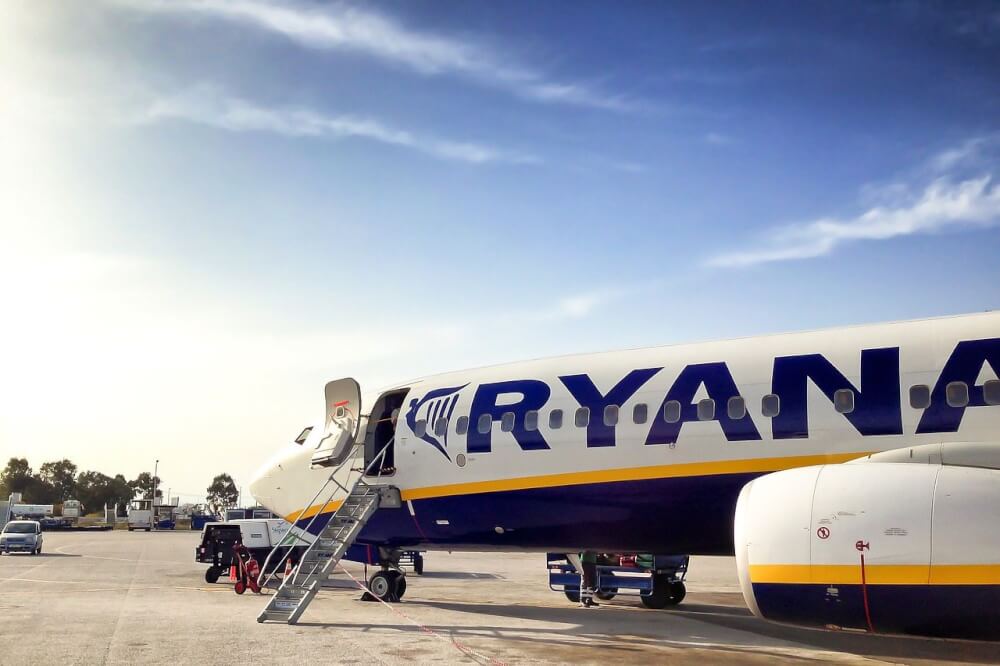
3. Cruise around Europe on a budget with BlaBaCar
Those in search of the cheapest way to travel Europe should definitely look into BlaBlaCar.
BlaBlaCar is a carpool service that matches up drivers/passengers who are going to the same places. You’re essentially pitching in for gas/other expenses in exchange for a seat in someone’s car.
I know it sounds slightly sketch, but it operates on a good review system much like Couchsurfing and AirBNB . Many of my friends use it regularly with great results.
HELPFUL HINT: In some areas, Google Maps has even begun syncing up with BlaBlaCar , so when you search up how to get from Point A to Point B, BlaBlaCar rides will show up as an additional option below driving, public transport, etc.
Click here to check out BlaBlaCar

4. Save Money on Your Europe Trip by Hitchhiking
If you’re looking for (truly) the cheapest way to travel Europe, hitchhiking would be it. Is it glamorous? No. But it’s like, 50 shades of free, soooo…
Now here’s the thing: hitchhiking is better suited for some areas than others.
For example, while in the Balkans, I hitchhiked once in Bosnia and the guy turned out to be a lovely lavender farmer who (seemed to) own a monopoly over lavender fields in the area.
He barely spoke English and could only keep pointing at his fields like a boss while hollering “LAVANDA LAVANDA”.
That was a fun experience.
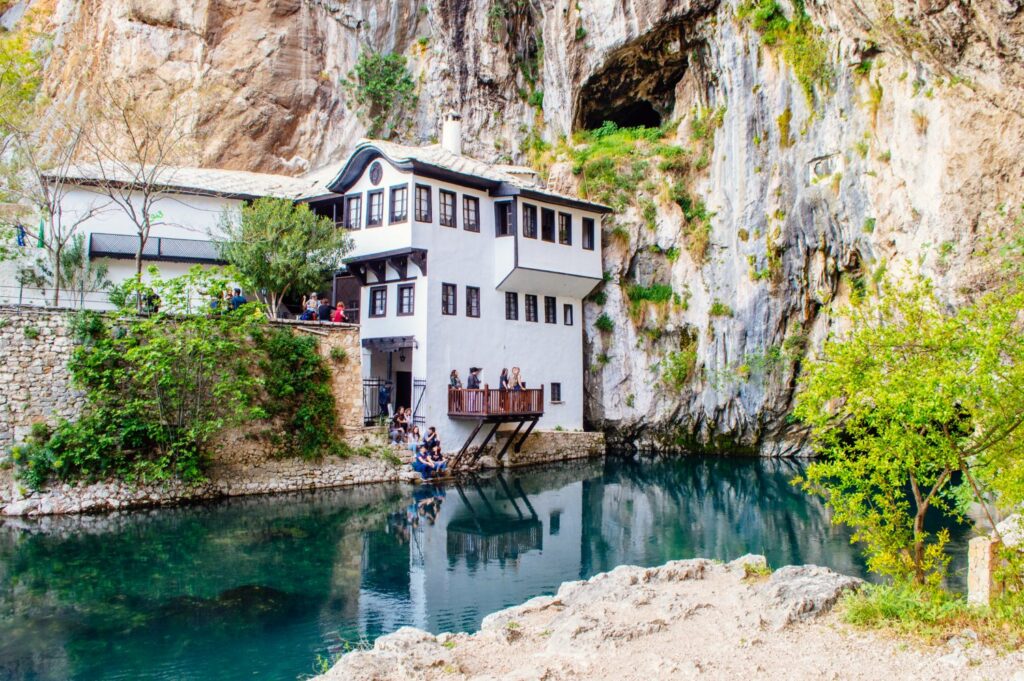
On the other hand, it might not be as easy to do in Western Europe… I’ve never tried it myself in this area, but I do have friends who once hitchhiked from Amsterdam to Munich to visit me for Oktoberfest.
It took 16 hours. SO, know that this is the ultimate cheap way to travel Europe, but it can be very unpredictable, tough and kill a lot of your exploration time.
It’s also true that hitchhiking isn’t for everyone. While it’s not as dangerous or uncommon as many people think, it still carries some risk and disadvantages.

You should probably NOT hitchhike if:
- You are paranoid about safety (and travelling alone)
- You are limited in time
- You have strict plans on where you need to be and when
5. See Europe in Style (and on a budget) with train deals
There are few travel experiences as epic as taking the train across Europe… that said, while train travel is incredible , it can wreak some serious havoc on your budget.
Cheap train travel in Europe can be possible though. Here are some tips!
How to travel Europe by train (on a budget):
Book as early as you possibly can:
European train tickets are usually sold in batches, with a select number of really cheap (inflexible booking) tickets available first, then moving into higher price ranges as they sell out.
If you know where you’re going and are okay with a lack of flexibility, then buying as early as possible is probably your best bet.

Look into group/regional tickets:
Many areas in Europe will have special deals for those travelling in groups or in particular areas. In Bavaria for example (where I currently live), there’s a group deal called a Bayern Ticket that gives you unlimited travel for the day for 5 people on the same ticket .
It costs 26 euros for the first person, then 5 additional for each extra person you add on, which is an insanely good deal if you get several people together.
Often, these deals will be cheaper than buying regular tickets, so do some research to see if these specials exist where you’re headed 🙂 For more info, you can click here for my full Bayern ticket guide.
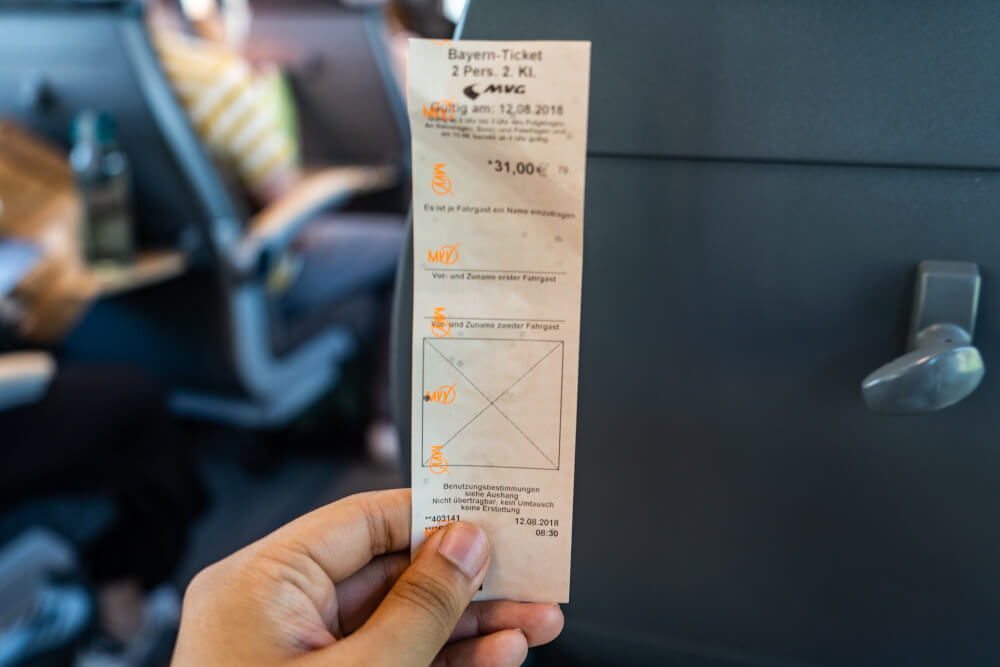
Check if you’re eligible for discounts:
European train companies love rewarding people for being young, so often if you’re under the age of 26, you’re eligible for additional discounts, especially if you’re a student.
In Belgium for example, those 26 and under can buy a GoPass 1, which allows you to travel one-way anywhere in the country for only €6.60.
Get a train pass:
For my fellow North Americans, Eurail offers a lot of different passes for different countries, time periods, etc. These can be much cheaper than buying tickets individually, and they also offer a lot more flexibility.
It’s good value for money, despite not being the cheapest option out there. I would recommend doing a lot of research prior to buying a pass to see how much tickets cost for your intended travel routes because you might be able to plan a cheaper trip if you buy non-flex tickets far in advance.
Click here to browse the best deals on Eurail Passes

6. Travel Europe Cheaply by Renting a Car
Travelling through Europe by car might sound like a wonderful bucket list dream, but it’s a lot more complicated than just getting an old Volkswagen and decking it out in fairy lights.
The issue with renting a car in Europe is that it’s riddled with hidden costs, including extra fees for crossing multiple countries, dropping off at different points, highway vignettes (required for many countries in Central Europe, etc. etc.)
The truth is, it is highly unlikely that renting a car will be the cheapest way to travel Europe for you.
Is it worth it though? Well, the freedom to pull over whenever, go wherever and take off at a moment’s notice is pretty sweet.

If you choose to go this route, here are some tips to help you get the best deal on travelling through Europe by car:
Use a comparison website:
A good start is using a comparison website to find the most competitive prices for a car rental. Expedia is my go-to.
That said, looking at these listed prices is simply not enough. It’s also important to…
Consider the hidden costs:
The prices you see on these comparison sites will most likely not be what you end up paying. There are MANY extras to consider, like insurance, GPS, multiple country fees, one-way drop off fees, tolls, vignettes, etc.
Sadly, the companies are not consistent in what they include in their listed price, so be sure to do your research and read the fine print so you can fully understand which is the best deal.
Click here to read my post full of hidden costs you should be mindful of!
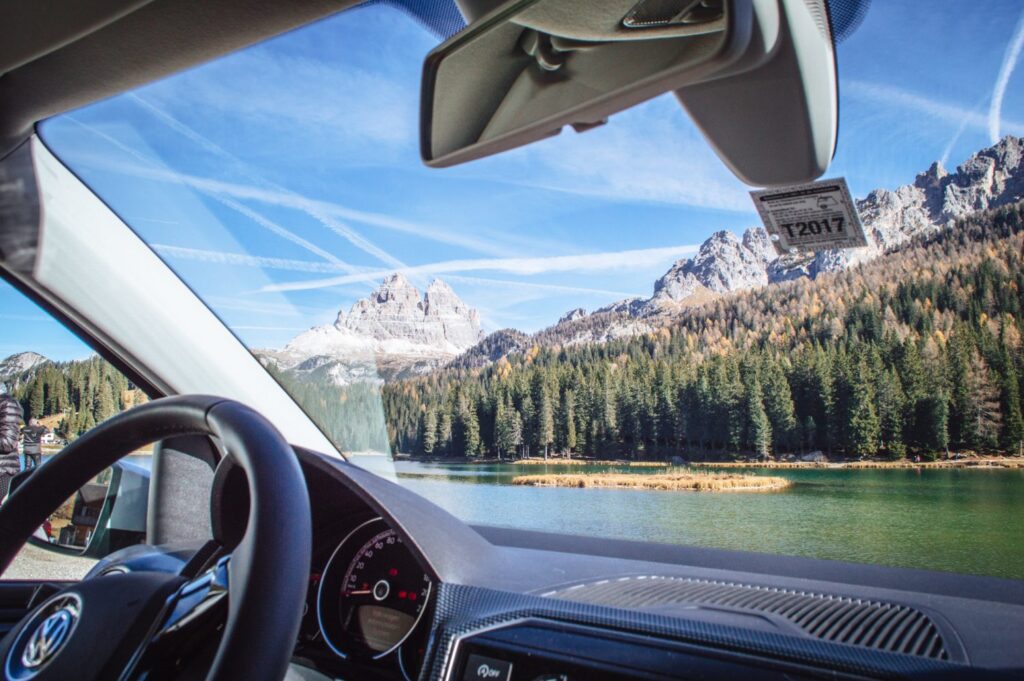
Find coupon codes automatically :
I highly recommend the free Google Chrome extension, Honey , which looks up free coupon codes for you automatically. It takes a click to install and is awesome for saving a little extra on all travel bookings and any other online purchases.

Any more questions about the cheapest ways to travel around Europe?
I hope you enjoyed that guide on the cheapest way to travel Europe and that it gave you some good insight into the different options for cheap transportation in Europe.
If you have any questions though, feel free to ask below!
My Go-To Travel Favourites:
🧳 Eagle Creek: My favourite packing cubes
💳 Wise: For FREE travel friendly credit cards
🍯 Airalo: My go-to eSIM
🏨 Booking.com: For searching hotels
📷 Sony A7IV: My (amazing) camera
✈️ Google Flights : For finding flight deals
🌎 WorldNomads: For travel insurance
🎉 GetYourGuide: For booking activities
75 thoughts on “The Cheapest Ways to Travel Europe, According to a Cheapo Who Loves Traveling Europe”
BlaBlaCar sounds interesting, I’ll definitely take note of it. Hitchhiking is just for me though. I’m too scared, haha! – Charmaine Ng | Architecture & Lifestyle Blog https://charmainenyw.com
haha BlaBaCar is almost like a more regulated version of hitchhiking. Definitely a good middle ground or starting point if hitchhiking scares you 😉
Great tips! I took Flixbus and it was perfectly fine and actually on time, which was a pleasant surprise! Also, I think the best website for looking up quite a bit of European train travel is bahn.de. It’s the German train website but it has train times and routes for many more countries. And it’s really easy to use. Always search the number of people you’re looking to book for. Sometimes we forget and just keep the number at 1, but I travel with my husband and we’re always 2 and 2 is always cheaper than 1 + 1! There are great deals in Germany for a group of people traveling together too. Found this on Easy Jet as well – prices are better for 2 people.
Awesome info – thank you! I use bahn.de all the time since I live in Germany but I never realized it had such helpful info for other countries too. And I had no clue that booking for 2 is cheaper. SO good to know – thanks! <3
Great tips! I currently live in Europe and have the flexibility of owning a car, but I might use one of these cheap buses one day. Another thing about those cheap airlines…if you’re flying in Europe the flight time is usually no more than 2 hours, so it’s really not a big deal to not be able to recline your seat for 2 hours. As soon as you’re up, you’re already back down! Worth the cheap price in my opinion. And I think the hitchhiking is totally dependent on where you are. I went to the Isle of Skye in Scotland earlier this year and it’s extremely common for backpackers to hitchhike around the isle to get to the different sites. We gave a ride to some people and didn’t feel unsafe at all. Go with your gut!
Awesome – thanks so much for this thoughtful comment, Kristin! Always good to get some input from others and their experiences <3 Scotland does seem like an amazing place to hitchhike. The people there are so lovely! Thanks for chiming in 🙂
Love your tips, I think I tried most of them. No bad experience so far. 🙂
haha good to hear I’m not steering anybody wrong 😉 thanks for reading!
It is really not easy to keep it cheap in Europe, but you have some great suggestions. In Denmark, they use GoMore, a great carpooling service. I used it a lot because train tickets are ridiculously expensive! Else, the trick is to book in advance, then you can get them almost cheaper than doing the carpooling.
Ooh good to know about GoMore! I love that there’s so many new services popping up these days for budget travellers. Makes lives so much easier!
A very handy piece, if only travel in Canada was that easy…lol…I will be keeping this for future reference as I had never heard of Flix Bus they sound great and if you can get used to flying Ryanair you can get used to anything…
Hope this comes in handy for your future travels, Faith! Flixbus is definitely a great budget option. They’re by no means mega-comfortable and there’s often delays, but it does get you to where you need to go eventually haha. Can’t really argue with prices like theirs!
I love this one! 🙂 I live in Europe so I have used almost all from the list but I really like it how you combined them. P. S. Your pins has amaaazing design, love it so much. <3
aw thank you so much for the kind words!!! <3
I was just in the Balkans and had to hitchhike out of desperation in Albania . Lol. Love that you met a lavender farmer!
haha I hope your experience was as fun as mine! Hitch hiking in the Balkans is a lot easier (I’ve heard) than in other parts of Europe 🙂 definitely a neat way to meet locals!
This is really useful for me! I am currently an exchange student in Italy untile Feb 2018 so I’ve been wanting to go out the country and roam around Europe. I most definitely am shocked with RyanAir prices! Thanks for this post!
What an exciting time for you! I travelled so much during my exchange in Munich and decided to move here 😉 You never know what a crazy impact this experience will have on your life. Hope you have an amazing time in Italy!
Love this post! Good timing too, I was just trying to decide about taking a FlixBus for an upcoming trip. Sounds like it is the way to go!
We are also all about the budget airlines (Volotea is my current fav) but I swear my biggest annoyance isn’t the baggage fees or incessant selling, it is the lack of seat back pockets. Sounds ridiculous but for some reason that annoys me ENDLESSLY. #highmaintenance
omg so true – no seat pockets kills me every time because then I’m left scrambling, with my passport, phone, boarding pass, etc. scattered all across my lap hahah. Flixbus is fine if you don’t mind meh service/delays. They’re definitely super budget friendly!
This post is so timely ! Planning a trip to Europe next summer . Thx for sharing ! Fab as always Christina ! Xo Valerie
Yay! Hope you picked up loads of great tips from this post. Safe travels 🙂
Great post with really good advice. Busses are a great way to go and often overlooked by North Americans. But I find them to be really useful in certain areas. I’m still a fan of trains though!
I think buses are tougher in North America since major cities are so much further apart! In Europe though they are amazing since everything is so close 🙂 I’m a big fan of trains now too. They’re just so comfortable and convenient. Thanks for reading, Lynne!
This is all seriously so helpful! Thank you for taking the time to put it together. I’m definitely saving for my upcoming trip, since I’ll be an extra tight budget!
so so happy you found it helpful!! Safe travels, girl <3
I don’t live in Europe but every time I go to The Netherlands I take adventage of those cheap trips in Europe itswlf. I’ve tried bus travels and by plain. Next I want to try train traveling. All in all Europe living is in a travelers best interest.
Absolutely – living in Europe makes us travellers so spoiled 🙂 I can’t recommend train travel enough. It’s so relaxing and beautiful. Hope you get to see for yourself sometime soon!
Cheap travel is one of the things I love most about living in Europe! If I ever stopped travelling around Europe, Ryanair might go bust ;-). This was a great and really informative post!
hahaha yes – I feel so spoiled living here. Thanks for reading, and keep travelling please because I rely on RyanAir way too much for them to go bust 😉 lol
Another cheap way to travel Europe to grab one of the multi festival/trip passes that Stoke Travel have. I picked up one of their Passports and it got me a free festival, and I got to visit Oktoberfest, surf in Spain, La tomatina and Ibiza with all my accommodation, meals and ridiculous parties sorted. They even have unlimited beer and sangria haha.
Hey Christiana, Awesome post loved it. Never know it was possible to travel Europe so cheaply. I will definitely make a point following these tips while a trip to europe this summer.
Awesome! I hope you have an amazing (budget-friendly) trip!
Transportation is one of the things that contribute to a major portion of your entire travel budget. That’s why people search for some cheapest travel option around Europe and your blog presents a very good information about that. It was certainly a good read. Thanks for posting.
Loved your tips. Its great to find such informative article. Will try some of your tips on my next visit for sure.
The tutorial is very detailed, thank you for sharing, wish you always good health to go more places. I’m planning to go to Europe and it’s great to read your post
Hi Chris! Thanks for sharing your experience with us!!
Budget airlines were my best friend when I lived in London! It felt like such an accomplishment to grab an awesome deal and be able to go away for the weekend wherever I wanted in Europe!
Absolutely love this, I have lived in Europe most my life but even I learned something from these amazing tips. Will definitely pin this for later. Thanks for sharing!
I think there’s a lot to be said for different transport being good for different places! There are so many European trips I want to do and all in different ways (road trip through northern Italy? Train through Switzerland?) – there’s so much to consider! This post is really helpful in laying it all out though. 🙂
What a great and helpful post! I’m going to be traveling around Europe for a few months later this year so I’m saving it for later. I’ve heard of a few of these companies, but since I haven’t used them before, I tend to forget about them. So thanks for jogging the memory, too.
Great tips, shame Europes not on the cards for me in the near future. Love the lavanda story!
Great post! I for one wouldn’t really like to spend most of my budget just to get to the place I really want to go to. Sometimes the cheapest mode of travel makes you experience the best story to tell if time isn’t much of a factor 🙂
Oh I love Megabus. I use it all the time to travel from Toronto to Montreal. I didn’t know it exists in Europe too. These are some great info Christina! One day, when I’m less of a chicken, I would like to try hitchhiking in Europe 😛
Thanks for the tips, Christina! I love FlixBus and hitchhiking hehehe. When my mom backpacked Europe in the ’80s she just got a train pass but that seemed so spendy the last time I was there, and ended up going with FlixBus practically everywhere. I do love trains, though.
FlixBus and trains were my favorite ways to get around Europe. I wanted to try BlaBla car, but the timing didn’t work out.
Thanks for the tips.
Personally, I always prefer to use cheap airlines in Europe over buses or trains. They cost almost identical, but you get to your destination much faster and without back pain.
If you book two or three months in advance, you can usually fly between most European Capitals for 30-60 USD. Some good choices are Rynair, Wizz Air, and Norwegian airlines.
hahaha yes – I feel so spoiled living here. Thanks for reading, and keep travelling please because I rely on RyanAir way too much for them to go bust lol
While travelling around the Balkans, I relied on a number of local coach companies to get around. If you happen to be travelling around the Balkans, your best bet is to inquiry at the local bus station for tickets – they’re usually very affordable even the day-of
I don’t live in Europe but every time I go to The Netherlands I take adventage of those cheap trips in Europe itswlf. I’ve tried bus travels and by plain. Next I want to try train traveling. All in all Europe living is in a travelers best interest.
Transportation is one of the things that contribute to a major portion of your entire travel budget. That’s why people search for some cheapest travel option around Europe and your blog presents a very good information about that. It was certainly a good read. Thanks for posting.
Amazing post, so detailed! Very useful as a quick go-to guide, definitely fueled our wanderlust!
Thanks for all the info! I live in Europe, but I want to do more spontaneous weekend trips for cheap more often (I’m writing that as if I’ve ever done it before…) Grew up with travelling through Europe by car, and I dream of doing it again. To visit smaller villages overlooked by tourists, either by free will or because the car breaks down, makes great memories (it is handy being a member of one of these road help companies, especially when travelling with a 15-20 year old car). Oops, mind flew off there… but yeah, recommend people to go by car if they can afford it and don’t want to stay at the big cities most of the time
Awesome post! Thanks for sharing the knowledge and keep up the good work.
thanks for reading!
This is very really unique helpful information. keep it up. Thank you so much!
When you visit to another country, one of the important things that you must concern is budget. You need to prepare carefully everything for your trip. Especially, you should find out the cheapest way, it will help you save money better.
Do you love traveling? Do you want to discover Europe? It’s a wonderful place for people, you can visit many beautiful countries and enjoy some delicious food.
Interesting writing! Europe is very beautiful, I think that most people will choose this place to relax and enjoy.
Useful article for visitors! If you have a decision to travel to Europe, let’s read this writing and discover it.
Very good info. I needed this, Thank you very much for your advice
Exciting article!
Europe is very famous for its architecture and beverage. Let’s discover this country when you have a chance!
Hello Christina!! Wow it is an interesting and amazing article and it is very beneficial for all readers especially for all those who travel through it first time. I really like this article and I hope all the readers will be very thankful for it. It is very beneficial for me as I am going through my first flight and this flight will be very useful for me. Thanks for sharing this article with all of us
Thank you for providing such a useful and attractive blog, with very useful details and stuff I never expected, and I would suggest that you write more blogs and blog posts like that for us. Once again, thank you.
Europe is very famous for its architecture and beverage. Let’s discover this country when you have a chance!
Thank you for sharing this truly awesome intel! I’ve already bookmarked this page for my upcoming European travels, and that pretzel looks too good to be true 🙂
Wonderful post about travel to Europe! Keep up the wonderful work and thanks for providing the information.
Fantastic post! Please keep up the fantastic work and thanks for sharing your information.
This blog gives tips and application references that could be useful to save money while traveling in Europe on a tight budget.
i like your videos a lot 🙂 thanks for all the infos, i am also on low budget and need every tip on saving money haha. i start using this app called ” ATM Fee saver” it shows me atm around me with the lowest fees for withdrawing money. its super useful i can recommend to you using it 🙂
great Post.. really helpful
Leave a Comment Cancel reply
By using this form you agree with the storage and handling of your data by this website. *
- Search Please fill out this field.
- Manage Your Subscription
- Give a Gift Subscription
- Newsletters
- Sweepstakes
- Budget Travel
13 Affordable Places to Visit in Europe — From Country Escapes to Stunning Cities
You can visit Europe on a budget — here's how.
Elizabeth Rhodes is a special projects editor at Travel + Leisure , covering everything from luxury hotels to theme parks to must-pack travel products. Originally from South Carolina, Elizabeth moved to New York City from London, where she started her career as a travel blogger and writer.
:max_bytes(150000):strip_icc():format(webp)/elizabeth-rhodes-25083778bc654f69b30ce8417affc82c.jpg)
If you have big dreams of jetting off to Europe, but worry that your bank account isn't quite ready, don't worry. For every expensive city, there are dozens of charming — and surprisingly affordable — places that offer all the European charm for a fraction of the price. Ljubljana, Porto, Budapest, even Berlin — these cities have all the rich culture, stunning architecture, and delicious food that you'd find in pricey European capitals, but they're perfect for budget travelers.
You can even travel to some of Europe's best (and famously expensive) destinations without breaking the bank — you just have to know how to save money without sacrificing on experiences. Travelers can often score deals on flights from the United States to major cities like Paris or London, and upon arriving, transportation within Europe can be much more affordable (hello, budget airlines). Those large cities also offer a wide range of accommodations, so you can certainly find something in your budget. You can even save money on food by hitting the local markets. After all, a bottle of wine, fresh bread, and cheese from a Parisian market make for an unforgettable meal when picnicking under the Eiffel Tower.
And you might be surprised by how many museums, churches, and other attractions are free or inexpensive to visit, too. Be sure to keep an eye out for free entry days (often one day a month) or tourist cards that offer entry to multiple attractions for one flat fee. (Do the math ahead of time by calculating the cost of every included attraction that you want to visit to make sure it's really worth the money.)
Trimming your budget doesn't mean sacrificing the quality of your trip. Sometimes, the less you spend, the more you can immerse yourself in the local culture. Staying in a thatched Irish farmhouse, perusing old masters in Rome, or snacking your way through Spanish specialties aren't just tricks of the frugal traveler — they're the stuff dream vacations are made of.
Here are some of the top destinations for an affordable European vacation (and tips for saving money once you arrive).
Bavaria, Germany
For a storybook-worthy vacation in Europe, head straight to Bavaria. Book a room at Burg Colmberg , a 14th-century castle rising from a rocky crag above a tiny village. It offers an eclectic collection of rooms tucked throughout a warren of crooked hallways, hidden staircases, and cozy sitting nooks. Be sure to visit the postcard-perfect Neuschwanstein Castle , resplendently perched atop a mountain, and take the time to tour Hohenschwangau, the castle in which "Mad King" Ludwig II actually lived. The latter is a more modest pile of battlements on a smaller nub of a hill in the valley below. What it lacks in the carefully crafted pomp and circumstance of Neuschwanstein — which Ludwig II never lived to see completed — it more than makes up for in homeyness and history.
Puglia, Italy
Michela Sieman/Travel + Leisure
The iconic architecture of Puglia — the "heel" of Italy's boot — is the prehistoric trullo, a cylindrical whitewashed house with a cone-shaped roof of stacked gray stones. There's no greater concentration of trulli than in the UNESCO-protected town of Alberobello, where whole neighborhoods are made of the structures, and the local entrepreneur behind Trullidea has fixed up dozens of the abandoned ones and rents them to visitors. Cool in the baking summers and with cozy indoor heating for wintertime, a rental trullo lets you live like a local for less than the cost of a tourist-class hotel in town. Want to sample what the Amalfi Coast was like before the hotshots and high prices moved in? Puglia's forested Gargano Peninsula is popular with sun-loving Italians, but is otherwise refreshingly off the tourist map.
Budapest, Hungary
Alisha McDarris/Travel + Leisure
The capital of Hungary, Budapest offers all the charm of more popular European destinations for a fraction of the price. The Hungarian Parliament Building and Fisherman's Bastion are just a couple of the picture-perfect attractions you'll spot in the city, and you'll find lots of affordable accommodations, meals, and nightlife, too. Even the city's famous thermal baths — some of which are over a century old and feature beautiful architecture — can be affordable to visit.
Andalusia, Spain
Rory Fuller/Travel + Leisure
Take a break from sizzling on the crowded Costa del Sol beaches for a self-guided driving tour along the route of the Pueblos Blancos. This string of clifftop, whitewashed villages stretches from the Moorish town of Arcos de la Frontera through the Sierra de Grazalema to Ronda, a maze of medieval streets perched above a 500-foot gorge. Opt for a stay in nearby Seville — the capital of Andalusia — to take in the beautiful architecture, watch some flamenco dancing, and indulge in classic tapas.
Berlin, Germany
Berlin has Cold War mystique, contemporary architecture, and booming gallery and restaurant scenes. With its cosmopolitan, East-meets-West edginess, it's no wonder the city has become a cultural capital of central Europe. It's a destination that continues to attract creative types and in-the-know travelers. Begin your trip to Berlin in the fashionable Mitte (or "middle") district, as it's convenient to major sites such as the Reichstag and Potsdamer Platz.
Bath and the Cotswolds, England
The charming villages of the Cotswolds look like they're straight out of a fairy tale — Chipping Campden, Stow-on-the-Wold, and Bourton-on-the-Water are among the prettiest. There are inns and pubs sprinkled throughout the little towns, but we'd suggest staying in Bath, a quaint city dating back to the Roman era, for its variety of accommodations. While there, check out the Royal Crescent, Pulteney Bridge, Bath Abbey, and of course, the historic Roman baths. Best of all, Bath is under two hours from London by train, making it an easy weekend trip from the city.
Istanbul, Turkey
Istanbul's major state-run museums may charge hefty admissions, but the Great Palace Mosaic Museum, just behind the Blue Mosque adjacent to the Arasta Bazaar, costs only 60 Turkish lira (that's about $4). These delightful mosaic scenes of hunts, myths, animal battles, and everyday life in antiquity — boys riding a camel, a man milking his goat — once covered the floor of a large courtyard of the Palatium Magnum, the Great Palace built between the time of Constantine the Great himself and Justinian I (fourth to early sixth centuries). You can even cruise between the continents for an affordable price when taking the ferry.
Ljubljana, Slovenia
Take a tour of the architectural masterworks of prodigious local talent Jože Plecnik, who took the Secessionist Art Nouveau style he learned in Vienna back home (via Prague) to remake his native city along his own, idiosyncratic lines. Like Gaudí in Barcelona, Plecnik designed his buildings right down to the smallest fittings, like the Pegasus door handles on the entrance to the National and University Library. Plecnik designed a bit of everything around town, from the central market to the two flanking spans of Ljubljana's iconic Triple Bridge to the café-lined embankments of the Ljubljanica River. The city also has a number of incredible, affordable restaurants, and you can take a public bus (for a small fee) to nearby Lake Bled for a day trip.
The Dalmatian Coast, Croatia
Skip the overexposed island of Hvar for the walled medieval village on the Adriatic island of Korcula, purported home to Marco Polo. Korcula is more of a day-trip destination, and that means the tourist crowds thin considerably by sundown, leaving those who remain to relax in the cafés and stroll the narrow alleys. While every old city in Europe has an Old City historic district, Split has the only downtown actually carved from the carcass of an ancient Roman palace. When the emperor Diocletian left his throne in A.D. 305, he built a lavish palace on the Croatian coast to live out his days as head of the empire's eastern half. In the 1,700 years since, the ruins of his enormous structure have been colonized by the locals, the buildings turned into medieval town houses, and the emperor's tomb transformed into the cathedral.
Paris, France
Want to experience fabulous French cuisine on a budget? Opt for a midday splurge — many cafés and restaurants offer less expensive menus at lunch. And a picnic is always a good idea in Paris. Stop by a market to peruse the (typically) extensive options for cheese and wine, or pick up a simple yet delicious crepe from a stand. If you plan to visit the City of Light's top museums and attractions, you might want to invest in a Paris Museum Pass . For one fee (priced depending on the number of days you purchase), you can gain admission to top tourist spots like the Arc de Triomphe, Sainte-Chapelle, Panthéon, Louvre, Musée Rodin, and more, and you get to skip the ticket line. Talk about a win-win.
County Clare, Ireland
Irjaliina Paavonpera/Travel + Leisure
Avoid the tour bus-clogged Ring of Kerry for its neighbor to the north, County Clare, home to the dramatic Cliffs of Moher rising more than 700 feet from the crashing Atlantic waves; the weirdly eroded limestone landscape of the Burren, where prehistoric slab tombs perch on the rocky flatlands like miniature houses of cards; and Doolin, a blink-and-you'll-miss-it village that has become a popular destination for traditional Celtic music. Local pubs are the perfect evening stop for hearty (and usually affordable) Irish fare and — if you're lucky — live music.
Rome, Italy
Daniel Gorostieta/Travel + Leisure
Rome has more than 900 churches, all of them free, displaying great works of art and architecture by the likes of Raphael, Bernini, Caravaggio, Bramante, and Pinturicchio. And that's just the short list of artists contained in one church — the little-visited Santa Maria del Popolo. Other iconic landmarks, like the Trevi Fountain, Spanish Steps, and Rome's famous piazzas are all free to visit, too, and some museums offer free entry days, so check their websites for details.
Porto, Portugal
Paula Galindo Valle/Travel + Leisure
Portugal's northern city of Porto is among Travel + Leisure readers' favorite European cities, and once you visit, you'll see why. In Porto, visitors can admire the Art Deco architecture, sip port wine, and explore the walkable city on foot without going over budget. Plus, a day trip to the Douro Valley, a picturesque vineyard region along the Douro River, is worth the trek.
Related Articles

Find cheap flights to Europe from $132
This is the cheapest one-way flight price found by a kayak user in the last 72 hours by searching for a flight from the united states to europe departing on 10/22. fares are subject to change and may not be available on all flights or dates of travel. click the price to replicate the search for this deal., search hundreds of travel sites at once for deals on flights to europe.
Save 21% or more Compare multiple travel sites with one search.
Track prices Not ready to book? Create a price alert for when prices drop.
Free to use There are no hidden charges or fees.
Filter your deals Choose cabin class, free Wi-Fi and more.
Best Europe Flight Deals
Cheapest round-trip prices found by our users on KAYAK in the last 72 hours
Good to know
Faqs - booking europe flights, what are some of the passport and visa requirements for united states citizens traveling to france.
Citizens of the United States need to have a valid passport and make sure that the passport remains valid for at least 90 days beyond their date of departure from France. When traveling on vacation, there is no need to get a visa so long as you plan on staying for less than 90 days in France.
If I plan on vacationing in Greece, what are some all the quickest ways I can get there from the United States?
Most Travelers in the United States flying to Greece will go to the Athens International Airport Eleftherios Venizelos (ATH). When you are departing from the west coast of the United States and an airport like the San Francisco International Airport (SFO), your quickest option will be a board one-stop flights offered by Lufthansa they have layovers at Munich Franz Josef Strauss Airport (MUC).
If I plan on traveling to Germany for Oktoberfest, what are the best airport choices?
By far, the best airport choice is to travel to Munich Airport (MUC), which is the city where this event is held. When traveling from the United States, you can find nonstop flights aboard Lufthansa from both Los Angeles International Airport and John F. Kennedy International Airport, and there are one-stop flights on the same airline from Dallas Fort Worth International Airport (DFW).
If I am traveling to the International Music Summit in Ibiza, what are some of the best ways to get there from the United States?
One of the most convenient airport choices to get to this event is to travel to the Ibiza Airport (IBZ). When traveling from John F. Kennedy International Airport, you will find one-stop flights aboard Air Europa and Iberia to this airport. If you are traveling from the West Coast of the United States from an airport such as Los Angeles International Airport, you can travel on one-stop flights aboard British Airways and Vueling.
If I would like to make my way to an eastern European country such as Poland, what are some good flight options from the United States?
Most Travelers in the United States making their way to this country will fly to the Warsaw Chopin Airport (WAW). If you’re departing from a large city on the East Coast United States such as the Boston Logan International Airport (BOS), the quickest trips occur on one-stop flights aboard Scandinavian Airlines that have layovers at Kastrup Copenhagen Airport (CPH).
Which airline is the best choice for nonstop flights to Sweden from the United States?
By far, your best choice is going to be SAS Airlines since they are based in Stockholm and have a reputation for offering great flight options to Sweden from the United States. One example of this would be the nonstop flights they offer between Chicago O' Hare International Airport (ORD) and Stockholm Arlanda Airport (ARN).
How long is the flight to Europe?
An average nonstop flight from the United States to Europe takes 8h 18m, covering a distance of 4017 miles. The most popular route is Newark - London with an average flight time of 6h 40m.
What is the cheapest flight to Europe?
The cheapest ticket to Europe from the United States found in the last 72 hours was $94 one-way, and $311 round-trip. The most popular route is Newark to London Heathrow and the cheapest round-trip airline ticket found on this route in the last 72 hours was $481.
Which airlines fly to Europe?
British Airways, American Airlines & Finnair fly the most frequently from the United States to Europe. The most popular route is from New York to London, and United Airlines, Air Canada and Lufthansa fly this route the most.
What are the most popular destinations in Europe?
Based on KAYAK flight searches, the most popular destination is London (44% of total searches to Europe). The next most popular destinations are Paris (19%) and Rome (12%). Searches for flights to Athens (9%), to Madrid (4%) and to Lisbon (4%) are also popular.
How does KAYAK’s flight Price Forecast tool help me choose the right time to buy?
KAYAK’s flight Price Forecast tool uses historical data to determine whether the price for a given destination and date is likely to change within 7 days, so travelers know whether to wait or book now.
Top tips for finding cheap flights to Europe
- Enter your preferred departure airport and travel dates into the search form above to unlock the latest Europe flight deals.
- A popular city in Europe that people from Los Angeles often travel to is Paris. Most travelers will utilize Los Angeles International Airport (LAX) as their departure airport, and to Paris Orly Airport there are non-stop flights aboard French Bee and Air Caraibes, and to Charles de Gaulle International Airport (CDG) there are direct flights aboard Air France and Delta Airlines.
- A city that is quite popular with travelers departing from John F. Kennedy International Airport (JFK) is London. Some of the non-stop flight options available from the airport to London include flights aboard Finnair, Iberia, Virgin Atlantic, and American Airlines to Heathrow Airport (LHR), as well as non-stop flights aboard Norse Atlantic Airways, British Airways, and JetBlue to Gatwick Airport (LGW).
- Passengers in the United States traveling to any city in England and planning on renting a car should know that children must use a car seat until they are at least 12 years old. Parents can utilize the most appropriate type of child restraint based on the age and size of their child.
- When travelers in the center of the United States want to travel to the popular city of Berlin, they most often will depart on international flights from Chicago O' Hare International Airport (ORD). From this airport, passengers can find one-stop flights to Berlin Brandenburg Airport Willy Brandt (BER) aboard LOT Airlines, Icelandair, and Lufthansa.
- When parents plan on taking their children to France and will be driving a rental car, it is important to know that children up to 15 months of age must travel in a rear-facing car seat, and then up to four years old must travel in a forward-facing car seat. After that, any child up to 12 years of age needs to travel in either a booster seat or on a booster cushion.
- One of the most popular destinations in Europe for travelers from the United States is Madrid. When traveling from the large city of Boston and the Boston Logan International Airport (BOS), travelers can find nonstop flight options aboard Iberia, Finnair, and American Airlines to Adolfo Suárez Madrid–Barajas Airport (MAD).
- Another destination that is quite popular for visitors traveling to Europe is Vienna. When flying from Atlanta Hartsfield-Jackson International Airport (ATL), passengers can find a number of one-stop flights aboard both United Airlines and Lufthansa that travel to Vienna International Airport (VIE).
Top 5 airlines flying to Europe
Everything went smoothly. I didn’t like that when I booked in the main cabin my wife and I weren’t seated together. One would think when booking on an option that allows picking your seat. They would put you and your travel partner together. Had to call to get it sorted. They did fix.
The gate area was incredibly short staffed, with one representative manning 4-5 flights, which caused a 3 hr delay in boarding even though the plane was all ready to leave. Other flights also were delayed because of this. The flight crew was awesome and I feel bad for the only gate worker on call, but Delta needs to hire more employees.
Very frustrated with boarding gate crew. She announced the plane was small and they would be limiting us to one item to carry on. Not a problem for me as I understand the tiny planes have limited space!! Not the case here! It was a rather large plane and had plenty of room for bags! So because I don’t want to be one of “those people” who ignores the request to check a carry on I did so asking if I would be able to pick it up at the bottom of the ramp on arrival in Knoxville to which she responded “yes”! Then I watched as every other passenger held onto their 2 items and boarded!! Then when we arrived in Knoxville our 2 carry ons had been put with all the other luggage and we had to go to baggage pick up and wait for all the big checked bags to come off the carousel! So she lied!! Frustrating. Next time I won’t be so nice!
It was a good experience except when boarding a female flight attendant did not go out of her way to assist my teenage daughters in finding space for their carry-ons after their compartments were full.
On time departure, smooth trip, flight attendant told through passengers the gate we would arrive at and the gate our outbound flight was departing from. Early arrival
Checking in at the airport the agent only booked the first keg of my trip and had my checked luggage going to the airport with a layover! Never was issued a boarding pass for the second leg or received sticker fir my checked bag. All was well in the end! Delta agents helped to resolve the situation!!!
Delayed due to an ill passenger after loading. Not preventable on Delta's part. Was in first class. The seats are becoming worn and detaching from their velcro attachments. Only got snacks on flight. The attendant was not the friendliest.
I would fly again the whole experience was great. The only feed back I can give that they don't do that American Airlines does is the crew there is more humorous with boarding and thank their passengers. It makes it more fun to fly with them. I would however fly Delta again.
Big plane, long flight, absolutely no leg room and basically non existent air! I am 5”4’ and always travel Main Cabin, I was miserable on this plane and could barely move when we arrived in Cabo due to the cramped leg area!
From Atlanta to Cabo I would have hoped on a plane that size I would have been able to breathe and wiggle my feet a little! The leg room in that plane is non existent and I am only 5”4’. And the air vent either wasn’t working very well or just could not blow air from the ceiling to the seat area as I was suffocating through the entire flight! And please don’t say I would have been more comfortable in first class because I cannot afford those rates and have always travelled Main Cabin without issues !
Flight was delayed 2.5 hours - a big deal on an overnight when you plan to sleep.
I feel like they have upgraded the app since I last flew United and I found it to be super helpful. I had stopped flying United unless absolutely necessary and my experience on this trip indicates they have been working hard to improve their services.
Surprisingly easy! I was hesitant to try this, but the cost swayed me. I actually felt like I had less stress than all the taxiing and possible delays that occur with short regional flights where you spend less time in the air than getting to and from the plane..
This flight was delayed multiple times and eventually canceled around 2-3ish. Original take off time was around 10:30am. By 3, there were no other options out of Houston, so stuck in Houston for from 3pm - 11am the next day.
Should have video screens Plane audio was poor and without wired connection hard to understand crew. Should serve more than just cups of water and pretzels on six hour flight. Did not see crew rest of flight. Fix charging sockets to retain charging blocks.
I paid $380 for my one-way ticket from California to Minnesota. The fair did not include online check-in. I received instructions from their app to check in at a kiosk. At the kiosk, the boarding pass would not print until an actual person came to verify that I had a personal item and not a carry-on item, On the plane, the person next to me was drunk and allowed to continue to order alcohol. United is garbage I’d rather fly spirit.
The plane was dirty and the in seat air wasn't blowing as planes usually do.
Generally good but there wasn’t any staff available when my luggage didn’t appear at baggage claim in Fresno. It took about half an hour to locate a staff member to open up the locked room where it was being kept.
Do not like the feeling of being in the basic economy. Everyone should feel good no matter what.
All flights were on time and boarding was issue free
Even though we left CMI late, we mostly made up the time.
Delayed almost 4 hours for a 45 minute flight with no explanation.
Again, multiple delays and I eventually just canceled and drove!
Great crew. Very comfortable business seats with nice bedding. Good food. We were delayed to let late passengers on the flight, but otherwise great experience.
Great crew. We were delayed so that late passengers could get on the flight. Love the bedding in business class. Good food. Great experience.
The CX617 from HK to BKK was delayed more than 1.5 hours.
Horrible - they lied to me about baggage & boarding, even though I specifically spoke to their agents the day before my flight about my issue. When I showed up they did not let me board and stranded me at my airport until I bought a new flight with money I did not have to spend.
I was in business class. There was an excellent headset. But half an hour before arrival they collected them! The rest of the trip I had to use a cheap earphone. There must be a better way to protect the headphones.
All four American Airlines flights I took in last seven days were delayed. Caused me loads of problems, missed meetings, loss of time and money.
American cancelled our flight home. Zero option for hotel, alternative transportation and took 3 hours to find our bags so we could take a 3 hour UBER ride home on our dime. Never flying AA again.
Bordón could be bettet if the company say before boarding the order of the different groups.
Checked in is easy and it was a smooth flight from LAX to Munich
There is no recline on flight from DFW to FRA. Middle eastern airways provide better recline option for the same class. FRA to Bangalore has better recline option. I bid 100$ for premium economy, my request was declined. But staff handled it without issues.
The Lufthansa part was wonderful. The short connection flight was not.
German crew were very kind. Food was okay but can be better, especially bread was not good, Garbage collection was very poor.
Awful Terrible staff poor communication Flight delayed for an hour with no apology or explanation and no help re missing connecting flight. Resulted in a 7 hour layover at Munich waiting for another connecting flight. Only 15 euros refreshment voucher given. Will not fly Lufthansa again
Both flights were late for what appeared to be the airline’s not having the planes ready. Arrived over 6 hours late.
It was a busy flight and all the crew were very helpful and gracious
Seats were not the most comfortable and food options weren’t great but overall but everything else was excellent
Check-in very easy and smooth. Plane and crew were nice. Seat open next to me created more space. Food was fair but plentiful. Lots of movies and I was able to sleep some on the way to Munich. Very tight connection, about an hour. Fast through passport control and a bit of a walk to last G terminal gate but I made my connection to Palma. Unfortunately, my luggage did not make it. It is now almost 24 hours since I anded and still NO luggage. I know it landed last night on another flight. Local delivery should be today to my hotel in Palma but nothing yet. I asked about the tight connection when I checked in and was assured they would get my luggage to the connecting flight. Very disappointing it missed my flight but more disappointing that it has taken so long to arrive. Failure on the airlines and service to get my luggage to date.
We missed the flight to Barcelona because the flight from Baltimore was delayed. We flew on Vueling VW6653. Our luggage didn’t arrive. Please help us get our luggage. We are staying at Hotel Gran Via in Barcelona
The seats were tiny, being of a fairly petite build, I don’t usually expect to feel crammed and cramped in a seat, but I definitely was on this flight. I couldn’t even bend over to get anything out from under the seat in front and getting up to go to the bathroom at night with the seat backs reclined was nearly impossible. I had to do gymnastics to get over and out. For an airline that does long flights overnight, it’s kind of ridiculous.
Not connecting flights. Missed my flight from Dublin to Liverpool because I arrived at Dublin one hour too late. For this mistake, they offered me a flight from Dublin to Manchester. Thats great and all, but I waste time and money to commute to Liverpool. Be sure to check the time of your connecting flights, because they sure don’t when they sell it to you
Excellent! Great flight attendants, good food (in business class, at least), very comfortable. Touchscreen and remote wasn’t great.
In economy and food was ok, but with limited leg space (and I was in a 2 seat configuration) it was difficult to eat with a tiny seat tray. I spilt wine on my trousers. First time on British Air (I usually fly Turkish Air) and in a 777. Heathrow was pleasant but changing terminals awkward.
Starting with the flight Cairo to London the plain was so poor no entertainment at all uncomfortable seats although it’s 5 hours long,then an American airline plain took me from London to Miami it was a bad experience the crew most of flight time not available and they asked us to help our selves for any snacks if we need. From Miami to London actually was perfect flight with a huge plain and perfect crew but from London to Cairo was horrible plain with stiff fixed seats not movable no entertainment or wi fi very poor Menu which is unacceptable for a business class
I've done hundreds of flights in my life, and this flight was one of the best I've ever taken, From beginning to end, everything went smoothly, professionally, and with a smile and friendly attitude from all employees I interacted with. The food was delicious (and free), as were the drinks. There was just a genial and effective way in the way that British Airways organized the flight -that reminded of days in the 70's, 80's, and 90's, when flying was a fun, and exciting adventure. I enjoyed and had confidence in the abilities of the flight crew, I'll be flying British Airways several more times this summer. Thank you so much for the great experience! Cheryl Olso
My baggage did not arrived with me. Took 3 days to get it after so may calls and follow up
Terrible! I missed my flight to my final destination and British airlines and American Airlines keep pointing fingers on each other’s. Nobody wants to take responsibility
Terrible. Flight was 3 hours delayed and I missed my other flight to my final destination
Book Cheap Europe Plane Tickets
Recent round-trip flight deals, search by stops, search by airline, search by price, recent one-way flight deals, last minute flights to europe, last minute flight, train and bus deals, flights to europe, return flight deals:.
Europe - United States
Cabin classes:
Browse origins:.
- Flights »
- United States
Browse destinations:
- Worldwide »

26 Feb How much does it cost to travel Europe? Our three-month costs revealed!
How much does it cost to travel Europe? It’s true that the continent definitely isn’t the cheapest in the world, but here’s the good news: it can be done on a modest budget. We spent three-months road tripping around Europe in late 2017, heading from Amsterdam to Portugal , through Slovenia and Germany to Prague. Here’s how much our Europe trip cost, including a breakdown of transport, food, activity and accommodation prices.
Looking for more travel cost posts? We have detailed spending breakdowns of all our travel adventures here , these are a few of our most-viewed posts, including more about the cost to travel Europe:
Our Eastern European travel costs Spain travel costs Croatia travel costs How much does it cost to travel America? New Zealand travel costs
Europe Accommodation Costs
If you’re looking for the cheapest way to travel Europe, we’d definitely recommend housesitting. We use Trusted Housesitters to find our placements and have had amazing sits in London , Spain and Portugal (you can find out more about how to find great house sits in this post ). For this trip, we found a nine-night housesit in the Algarve looking after dogs and pigs. We stayed in a beautiful converted barn house in the countryside and fell in love with the animals, the sit also saved us a couple of hundred pounds in accommodation.

Aside from housesitting, we found Europe accommodation was cheapest on Airbnb (if you haven’t yet signed up, here’s £25 off your first booking ). We used Airbnb throughout our trip, as cheap hotels in Europe are hard to find, although we did start to wonder about the ethics of using the website , especially when renting apartments. Mostly we rented spare rooms in people’s homes, but when we were staying in Porto and Prague , we rented whole apartments. We generally stayed a little out from the central areas since we had a car and could easily get around most of the time. Less-central rooms tend to cost less.

We had quite a mixed bag when it came to our Europe accommodation costs. We averaged out at £22 per night, with our cheapest stay in Coimbra, Portugal, which cost just £16.47. Our most expensive night was in Halblech, Germany, where we visited the fairytale-like Neuschwanstein Castle and paid £47.52 per night for a whole apartment.
Food Prices in Europe
Since we mostly stayed in apartments, we were able to keep our food costs pretty low by shopping at supermarkets and cooking our food at home. On travel days we didn’t eat all that healthily, we mostly ate snacks en route and then bread and hummus when we arrived somewhere for the night. Just before the trip, we transitioned to a vegan diet, which we feared might be a problem, but we actually managed to find plenty of options in the supermarkets (Prague was especially good). Here’s a typical grocery haul from Tesco in Prague, which cost £20.

We did eat out a few times on our Europe trip, especially when our families visited us in Prague or we hung out with friends in Porto, also in the few Airbnb stops where we didn’t have a kitchen. As always, we check Tripadvisor to find a decent vegan places to eat out. Here’s a vegan burger from one of our favourite discoveries, Vegan’s Prague, which cost £25 for two meals.

Here are some example meal prices: at Lehka Hlava , Prague, we had their daily menu (starter and main), the cold starter selection and two teas for £17.63. In Namaste Restaurant , Ljubljana, we had a selection of Indian dishes and drinks for £18.38 and in That’s Toast, Bruges, we spent £16.87 on a few slices of toast topped with avocados and other veg along with some drinks. We found food cheapest in Prague, most expensive in Germany and Belgium.
Europe transport costs
We deliberated quite a bit about the best way to travel Europe, should we fly and hire a car, should we use public transport, or should we buy a car and take it with us? Eventually we decided that the best way for us to travel around Europe was in our own car. We bought our car in the UK at the beginning of the summer for £900 (if you’re interested, it’s a 2002 Nissan Almera 1.5L petrol engine) and we used it to get around the UK before we left for mainland Europe. Our insurance policy allowed 90 days of use outside of the UK, so that really determined the length of our trip.
If you want to rent a car in Europe, to give you an idea of costs, we paid just £50 for a four-week rental in Spain back in January 2016 and £25 for a three-day rental in Split, Croatia .
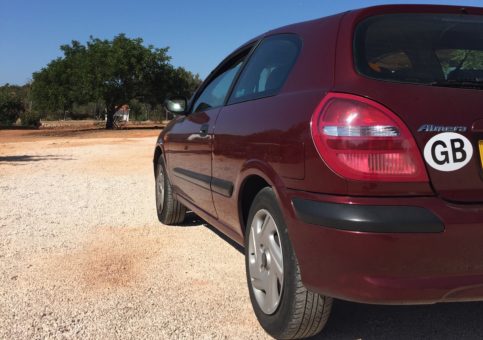
Things like insurance, vehicle tax and fuel will really depend on the car, the way you drive and your car insurance history. Fuel costs varied quite a bit from country to country, Spain was the cheapest at just over £1 per litre, while the Netherlands was the most expensive at closer to £1.30 per litre. We avoided tolls as much as possible, this probably saved us quite a bit of money but cost us more time. Some journeys were twice as long because of this. In Austria, Slovenia and the Czech Republic we had to buy weekly or monthly vignettes so that we could drive on the motorways. Parking wasn’t too expensive and we made good use of Parkopedia to find the cheapest car parks.
We also used a fair bit of public transport when we were staying in big cities. Prague was the cheapest where we got a month’s ticket to use the metro, trams and buses for about £23.50 per person. Amsterdam was the most expensive since we stayed about 20 mins out of the city in Weesp and had to pay about £7 for a day return per person. When our families visited us in Prague and there were four of us, we used Uber quite a bit, which was pretty inexpensive and much more convenient than walking, taking the bus, tram or metro.

Europe activity costs
Mostly all our sightseeing was free, including hiking and wandering around cities. We took ‘free’ walking tours, where you pay a tip rather than a fixed fee, in Amsterdam, Slovenia and Prague, which we paid between €5-7 each for. Our most expensive activities were Neuschwanstein Castle in Germany (definitely worth the cost) and watching a production of A Midsummer Night’s Dream at the Czech National Theatre. *Note that the Lisbon Tourist Card listed below was generously comped to us by Get Your Guide.

Cost to travel Europe – miscellaneous
The only miscellaneous Europe travel costs we had were for some new clothes, as we bought a couple of jumpers and some jeans while we were in Porto.
Total cost to travel Europe for three months
So, can you travel Europe on a budget? The answer’s yes, depending on what you define as budget. We managed to travel around Europe for under £50 per day for two people, which is only £15-20 more than we spent per day in Asia, for instance. We were pleased with all the amazing places we saw and had some incredible experiences, especially at the excellent Christmas markets.

Pin Me For Later!
How do you think we did? Did we travel around Europe on a budget you could use? Let us know what you think of the cost to travel Europe in the comments below.
13 Comments
Gilda Baxter
Wow…I am impressed with how well you have done. Having the car was a good idea since it has given you more freedom and flexibility. Brian and I like the idea of touring Europe in a motor home. Your food costs were very good indeed, cooking your own meals is best. I love eating out, but it can be expensive. I loved your itinerary and visiting these places during the Autumn has probably also further helped to stay in budget? Great post ?
Andrew Wyatt
Thanks Gilda, you’re right, visiting in the off-season probably helped keep some of our costs down too. I hope you and Brian get to travel around Europe in a motor home, that sounds exciting! 🙂
Did you look into buying a left hand drive car for Europe? We have a three month trip in France, Spain and Portugal planned and are thinking of buying a car in France. Not sure how easy it will be to insure though?
Hi Dan, good question, but no we didn’t even think about it. Since we’re from the UK and Amy’s dad works as a mechanic, he had some good connections and made sure our car was reliable too. It would be interesting to know how the car buying process goes for you in France though. Also I’ve driven a right hand drive car in mainland Europe before so I knew that wouldn’t be a problem for me. Enjoy your trip!
Just to update, it proved impossible to buy a car in France as a non-resident so we bought one off eBay in the UK and drove over instead. So far so good, it looks like we are retracing some of your haunts, going towards Porto from Lisbon on Thursday!
Hi Dan, thanks for the update, glad you managed to sort the car issue. Have fun in Portugal, we loved it and are looking forward to returning again in the autumn!
Neil Dimapilis
this is amazing! Thank you for sharing this with us. appreciate you disclosing this kind of information to us. did you bring bills on your trip or just used a card? i read in one article that you should bring less cash on trips to Europe?
Hi, we just used our overseas bank card, which doesn’t charge a fee for withdrawals abroad.
Can you please share list of cities you covered in 3 months?
Hi, we went to Amsterdam, drove down to Portugal, went to Lisbon, Porto and the Algarve. Then we drove up to Slovenia to Ljubljana, made a stop at Neuschwanstein castle in Germany and then stayed in Prague for a month. On the way back we stopped in Cologne and Bruges.
Barato Travels
Great Post and Stunning Pictures. Your tips were very useful for Europe traveler. Europe is an awesome place for roaming. I love Europe. I read your blog and really happy with your information on Europe traveling. Thanks for such post and please keep it up.
Thanks – glad you found it useful!
I loved you budge5 but as 1 person air bnb untenable I ve found I use dorm in hostel and when really tired tiny hotel. I should be like you and buy and prepare food. I also ho to museums and oay entrances. T3nd to book mini trips as asthmatic so cant hike uphill etc. Think will eventually head back to India as best for budget
Save my name, email, and website in this browser for the next time I comment.
This site uses Akismet to reduce spam. Learn how your comment data is processed .
- Today's news
- Reviews and deals
- Climate change
- 2024 election
- Fall allergies
- Health news
- Mental health
- Sexual health
- Family health
- So mini ways
- Unapologetically
- Buying guides
Entertainment
- How to Watch
- My Portfolio
- Latest News
- Stock Market
- Premium News
- Biden Economy
- EV Deep Dive
- Stocks: Most Actives
- Stocks: Gainers
- Stocks: Losers
- Trending Tickers
- World Indices
- US Treasury Bonds
- Top Mutual Funds
- Highest Open Interest
- Highest Implied Volatility
- Stock Comparison
- Advanced Charts
- Currency Converter
- Basic Materials
- Communication Services
- Consumer Cyclical
- Consumer Defensive
- Financial Services
- Industrials
- Real Estate
- Mutual Funds
- Credit cards
- Balance Transfer Cards
- Cash-back Cards
- Rewards Cards
- Travel Cards
- Personal Loans
- Student Loans
- Car Insurance
- Morning Brief
- Market Domination
- Market Domination Overtime
- Opening Bid
- Stocks in Translation
- Lead This Way
- Good Buy or Goodbye?
- Fantasy football
- Pro Pick 'Em
- College Pick 'Em
- Fantasy baseball
- Fantasy hockey
- Fantasy basketball
- Download the app
- Daily fantasy
- Scores and schedules
- GameChannel
- World Baseball Classic
- Premier League
- CONCACAF League
- Champions League
- Motorsports
- Horse racing
- Newsletters
New on Yahoo
- Privacy Dashboard
Yahoo Finance
15 cheapest european countries to visit in 2024.
This article looks at the 15 cheapest European countries to visit in 2024. If you wish to skip our detailed analysis of Tourism in Europe and ways to budget your vacation, you may skip ahead to 5 Cheapest European Countries to Visit in 2024 .
Tourism in Europe
Europe is by far the most popular tourist destination among all continents. According to UNWTO , in 2023, 54% of the world's international tourist arrivals were in Europe, with the southern/Mediterranean region being the most visited destination. Europe is extremely appealing for tourists due to its friendly visa policies, a diverse range of destinations, and the fact that it is considered safer than other global destinations.
Like most of the world, tourism in Europe has still not managed to recover to pre-pandemic volumes. In 2023, Europe had 700 million tourist arrivals across the continent, which was 94% of the arrivals witnessed in 2019. This is despite the fact that many southern European and Mediterranean destinations have surpassed pre-COVID levels of tourism. The European Travel Commission reports that countries such as Serbia, Portugal, and Montenegro all hosted 10% more tourists in 2023 than they had in 2019. In comparison, 65% of destinations in Europe are still falling short of pre-pandemic volumes. The most sluggish recovery has been witnessed in the Baltic States of Estonia, Latvia, and Lithuania, each of which has failed to attain even 75% of pre-COVID tourist arrivals. This stark disparity in the recovery of tourism across the continent poses a challenge. Despite the enormous volume of tourists that fly over to Europe each year, many of its most exquisite locations continue to be dejected in favor of hotspots such as the beaches of Ibiza, the bustling streets of Paris, or the canals of Venice. Owing to such a rapid inflow of tourists into only a handful of destinations, the sustainability of tourism in Europe falls under threat. Recently, more and more vacationers are becoming critical of tourist hotspots, criticizing them for being “tourist traps” and are instead looking to venture towards less crowded destinations. Another factor that unsettles tourists is the rate of inflation witnessed in post-pandemic tourism. According to Allianz Research , the daily rate for a hotel room (global median) jumped to $212 in the first quarter of 2023, up from $156 in Q1 2022 and $129 in Q1 2021. Moreover, a recent survey by Travel Weekly showed that 87% of European travelers are taking measures to reduce costs in their vacations. This includes opting for cheaper accommodations, reducing the budget used on excursions, and switching towards more affordable destinations.
As more and more tourists become irked by the overcrowded and inflated vacation experiences in particular hotspots, it is possible that tourists in 2024 will set their sights on destinations offering budget-friendly vacations with similar itineraries. With websites such as Airbnb, Inc. (NASDAQ: ABNB ), Booking Holdings Inc. (NASDAQ: BKNG ), and Sun Life Financial, Inc. (NYSE: SLF ), tourists have the opportunity to map out their entire vacations at the most affordable prices, exploring new and exciting destinations in the process.
Budgeting your trip
Some would argue that the true beauty of Europe lies in destinations that have been spared from the tirade of excessive tourist inflows. In the past, there were either no avenues for the common tourist to arrange a vacation to such areas, or they would be considered as being unreliable, unsafe, and unfit for tourists. However, over the last decade, this perception has shifted as people have access to more and more avenues to plan trips to some of the most remote recesses of the world.
Websites like Booking, property of Booking Holdings Inc. (NASDAQ: BKNG), and Budget Your Trip provide data for locations, resorts, and excursions. This enables previously unknown tourist spots all over Europe to market themselves without investing the same level of resources as world-renowned hoteling brands. Tourists can use Booking Holdings Inc. (NASDAQ: BKNG) and similar services to break down each leg of their trips into exact monetary terms, without being beguiled by the fame of prominent destinations.
Similarly, Airbnb, Inc. (NASDAQ: ABNB) is the world's largest platform for alternative accommodation. Alternative accommodation is a relatively new manner of lodging that involves living in rented apartments, hostels, or even a spare guestroom. In comparison to hotels, such accommodation is cheaper and can be found in rural travel destinations as well. In providing this service, Airbnb, Inc. (NASDAQ: ABNB) has diverted a large number of tourists away from saturated hot-spots towards less crowded communities.
If you’re looking to visit a cheap European country in 2024, you may also consider obtaining travel insurance such as the packages offered by Sun Life Financial, Inc. (NYSE: SLF). These cover medical treatment and hospitalization bills in the unfortunate circumstance that you or a family member fall ill. Obtaining insurance from companies such as Sun Life Financial, Inc. (NYSE: SLF) allows you to venture into the wild and vivaciously enjoy your vacation.
Methodology
To develop our list of 15 cheapest European countries to visit in 2024, we traversed through similarly recommended lists on the web to develop a shortlist of budget-friendly countries. For these countries, we used Google Flights to obtain data on the cheapest available flight from the US (using JFK as the reference point for departures). Moreover, we used Budgetyourtrip to obtain the average amount required to spend a week-long couple’s vacation in each country. Accumulating these data points allowed us to calculate the total expected amount required on a trip to each country. Each country was ranked in ascending order with respect to this metric, and the top 15 countries were selected as the cheapest European countries to visit in 2024.
By the way, Insider Monkey is an investing website that tracks the movements of corporate insiders and hedge funds. By using a similar consensus approach, we identify the best stock picks of more than 900 hedge funds investing in US stocks. The top 10 consensus stock picks of hedge funds outperformed the S&P 500 Index by more than 140 percentage points over the last 10 years ( see the details here ). Whether you are a beginner investor or a professional one looking for the best stocks to buy, you can benefit from the wisdom of hedge funds and corporate insiders.
Here are 15 Cheapest European Countries to Visit in 2024.
Cheapest Return Ticket: $1011
Average expense during stay: $1722
Total cost: $2733
Latvia has a number of beautiful beaches along the Baltic sea, while the capital city of Riga features prominent Art Nouveau architecture. There are many historical castles present in towns across the country. Thus, there is plenty to enjoy in a week-long trip, all for the low price of $2,733.
14. Estonia
Cheapest Return Ticket: $941
Average expense during stay: $1544
Total cost: $2485
Another Baltic state, Estonia is one of the cheapest European countries to visit . It offers a blend of scenic landscapes, diverse wildlife, and Soviet era landmarks. The Lennusadam Museum in the capital city of Tallinn is an excellent starting point if you wish to be accustomed to the rich Estonian culture.
13. North Macedonia
Cheapest Return Ticket: $1083
Average expense during stay: $1388
Total cost: $2471
If you’re looking for a location that offers picturesque scenery whilst not requiring you to take on a second mortgage on your house, forget the shores of Madeira and journey east to the country of North Macedonia. You’ll get the chance to explore one of Europe’s deepest lakes and some of its most stunning peaks, along with the historically rich city of Ohrid.
12. Croatia
Cheapest Return Ticket: $868
Average expense during stay: $1436
Total cost: $2304
Croatia makes for a very cheap vacation that also offers the chance to explore roman heritage, mesmerizing coasts, and modern attractions. Zagreb is becoming an increasingly popular tourist spot; however, it is still a very affordable destination where you can enjoy museums, festivals, and vibrant street life. The city of Split offers a chance to visit the iconic Diocletian Palace and venture off to one of the country’s various islands within the Adriatic Sea.
11. Czech Republic
Cheapest Return Ticket: $741
Average expense during stay: $1548
Total cost: $2289
Whilst the capital city of Prague is famous for its State Opera theater and other orchestras, the rest of the country sees far and few tourists. Czech Republic is an amazing destination for adventure travel, with places like the Bohemian Switzerland National Park and the caverns of Moravian Karst. Moreover, if you steer clear of certain excursions in the capital, there are plenty of ways to immerse yourself in the local culture at an affordable cost.
10. Lithuania
Cheapest Return Ticket: $872
Average expense during stay: $1393
Total cost: $2265
Lithuania is the cheapest European country to visit in the Baltics. In just $2,265, you and your partner can entertain yourself to a comprehensive getaway. Your itinerary can include museums, Baroque monuments, serene national parks, and pristine beaches.
Cheapest Return Ticket: $1765
Average expense during stay: $461
Total cost: $2226
If you have managed to rack up some airline miles, Georgia is one of the cheapest European countries to visit in 2024 . With an average expense on transport, accommodation, and food of just $461 a week for 2 people, the foothills of the Caucasus mountains are the perfect place to enjoy a budget friendly European vacation.
Cheapest Return Ticket: $1018
Average expense during stay: $1170
Total cost: $2188
Budapest is regarded as being one of the most beautiful capital cities in the world. Sprawling on either side of the Danube River, it features a sea of Gothic, Romanesque, and Art Nouveau architecture. One of the country’s unique features is that it contains over 1,300 thermal springs, many of which are now used to operate year-round spas and baths all over the nation.
Cheapest Return Ticket: $1727
Average expense during stay: $398
Total cost: $2125
Until mid-2023, the US Travel Advisory had classified a visit to Armenia under the Level 4 category. However, barring a few locations bordering Azerbaijan, the country has been deescalated to Level 2. Since tourists are still acclimatizing to this change, Armenia happens to be one of the cheapest European countries to visit in 2024.
6. Bosnia & Herzegovina
Cheapest Return Ticket: $1079
Average expense during stay: $1040
Total cost: $2119
If you’re looking for a destination with historical significance, Bosnia & Herzegovina happens to be the most underrated destinations in the world. Featuring monuments and shrines from the second world war, the cold war, and the Bosnian war, it is one of the most insightful vacation spots in the world. In terms of scenery, a day trip to the Kravice Falls is a common part of any traveler’s itinerary.
Click to continue reading and see the 5 Cheapest European Countries to Visit in 2024 .
Suggested Articles:
20 Most Underrated Travel Destinations in Asia
15 Best Places To Retire In Arkansas
15 Worst Places in Texas for a Couple to Live on Only a Social Security
Disclosure: none. 15 Cheapest European Countries to Visit in 2024 is originally published on Insider Monkey.
We've detected unusual activity from your computer network
To continue, please click the box below to let us know you're not a robot.
Why did this happen?
Please make sure your browser supports JavaScript and cookies and that you are not blocking them from loading. For more information you can review our Terms of Service and Cookie Policy .
For inquiries related to this message please contact our support team and provide the reference ID below.

How to Travel Through Europe by Train Like a Pro
Last Updated on June 8, 2023
Traveling through Europe by train is a wonderful experience that offers a unique and authentic way to explore the continent. It is a cost-effective and sustainable way to travel that gives you a chance to see the breathtaking scenery of Europe.
However, train travel can also be overwhelming for first-timers. That’s why we’ve put together this guide on traveling through Europe by train like a pro.
Make an Itinerary
The first step to traveling through Europe by train like a pro is to plan ahead. Research your destinations and create a rough itinerary of the places you want to visit, as well as the duration of your stay. You can use websites such as Rail Europe or Eurail to plan your train journeys and book tickets in advance. This can save you money, time, and heartache on your adventure!
Buy a Rail Pass
If you plan to take multiple train journeys during your trip, buying a rail pass is worth considering. A rail pass allows you to travel on most trains in Europe without purchasing individual tickets for each journey. Different types of rail passes are available, depending on the length of your trip and the countries you want to visit.
Utilize Nearby Luggage Storage
When traveling through Europe by train, you may find yourself in a situation where you need to store your luggage temporarily. This can happen if you arrive at your destination before your hotel check-in time or want to explore a city without carrying heavy bags.
Fortunately, many train stations in Europe offer luggage storage facilities. For example, if you’re spending the day in St. Pancras, simply look for luggage storage in St. Pancras . Now, you can explore the city with peace of mind — and no heavy bags weighing you down.
Choose Your Train
When traveling through Europe by train , you can take high-speed trains, regional trains, or overnight trains. High-speed trains, such as the Eurostar or TGV, are faster and more expensive than regional trains. However, they are a smart option for longer journeys or days you want to travel between two distant cities in a short amount of time.
Regional trains, on the other hand, are slower but cheaper. They are an option if you want to explore smaller towns and villages along your route. Overnight trains, such as the Nightjet, allow you to save time and money by combining transportation and accommodation.
One of the advantages of traveling through Europe by train is the ability to easily move from one place to another. However, this can be difficult if you are carrying a heavy suitcase. Therefore, it is important to pack light and only bring the essentials. A backpack or a small suitcase is ideal for train travel.
Arrive Early
You should arrive at the train station at least 30 minutes before your train departure time. This allows you to find your platform, check the train timetable, and board the train stress-free. After all, when a train says it leaves at 10:00, you best believe it’ll be on the move promptly at 10:00.
Additionally, arriving early can give you time to grab a coffee or a snack from one of the many cafes at the train station.
Validate Your Ticket
If you have purchased individual train tickets, don’t forget to validate them before boarding the train. You can do this at the yellow validation machines located at the train station. Failure to validate your ticket can result in a fine if you are caught by a ticket inspector on the train.
Keep Your Ticket Handy
Once you have boarded the train, it is important to keep your ticket handy. Ticket inspectors may ask to see your ticket any time during the journey, so it is best to have it easily accessible. Additionally, some trains have a designated area for luggage storage, so be sure to keep your bags in the appropriate area.
Bring Your Own Food
While some trains have dining cars or food carts, it is always a good idea to bring your own food and snacks for the journey. This can save you money and ensure that you have something to eat if the train has no food options or limited options.
Enjoy the Scenery
Last but not least, one of the most important things to remember when traveling through Europe by train is to take the time to enjoy the scenery. Europe is home to some of the world’s most beautiful landscapes and architecture, and traveling by train allows you to see it all from a unique perspective.
Happy Travels!
Traveling through Europe by train is a fantastic experience that offers a unique and authentic way to explore the continent. With these tips, you can travel like a pro and make the most of your journey. Remember to plan ahead, pack light, and most importantly, enjoy the beautiful scenery along the way.
Related posts:
- Why you should travel by train in Europe (and how to book tickets)
- Exploring France by train: Our top five train rides in France
- How to Travel around Europe on the Cheap
- Things to Know Before You Board a Train from Vienna to Prague

- Weird But True
- Sex & Relationships
- Viral Trends
- Human Interest
- Fashion & Beauty
- Food & Drink
trending now in Lifestyle

Zoogoers outraged to discover 'panda' exhibit was actually dogs...

Meet Mona Patel, the mystery tech tycoon who 'stole' the Met Gala...

Dear Abby: My husband told me to find a sex buddy to fulfill my...

My Amazon package was stolen— what happened next was a total...

Why so many celebs were moist and nearly naked at the Met on...

I'm a mom who breastfed my husband — now we want a fourth child...

US expat tries out bizarre Aussie supermarket dating trend

Tyla's Met Gala gown made of sand had to be destroyed at the end...
Here is the cheapest time to travel to europe’s pricey and popular cities.
- View Author Archive
- Email the Author
- Get author RSS feed
Contact The Author
Thanks for contacting us. We've received your submission.
Thanks for contacting us. We've received your submission.

Come summer, travel to Europe will be top of mind for plenty of Americans with vacation on the brain.
But can we afford it? Summers especially can be crowded, hot and packed with tourists driving up rates as locals flee for the countryside and beaches — not really the best time to be visiting.
Plus, this year, there’s an extra level of expense added, with the 2024 Olympics taking Paris for the months of July and August.

And that won’t just impact Paris, but all the destinations like the French wine regions, the Cote d’Azur and even London and Brussels and Amsterdam — all easily accessible by rail and likely to receive plenty of extra visitors.
So you might still be going — but you might be going before or after the summer, this time around. And according to a new study , that’s totally fine.
For example, did you know that Paris can be a pretty good deal, as long as you’re not insisting on the peak travel periods?
The number crunchers at Radical Storage urge travelers not looking to go into heavy debt to select the shoulder season, when visitors can save a whopping average of 60.3% on their hotel stays, one of biggest budget busters on a Paris itinerary, where peak season nightly rates averaged $866.
Wait until shoulder season and see those same rates plummet to $344, the research revealed. That’s a discount of $522.
Shoulder seasons can vary by destination, but are by definition the times between peak and off-peak. And, most importantly, unlike during low season, the weather isn’t terrible. (If you’ve spent a winter in Paris, you know that’s an issue.)

“Shoulder season is the period before or after peak season but not yet the off-season. For example, many European destinations have a very busy summer (July/August) but May, June, September, and October may be considered shoulder season (it varies per destination), while January could be considered the off-season or low season,” the study stated.
“Visiting destinations in shoulder season usually means lower costs and lower crowds, while still keeping good enough weather for tourism.”
To find the best times to travel to Europe, the study pored over data from Google Flights and prices for thousands of hotels. Besides beaucoup bargain boltholes in Paris, they also found that flights to Budapest in the off-season sank to 56.6% of peak season highs, Thrillist reported .
And while Budapest had the best drop in prices, it was far from the best deal, overall — peak pricing for cities like Stockholm from the States averaged about $778, according to the study, and $537 during shoulder season — a drop of 30.9 percent.
As part of the study’s findings, the authors compiled a list of the best shoulder season month to visit a selection of cities around the world. Here are their picks for many of Europe’s most popular destinations.
The cheapest time of year to visit these European cities
- Athens – April
- Barcelona – April
- Brussels – April
- Copenhagen – April
- Florence – April
- Frankfurt – April
- Milan – April
- Munich – April
- Prague – April
- Venice – April
- Vienna – April
- Berlin – May
- Edinburgh – May
- Madrid – September
- Nice – September
- Amsterdam – October
- Budapest – October
- Dublin – October
- Lisbon – October
- London – October
- Paris – October
- Stockholm – October
- Zurich – October
- Rome – November
Share this article:

Advertisement
UK Edition Change
- UK Politics
- News Videos
- Paris 2024 Olympics
- Rugby Union
- Sport Videos
- John Rentoul
- Mary Dejevsky
- Andrew Grice
- Sean O’Grady
- Photography
- Theatre & Dance
- Culture Videos
- Fitness & Wellbeing
- Food & Drink
- Health & Families
- Royal Family
- Electric Vehicles
- Car Insurance Deals
- Lifestyle Videos
- UK Hotel Reviews
- News & Advice
- Simon Calder
- Australia & New Zealand
- South America
- C. America & Caribbean
- Middle East
- Politics Explained
- News Analysis
- Today’s Edition
- Home & Garden
- Broadband deals
- Fashion & Beauty
- Travel & Outdoors
- Sports & Fitness
- Sustainable Living
- Climate Videos
- Solar Panels
- Behind The Headlines
- On The Ground
- Decomplicated
- You Ask The Questions
- Binge Watch
- Travel Smart
- Watch on your TV
- Crosswords & Puzzles
- Most Commented
- Newsletters
- Ask Me Anything
- Virtual Events
- Betting Sites
- Online Casinos
- Wine Offers
Thank you for registering
Please refresh the page or navigate to another page on the site to be automatically logged in Please refresh your browser to be logged in
An underwater tunnel could connect Europe to Africa by 2030 – at a cost of a £5.1bn
Crossing aims to open in time for morocco, portugal and spain to host the fifa world cup – but regular seismic activity poses a risk, article bookmarked.
Find your bookmarks in your Independent Premium section, under my profile
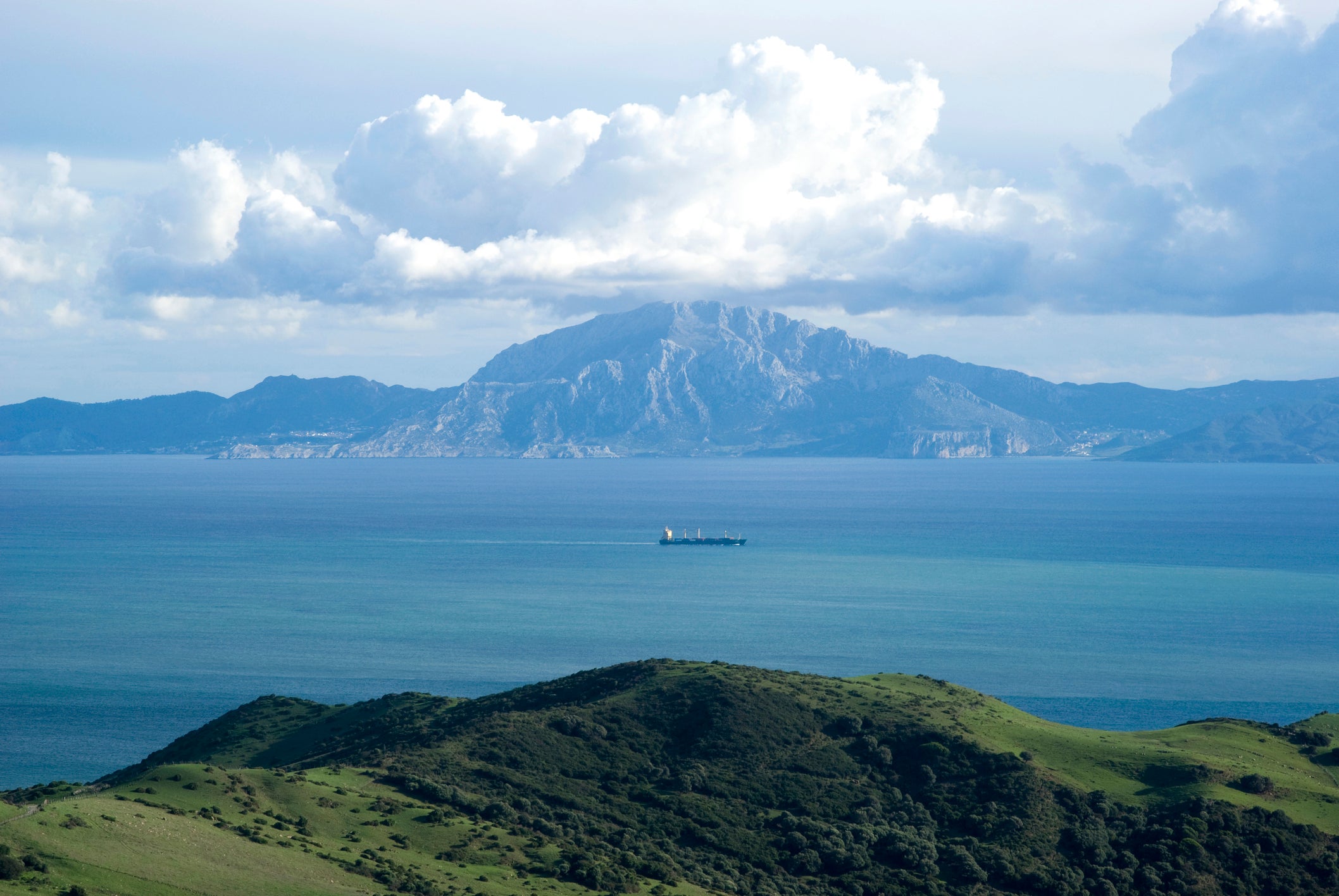
Sign up to Simon Calder’s free travel email for expert advice and money-saving discounts
Get simon calder’s travel email, thanks for signing up to the simon calder’s travel email.
A new 17-mile underwater tunnel could link Europe ’s high-speed rail network to North Africa by 2030 – if a €6bn proposal goes ahead.
The tunnel would introduce a high-speed train service by connecting Spain ’s existing rail lines to Morocco’ s 200mph Al Boraq route that opened in 2018.
A route departing Madrid , Spain, for Casablanca, Morocco, would travel via Algeciras and Tangier and pass under the Strait of Gibraltar.
While an average flight from Madrid to Casablanca clocks in at one hour and 50 minutes, the full train journey would reportedly take travellers five hours and 30 minutes to switch continents.
Now strategic planning is underway, developers hope the tunnel could open in just six years, in time for the three countries – Spain, Portugal and Morocco – to host the 2030 Fifa World Cup.
It is estimated that the project would cost north of €6 billion (£5.1 billion) to construct, although official costs are unknown.
The Spanish government confirmed €2.3 million (£2 million) EU feasibility funding to study the ‘ Europe-Africa Gibraltar strait fixed link ’ just last June.
At the time, Spain’s transport minister, Raquel Sanchez, said: “We are going to give impetus to the studies of a project of maximum geostrategic importance for our countries and for relations between Europe and Africa,
“We are beginning a new stage in the revival of the fixed link project across the Strait of Gibraltar, which we launched in 1981, hand in hand.”
The revived project was first seriously proposed over 40 years ago, in 1979, and could resemble the Channel Tunnel between Dover and Calais.
Surveys of the area by the Moroccan National Company for Strait Studies (SNED) and the Spanish Society for Fixed Communication Studies across the Strait of Gibraltar (SECEGSA) have also revealed several logistical challenges.
At its deepest, the strait dives 2,950ft (900m) down and regular seismic activity on the Azores–Gibraltar geologic fault presents an additional risk.
According to SECEGSA, over 12.8 million passengers per year could benefit from the crossing as well as an increase in trade of 13 million tons of cargo between the two continents if the tunnel is successful.
Join our commenting forum
Join thought-provoking conversations, follow other Independent readers and see their replies
Subscribe to Independent Premium to bookmark this article
Want to bookmark your favourite articles and stories to read or reference later? Start your Independent Premium subscription today.
New to The Independent?
Or if you would prefer:
Want an ad-free experience?
Hi {{indy.fullName}}
- My Independent Premium
- Account details
- Help centre

IMAGES
VIDEO
COMMENTS
Here are the travel cost rankings of the countries in Europe, ordered from most expensive to least expensive. The travel prices for each country come from actual travelers, and are listed as per person, per day. Now you can find out which countries are the cheapest to visit, and which are the most expensive for travel.
Average Trip to Europe Cost in 2024. An average seven-day vacation in Europe costs close to $1,800. This can be broken down as follows: Average Accommodation Cost: $455. Average Flight Cost: $750. Food, Drinks & Activities: $378. Transportation: $200. Total Cost: $1,783.
More insights into how I travel full-time and what it costs to live and travel in Europe. First, though, let's talk about travel styles… Luna sporting bedhead in Gozo, Malta. What full-time travel looks like for me. First, it's important to say that there's no right or wrong way to travel full time. There's no standard.
Backpacking Europe Suggested Budgets. Prices for travel in Europe vary greatly depending on how far north, east, south, or west you travel. If you stick to the budget accommodations, food, and tours listed here and use all my tips on saving money, you need about 65-110 EUR per day in Western Europe, 40-50 EUR in Eastern Europe, and about 85-130 EUR in Scandinavia.
Cost of Coach/Bus Travel In Europe. Taking long-distance buses is probably the cheapest way to travel in Europe but it's also the slowest and arguably the most uncomfortable. Personally, I won't even consider the bus if the trip is more than a few hours as 8 hours on a bus sounds terrible. Either way, I use Omio to find and book bus tickets.
How much does a trip to Europe cost? Learn more about Europe tour budget, cheapest and most expensive destinations to travel.
You may also want to budget some money for souvenirs and travel insurance. Total Trip to Europe Cost. A seven-night trip to Europe for two people will cost an average of $7,900, or $564 per person, per day. Category: Expense: Airfare: $2,000: Accommodations: $2,050: Transportation $ 800: Tours & activities: $1,000: Food:
Below are the budget ranges you should allocate for food, guided tours and accommodation. You can also check out our 3 weeks in France, Italy, and Spain itinerary. food budget per day: $20. guided tours cost per day: $15-$30. accommodation cost per day: $25-$45 as a backpacker or $70+ for mid-range.
Pack Light & Save On Checked-Bag Fees: Almost every budget airline within Europe will charge a hefty fee ($30-$60) for checking a bag so you'll save a lot by flying with a carry-on only. However, the weight of a carry-on bag is usually limited to around 20 lbs — which can be difficult for a lot of people.
The average cost for museums and galleries around Europe is 10-20 Euros. Day tours are around 100 Euros, but lots of stuff is free as well. We'll put an average spend of attractions at 20 Euros, to account for the cheaper and the more expensive options. Keep in mind, this is just an estimate.
If you choose to stay in only one city, bus or train rides are very cheap, ranging from 1 to 3 euros. You can also buy 24 to 72 hour passes. If you choose intercity travel, average prices are: From Lisbon to Madrid: 16 euros; From Madrid to Rome: 26 euros; From Rome to Paris: 23 euros; From Paris to London: 38 euros.
Total Amount Spent. How much a 2 week trip to Europe costs including accommodations & round-trip flights: $3048.02 per person. I hope this answers your questions about how much does a trip to Europe cost. Although these prices can change drastically, this gives you a good idea of how much things will cost.
But, a good estimate is about $4,280. One time I spent just $2,300 because I focused on doing it for as cheap as possible. Another time I spent closer to $8,000 (for two people) when visiting just three cities. The cost of a Europe trip depends on you, but it's not hard to stretch your travel budget.
Food: $515. Transportation: $58. Flights: $6. TOTAL: $888. Prior to my trip, I had two main travel gear expenses- my new all-time favorite travel backpack, the Osprey Aura 65, and some Europe-appropriate clothing that I was lacking (dresses, light jackets, shorts, etc.) My 3-month journey abroad began in New York.
Nov 6, 2023. One-Month Europe Trip on a Budget: A Full Itinerary and Cost breakdown. This guide includes my full itinerary and cost breakdown for accommodations and transportation between cities. It also contains things to do and where to stay in London, Paris, Ghent, Bruges, Barcelona, Seville, Granada, Cordoba, and Madrid.
Serbia. Daily cost: €18.75. Serbia is the most affordable country on a day-to-day cost analysis. If you are carefully considering travel costs in Europe, Serbia is a great option for budget travellers. Belgrade is a surprising city with so much to offer visitors and I can highly recommend it!
From AU$1,680^ per person. 7 nights in Paris, 7 nights in Barcelona, 7 nights in Rome and 7 nights in Athens (in budget accommodation) Public Transport. AU$450. For a youth, 2nd class ticket that allows travel on 5 days within 1 month, for 5 European countries of more. Total.
2. Hopping around Europe Cheaply with budget airlines. One of the most popular (and cheapest) ways to travel Europe is through budget airlines. Unlike North America, Europe is crawling with budget airlines that can take you from Point A to Point B at ludicrously low costs. Sometimes even cheaper than the bus!
For every expensive city, there are dozens of charming — and surprisingly affordable — places that offer all the European charm for a fraction of the price. Ljubljana, Porto, Budapest, even ...
Flights to Belgium, Europe. $524. Flights to Bosnia and Herzegovina, Europe. $520. Flights to Bulgaria, Europe. View more. Find flights to Europe from $135. Fly from the United States on Norse Atlantic Airways, Norse Atlantic UK, British Airways and more. Search for Europe flights on KAYAK now to find the best deal.
Total cost to travel Europe for three months. So, can you travel Europe on a budget? The answer's yes, depending on what you define as budget. We managed to travel around Europe for under £50 per day for two people, which is only £15-20 more than we spent per day in Asia, for instance.
This article looks at the 15 cheapest European countries to visit in 2024. If you wish to skip our detailed analysis of Tourism in Europe and ways to budget your vacation, you may skip ahead to 5 ...
Europe for Less Our 2024 special report is filled with 27 trip ideas to make your vacation budget go further—without sacrificing luxury. May 3, 2024, 10:00 AM UTC
It is a cost-effective and sustainable way to travel that gives you a chance to see the breathtaking scenery of Europe. However, train travel can also be overwhelming for first-timers.
Here is the cheapest time to travel to Europe's pricey and popular cities By ... "Visiting destinations in shoulder season usually means lower costs and lower crowds, while still keeping good ...
Image Credit and Location: Deep Sleep Hotel, Wales, UK. 5. Deep Sleep Hotel, Wales, UK. The Deep Sleep Hotel in Wales is the closest you can get to being a modern-day Indiana Jones. Located 1,375 feet (419 meters) underground in an abandoned Victorian slate mine, it's the deepest hotel on the planet.
A new 17-mile underwater tunnel could link Europe's high-speed rail network to North Africa by 2030 - if a €6bn proposal goes ahead. The tunnel would introduce a high-speed train service by ...
The narrow-body aircrafts from the Airbus A320 family the company uses are relatively sustainable - as far as air travel goes - as well as more fuel efficient than the average craft.. Making ...